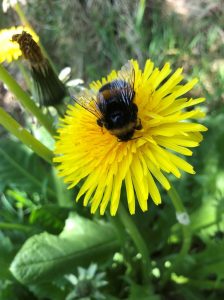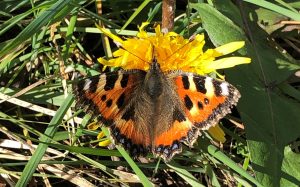Heritage Happenings
Welcome to Heritage Happenings, a daily series of little snippets to stimulate curiosity for your local place during this time of social distancing and cocooning.
On your 2km radius walk each day, keep an eye out for things you never noticed before. It might be a flower in a hedge, a tree, an unusual postal box, an iron gate, building, monument, butterfly or even a placename.
If you want to know more about it, send us a direct message or post it to this page and we will try to help you.
Likewise, if you are cocooning at home, we hope this page will provide you with a little diversion. Please feel free to send us your observations about the topics as we go along. We’d love to hear from you.
From Shirley, Your County Heritage Officer.
Day 1 – Primrose
At the moment, the hedges and ditches of Monaghan are erupting with pale yellow flowers, custardy smooth on the main petals with a golden colour to the centre. These are primroses, or in Irish Sabhaircín, and the latin primula means first flower. They are typically a deciduous woodland and hedgerow plant, as they like the earthen banks and the dappled shade.
Folk maintained that they bloomed in Tír na nόg, and that if you visited this place of eternal youth, especially out of season, that you would bring back a bunch as proof of your visit.
It was traditionally considered to a protector of the home and the farm. Its medicinal properties medicinal included as a cure for jaundice, the flowers boiled in milk and drank each morning. It was also rubbed on cow’s udders to encourage them to produce milk. On May eve, it was used to protect against evil influences and fairies and was laid on doorsteps or windowsills.
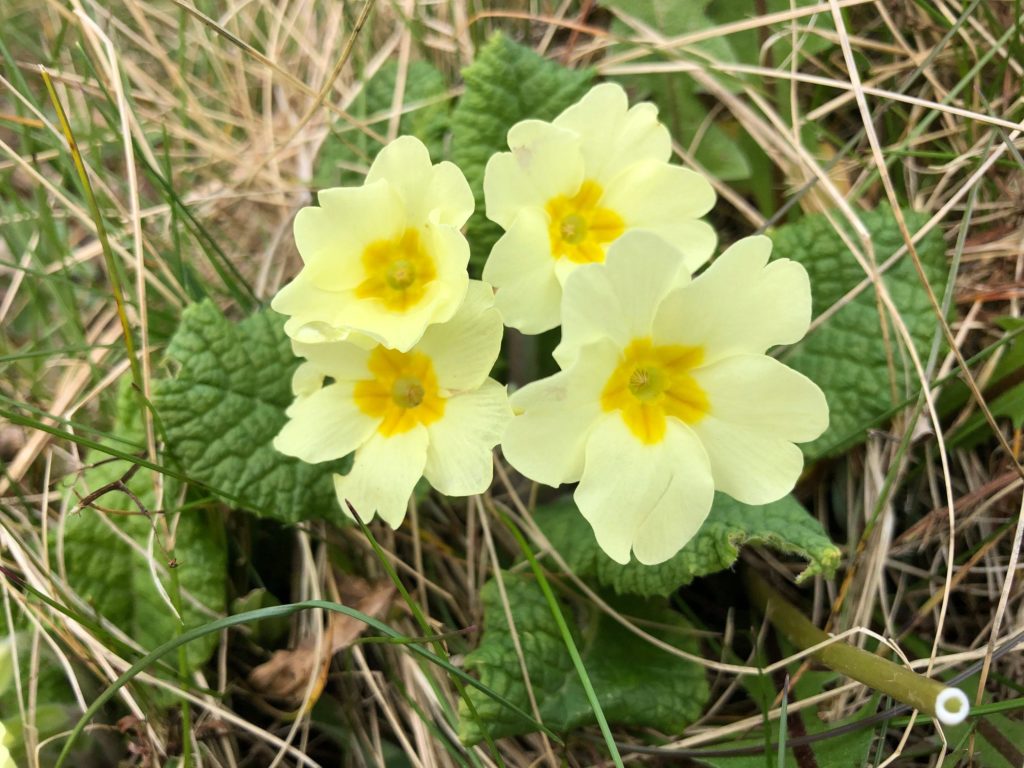
Day 2- Blackthorn
It’s coming into flower now, tiny white flowers in profusion on the blackish branches amongst the very sharp long thorns. Blackthorn is a very useful shrub or tree for pollinators as it comes into bloom so early in the season, and later in the year it will produce sloe-berries. Some people painstakingly gather these, prick them, cover them in sugar and gin and make sloe gin. Blackthorn can send out suckers and can spread quite easily, colonising areas that are not cultivated and as a result are good at establishing areas of scrub and young woodland.
In Knockatallon, I was asked “are you cutting your stick” – in other words – was I leaving? Indeed, I was, but I did not cut myself a blackthorn walking stick, sure that is a skill in itself. I understand that those who know about these things keep an eye out for good straight sticks as they grow over a few years, so that they can select the best. These sticks were considered useful to keep fairies away during the night.
In Irish, blackthorn is called Draigheann. In Latin, it is Prunus Spinosa, very much sounding like a spell that would be cast in Harry Potter.
If you were turned into a blackthorn, you would feel very prickly indeed.
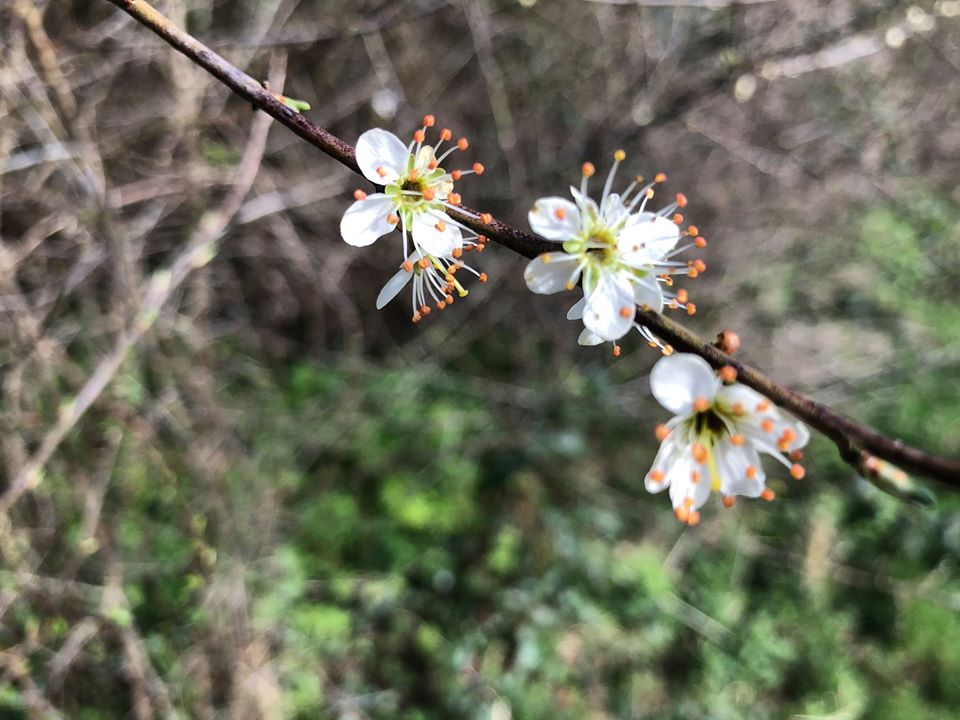
Day 3-Flat-bar gates
Made in forges by local blacksmiths, these pleasing farm or pedestrian gates are made by stretching and hammering red-hot rolled iron on the anvil. An anvil is a large heavy piece of cast or forged iron with a flat top.
At one time, every local area had a forge, with a hot fire and bellows for pumping in air to keep the embers red. These forges provided a good livelihood for a skilled blacksmith and often an apprentice, who made their own tools for working, and tools for others in the community – farming tools, gates, cranes for kitchen hearths, pots for cooking, shoes for horses. The forges were the very centre of the community, real centres of alchemy. Indeed, blacksmiths were often said to have cures, but more of that in another Heritage Happenings.
A flat-bar gate is made by striking flattened iron, forged together with rivets and often decorated at by pinching the iron into little shapes at the tip of each piece. The latch, a very functional part of the gate, was often decorated with quite a flourish, each blacksmith having his own preferred design. Some gates even have extra little levers so you could open the gate from the top without dismounting from your horse. On the slam bar, which is the piece where it closes you can often find the name of the blacksmith stamped in the iron while it was still hot. A small advertisement at the time and valuable piece of history now. The gates probably sound out a “right clatter” when closing still.
If you are out and about, you might find some nice examples of these gates, why not have a fresh look at them. These gates are irreplaceable and can still be repaired by a few skilled blacksmiths.
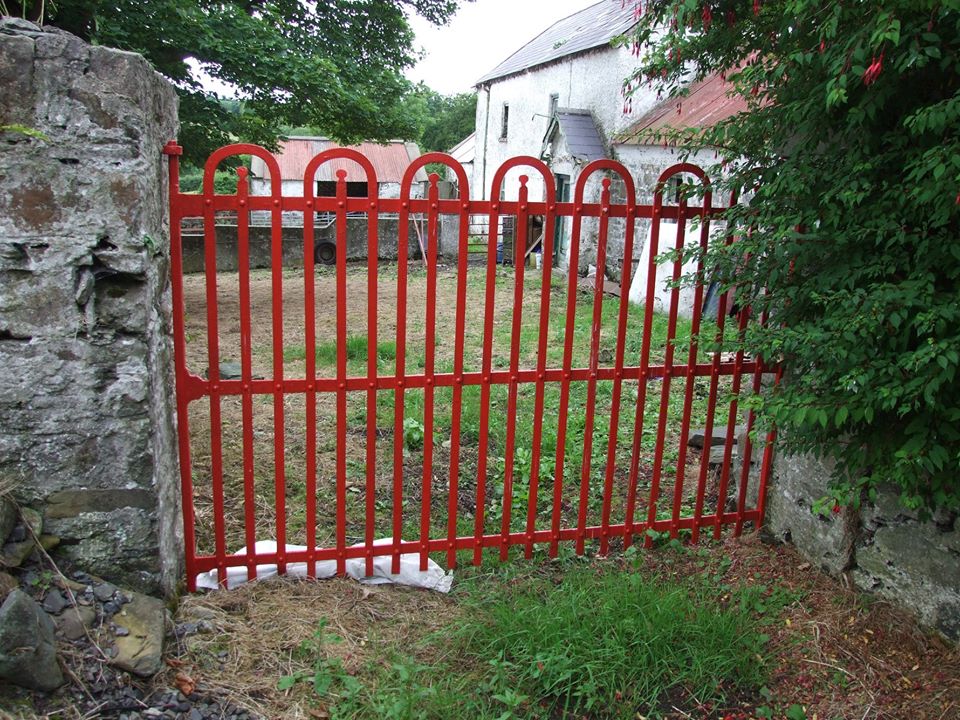
Day 4-Wood anemone
These are woodland flowers and are a rather beautiful clue that an ancient woodland was once in the location where they are now found. Ancient woodland is woodland that existed from before about the year 1700. It flowers early in the year before the woodland canopy closes, so you will hopefully see it. Anemones form lovely drifts on the woodland floor or under hedges.
Wood anemones spread vegetatively, they creep along – only 6ft every 100 years. So gorgeous, their carpets of fresh green divided leaves have white nodding heads of flowers in the morning, cupped close. Then as the six petals open to track the sun during the day, they are like bright snow stars amongst the green.
The word anemone comes from the Greek word for the god of the wind, the Irish for wood anemone is Lus na Gaoithe (herb of the wind), and scientific name is Anemone nemorosa.
The photograph of wood anemone shown here is from the townland of Kilcran, a placename that has been interpreted in two ways, both mentioning trees. Coill Chrann – the wood of the trees or Cill Crann which means Church of the trees. Either way, it’s placename tells us that there has been a woodland here for many centuries, which is a very satisfying thought indeed.
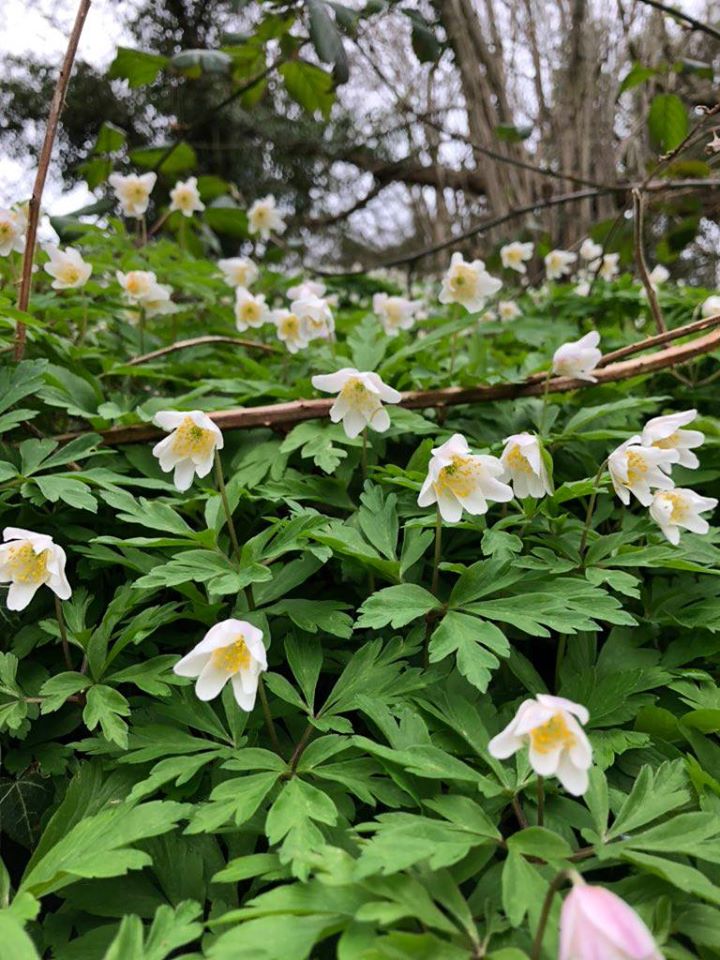
Day 5-Blue tit
You will probably be familiar with these little busy birds, strikingly turquoise blue and yellow, always flitting around. Blue tits are common in most habitats, gardens, parks, hedges and woodland.
In Irish it is Meantán gorm (gorm means blue). it has a dark stripe running from its beak around its eyes like a striking eye mask. Its’ crown is bright blue and wings too, underneath is yellow. While it prefers to eat small insects, it will also eat seeds. Blue tits nest in small cavities in trees or walls, and often will use a nest box or some cosy place like a post-box.
The blue tits you see now are most likely building nests, filling them with moss and animal hair and starting to lay tiny eggs. They can lay a clutch of up to 14 eggs, over a period of two weeks but the mother bird won’t start to incubate them until the last one is laid. They want to make sure their chicks hatch when there is peak food availability.
The hard work for the endearing blue tits is only beginning. When the eggs hatch, they will be on the go constantly working to feed the hungry brood of scaldies. Scaldie derives from the Irish scalltan and was always the word used in Monaghan for young birds or nestlings.
A little folklore around blue tits are that if the first bird a girl sees on Valentine Day is a blue tit, then she will live in poverty. Charming.
Blue tit photograph credit Richard Duff.
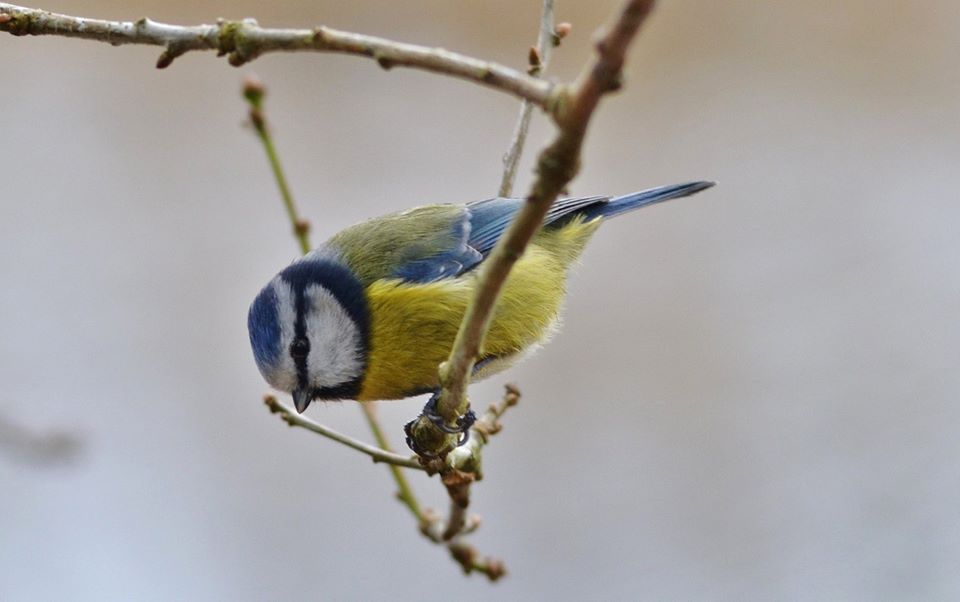
Day 6-Hilly placenames
Monaghan abounds in drumlins, hills of mixed clay and stones that were shaped as the ice melted during the last Ice Age. These distinctive features, usually have a gentle slope to one side and a steeper slope to the opposite side, representing the direction of the ice melt or retreat of the glaciers. Other hills are what I would call pointy, or round all around, perhaps with a very stubborn rock core. All great for rolling down or sliding down on a plastic bag during the winter snow!
This topography is reflected in placenames in the county. Do you live on a Drum…, a Cor…?
Drum refers to the droim, meaning ridge or a back like an animal lying down. Some examples are Drumirril or Droim Oirill in Farney. Drumgeeny or Droim Géine in Truagh, which means ridge of the moss. Boggy and therefore mossy habitats are common in Truagh. The amazing Sphagnum or peat moss can hold up to ten times its dry weight in water. More on this in another Heritage Happenings.
Corr is typically a round hill, a pointed hill, a conspicuous or odd hill. Corracrin or Corr an Chrainn is Round hill of the trees.
Knock or Cnoc means hill as well, and is more commonly heard in the north of the county. Knockballyroney in is Cnoc Bhalile Ui Ruanaidh, Hill of the homestead or town of the Ruanaidh (surname).
Tully or Tulach is a hillock. Tullynarney or Tulaigh na nAirne is tulach na n-áirneadh or hillock of the sloes (berry of the blackthorn).
You can find out more about your townland name at www.logainm.ie
Day 7-Ringforts
In Monaghan, many of the gaelic Irish continued to live in ringforts right up until a few hundred years ago. On hill tops, you can often see a copse of trees, or prominent earthen banks still.
Ringforts were essentially farmsteads and some are fossilised into placenames such as Lios, Rath, Dún. Liscat is Lios cat or Fort of the cats. Rakeeragh is Rath caorach or fort of the sheep. Dunmaurice is Dún Muirisc or Muirisc’s fort.
Ringforts were usually circular and had a diameter of 20 to 50 metres, with a ditch and earthen bank marking the perimeter. Inside, there was usually a circular house made from post and wattle with a thatched roof. Farm animals were kept inside the ditches for safety at night-time. These sites are now on the archaeological register for Ireland and are protected.
The website www.archaeology.ie has a useful, easy to use, interactive map where you can see aerial photographs and old maps depicting ringforts and other archaeology. Here is a link to one to in Monaghan at Lisseraw or Lios an Rátha – essentially ‘fort of the fort’, which is a great description as it does appear to be triple banked fort. So good they named it twice!
You can see the ditches and banks quite clearly, and the way the field boundaries radiate out from the top of the hill.
The registration number is MO013-020.
Day 8-Whins
Whins or the whin bush is the common name for gorse in Monaghan, that very spikey, dark green leaved shrub with the golden, fragrant, buttery soft flowers. Bright vanilla gorse. On Easter Sunday there is a tradition which combines eggs and whins in Ulster, a custom full of Easter symbolism.
The first delicate task is to pinch the blossoms from between the thorns, trying to avoid laceration at all costs. The yellow petals are then boiled with the eggs. All participants climb to the top of a steep hill to then race down behind their chosen golden egg, which can be eaten, gratefully afterwards.
In Irish, gorse is aiteann, which is a combination of aith (sharp) and tenn (lacerating). In early Irish law, gorse was one of the ‘bushes of the wood’ and was useful for making hedges and shelters for livestock.
In latin, it is Ulex europeaus. To me, Ulex always sounds thorny.
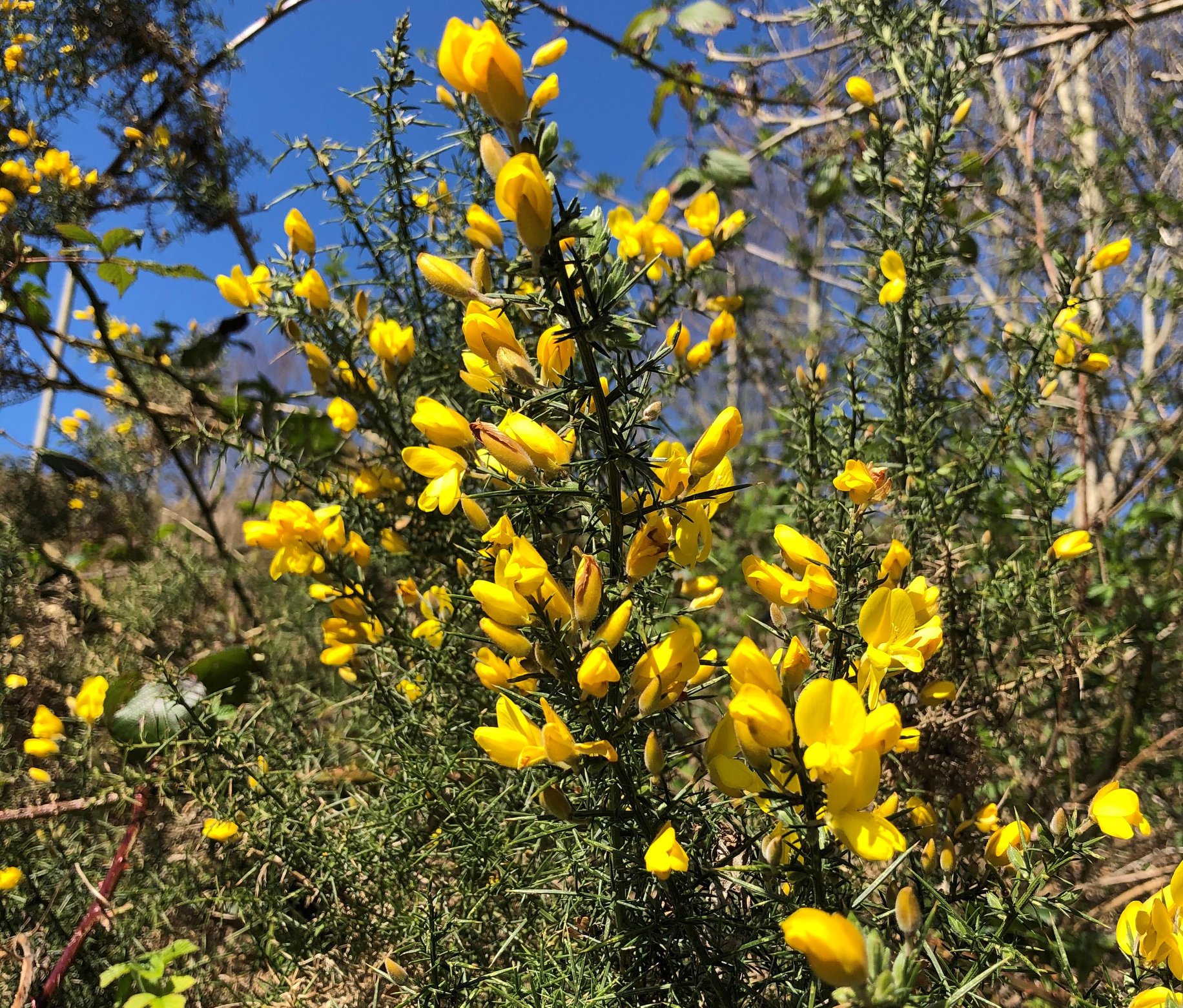
Day 9-Small Tortoiseshell butterflies
These are on the wing now, meaning that they are no longer caterpillars, and have metamorphosed successfully into flying jewels. Orangey in colour, with black and yellow bands to the front of their wings, and almost a lacey effect around the edges in black and blue, they have it all going on. A bit of Bett Lynch dress sense!
As caterpillars, they nibble nettles and live in little groups until ready to make their cocoon, when they separate and go it alone to be in social isolation. In late Spring, they emerge as butterflies to enjoy the air, the spaciousness and the freedom which is suddenly theirs.
They love buddleia flowers, and you are bound to see them in your garden or on your walk on a sunny day.
In Irish they are Ruán beag.
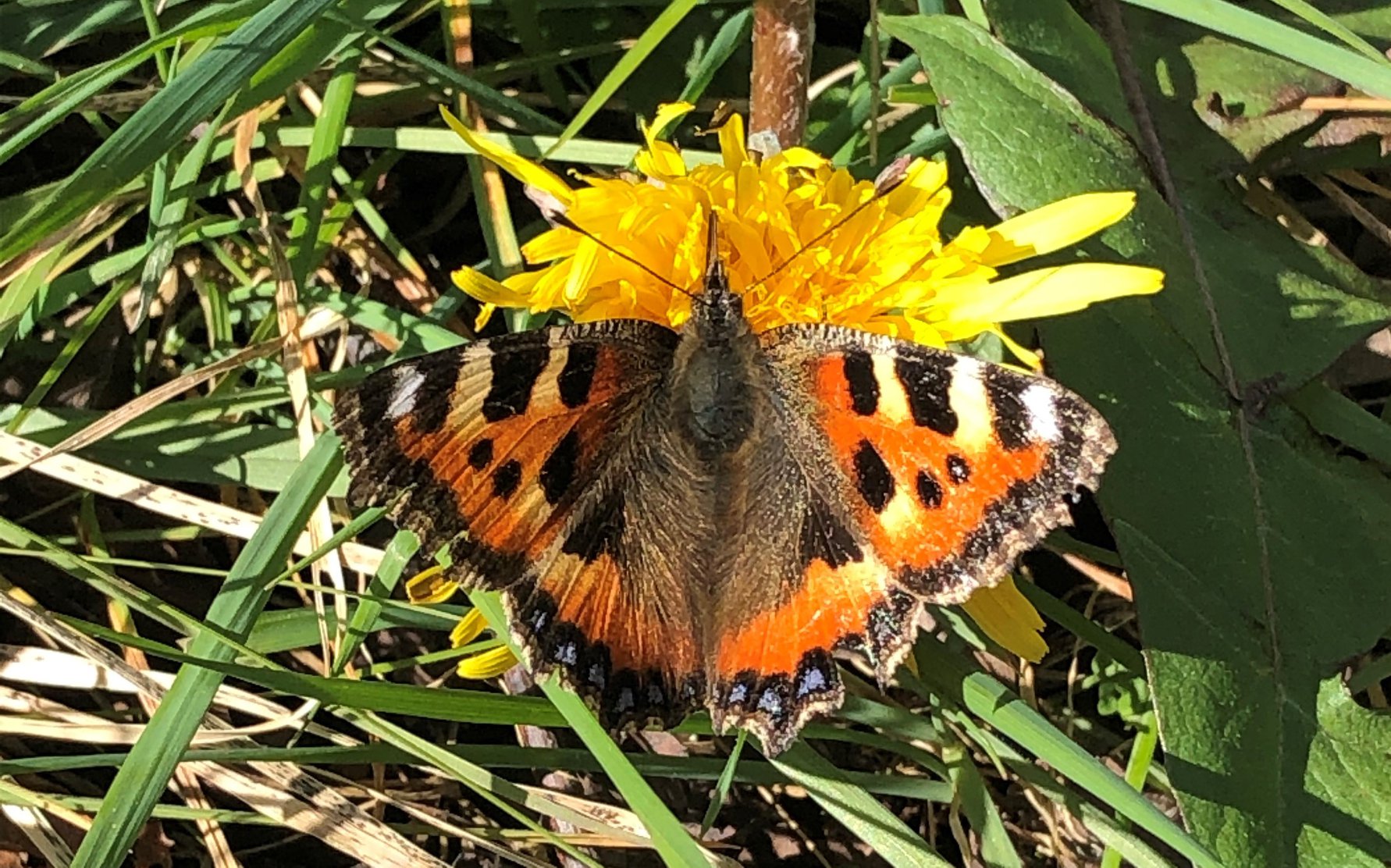
Day 10: Reeds
Elegant rose gold reeds frame our lakes beautifully at this time of year, setting off the reflected blue sky or the muted foggy grey water to perfection. Reeds like to have their feet wet and their purple-ish feathery heads blowing about in the air. They are commonly found fringing lakes or in marshes and fens across Monaghan county and across Ireland.
Common reeds are Ireland’s tallest native grass and can grow to over 2metres, with very tough stems to keep them upright. Remains of reeds have been found in the peat at the bottom of raised bogs, proving that these places were once lakes.
In a time when roofs were mainly vegetative, reeds were used for thatching houses, but not as much as one would think, perhaps they did not last so long as other materials – “Sometimes empty reeds found growing beside lakes” are used for thatching, recorded in Corlattallan in 1946.
Between 1835 – 1840, a survey of houses showed that most were still thatched, except for Glaslough, County Monaghan where only 35% of the houses were still thatched, showing the influence of a landlord in improving conditions there.
Reeds are excellent at absorbing nutrients and play a role in water purification, so good in fact that they are used as the main plant at constructed wetland sites, including the water treatment wetlands at Castle Leslie, Glaslough.
It’s latin name is Phragmites australis, pronounced Frag as in Fraggle Rock – if you recall that children’s television series. In Irish, reeds are giolcach.
The photographs are from Killyboley Lake, Glaslough or Coillidh Bhuaile, the wood of summer pasture
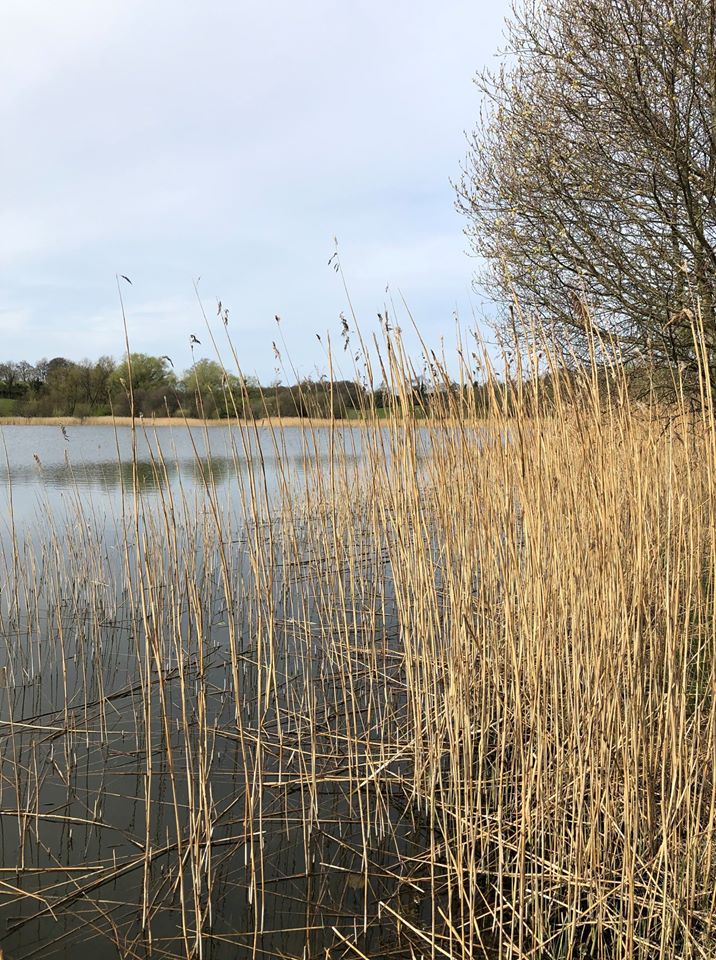
Day 11- Spy windows
Traditional houses in Monaghan and elsewhere often had spy windows in their jamb walls. Nothing to do with actual spies, or James Bond though.
The jamb wall was opposite the front door of the house, adjoining the central hearth, keeping the heat in while allowing the light from an open front door to permeate through. The spy window was at the right height to see who was approaching the house for a ceilí (social visit), without leaving a warm spot beside the fire. This house type has been characterised as a “hearth-lobby” style house.
It is thought that this innovation was introduced by British settlers in the sixteenth and seventeenth centuries. The jamb wall is also known as the speer-wall, spike-wall, spy-wall or hollan.
The position of the jamb wall allowed the creation of a little lobby inside the front door, especially where there was no porch. It also meant that large animals like cows could no longer enter the house, and so a separate byre was required. These hearth-lobby houses were a step up from the byre-dwelling combined houses, where the hearth was at one end, and the few milking cows were tethered at the opposite end wall, with a simple drain dividing the areas.
Windows were small, about face-sized, mostly square or near enough, but a few homeowners took an opportunity to be a bit creative and sported triangular spy windows in the jamb wall.
You might notice traditional or vernacular houses that are derelict on your walks, or you may still live in one and be preserving this lovely heritage. We often forget how far we have come, and how much we’ve forgotten.
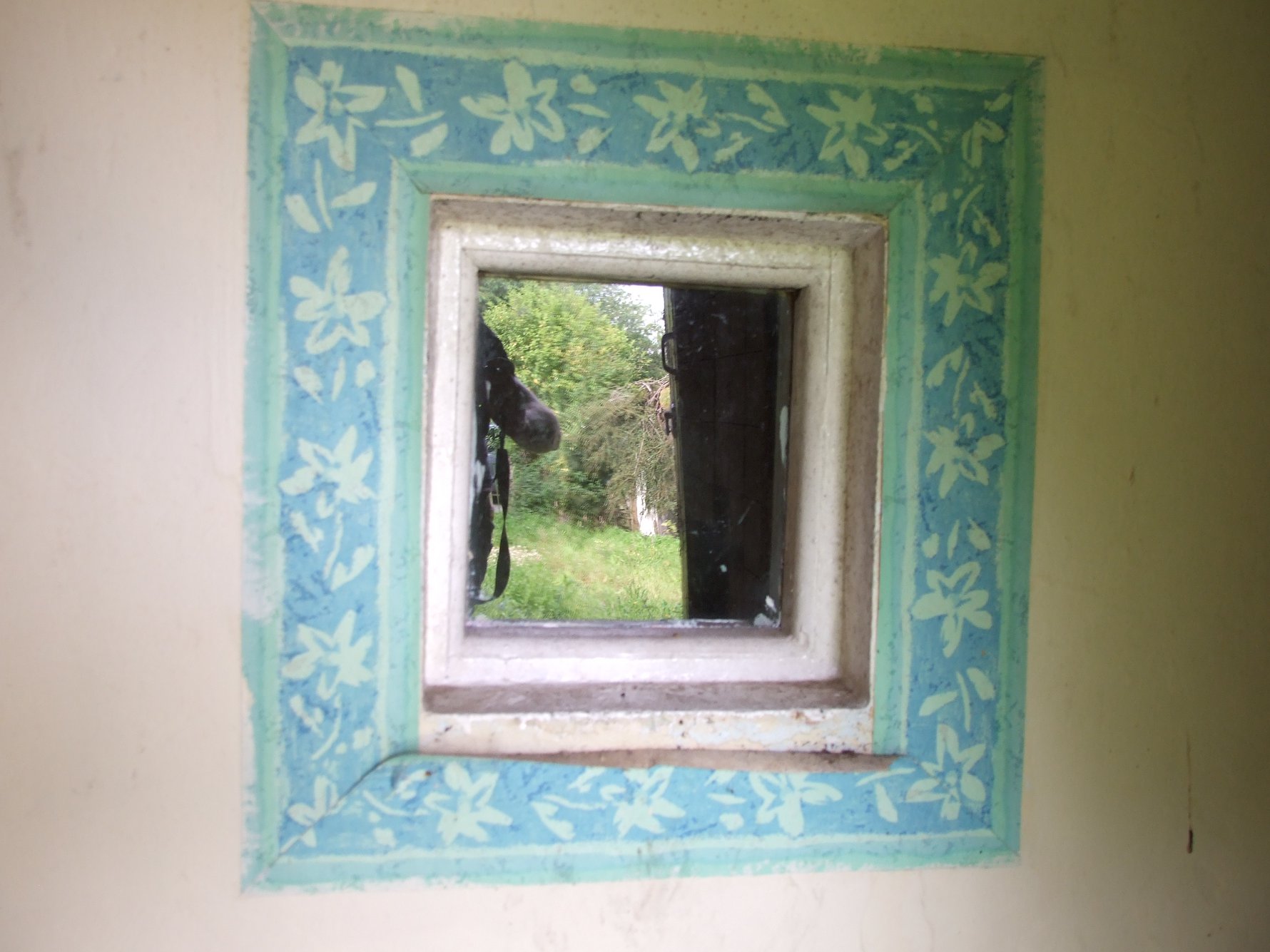
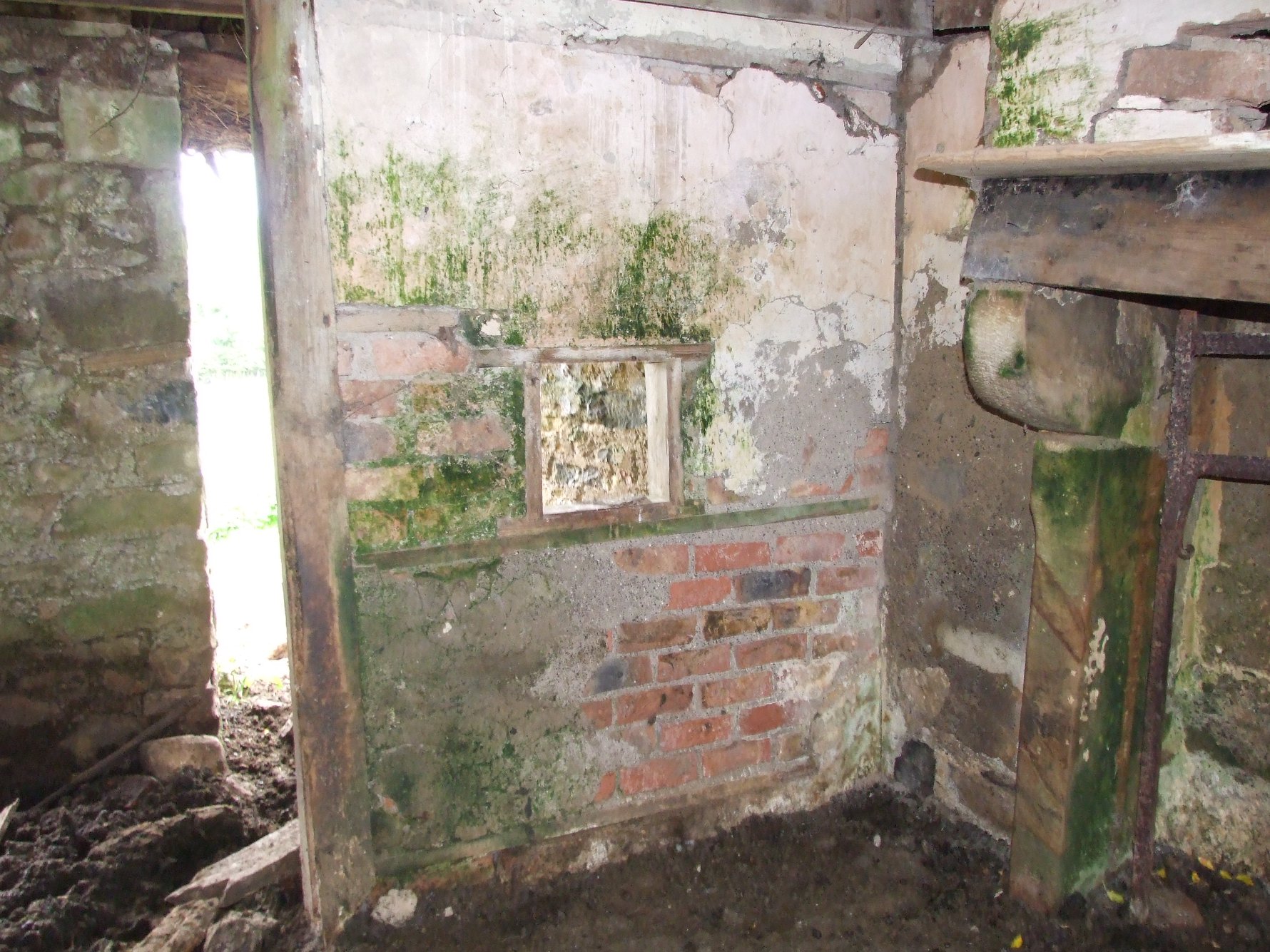
Day 12-Lords-and-Ladies
These are one of the oddest flowers you will see in the dappled shade of a hedgerow, or woodland edge, but at this time of year it is the large arrow shaped leaves that are most apparent. As well as its unique form, lords-and-ladies or cuckoo pint has a very special and close relationship with small flies or midges. A fine romance.
Keep a close eye on these arrow shaped leaves, as very soon they will throw up a sheath or spathe, which hides within a dull purple spadix. The sheath opens during the day and the spadix heats up to give off what must be an unpleasant smell as it attracts the small midges. Don’t sniff it, you might inhale the little beasts.
The captured fly falls down into the base of the spadix where it pollinates the flower, and then the stiff hairs inside the sheath die back to allow the fly to escape and perhaps carry this plants pollen to another lords-and-ladies. The flies never learn about the danger of entrapment, albeit temporary!
Later in August, the spadix becomes a fruiting body, prominent in the hedgerow base, shining with bright red poisonous berries.
The plant seems to prefer lime-rich soils and its distribution may reflect the presence of former woodland.
Their scientific name is Arum macalatum and in Irish is Cluas Chaoin, smooth or crying ear.


Day 13-Burial ground symbolism
Historic burial grounds in the county are a repository of symbolism and folk art, inscribed on the faces of old headstones and memorials. Part of a south Ulster tradition, which seems to have travelled from Scotland with the stone masons and settlers in the a 17th and 18th century, these symbols of mortality include crossed-bones, skulls, hour-glass, coffin and a bell.
The meanings of all this heady symbolism hardly requires any explanation, for that was their purpose – to remind the visitor that one is mortal, that time on the earth is finite, and that the bell will toll for us all. This morbidity was a commonly expressed at the time, the headstones themselves a reflection of religious oratory, not yet having moved to the more cheerful cherubs and praying figures that adorn the slightly later headstones.
Many of these mortality symbols in county Monaghan are to be found on the back of small discoid stones, looking like stunted wheeled crosses, very economical in terms of the quantity of stone needed and reminiscent of the Irish high crosses. A real combination of cultures.
One renowned stone carver, called William McKay (a Scottish name) was buried in Donagh graveyard, close to Glaslough. He was of nearby Glennan quarry and is thought to be one of the stone carvers responsible for the unusual headstones found in the south Ulster area. This old monastic site was essentially fossilised through the new use of headstones for family plots from the 17th century onwards, with three 1666 memorials still in place today amongst the other stones, cross, ruins, lichen and mosses.
Today, 18th April is the International Day for Monuments and Sites, with a theme of Shared Cultures, Shared Heritage and Shared Responsibility. Many historic graveyards in Monaghan and elsewhere are important heritage sites, with significant and protected ruins, memorials and histories of religion, cultural divisions and integration expressed in their remains. These sites are special places for those who visit and safeguard them. The Heritage Council has an informative guide available on their website on the Care and Conservation of Historic Graveyards which will be of interest to those with a role in caring for these sacred sites.
The photos are from Killeevan Old Abbey graveyard, County Monaghan. Killeevan is Cill Laebhan, the church of Laebhan.
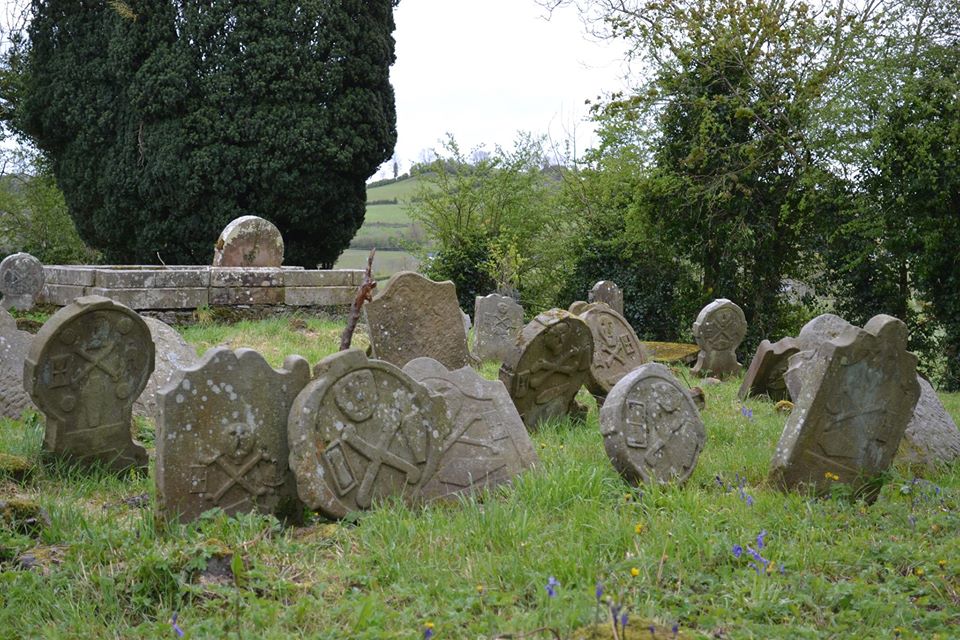
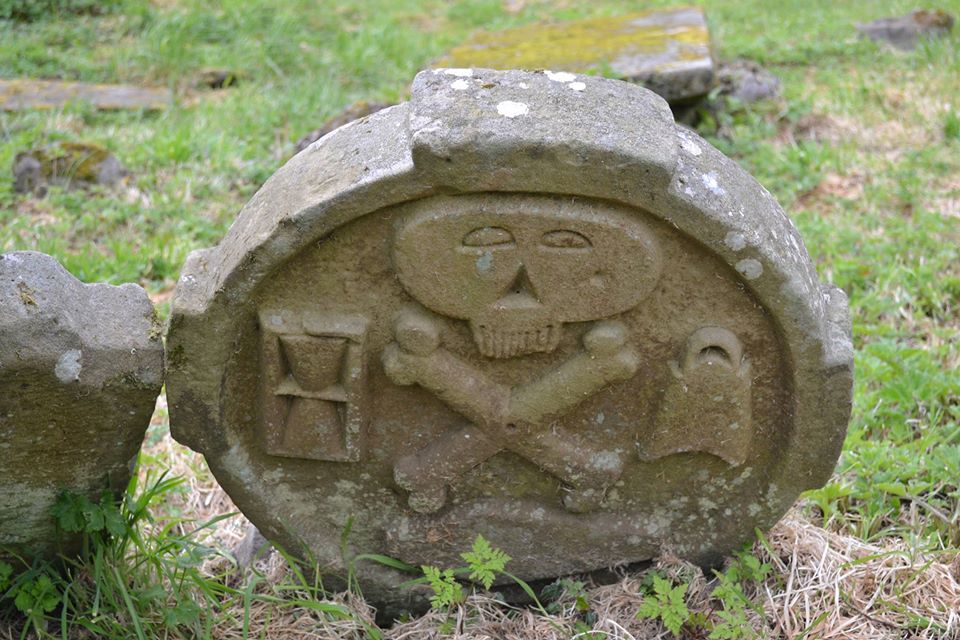
Day 14- Bluebells – odd candles not fork handles
Bluebells are one of the most evocative spring flowers that we have, easily recognisable and numerous where they have the right habitat to carpet the ground. The resulting mesmerising blue haze is joy for the next few weeks.
Bluebells or Coinnle Corra in Irish, translating as odd candles, can push their young shoots through deep leaf litter on the woodland floor and compete their lifecycle over a matter of a few weeks before the woodland canopy closes. Their underground bulbs can produce leaves and flowers at the same time. The bulbs produce a sort of gummy sap, which in the past was used for bookbinding and setting tail feathers on arrows. In County Monaghan, it has been recorded as a medicinal application for whitlows, those little abscesses in the soft tissue near fingernails.
Bluebells are rich in pollen and nectar and very much loved by bumblebees, who are its chief pollinator, able to squeeze into its dangling bells. It is one of the plants that are indicative of old hedge or woodland, and often is found with Lords-and Ladies, lesser celandine and wild garlic, all of which also have useful underground storage.
Extensive areas of bluebells bloom on Black island at Lough Muckno and at Rossmore Forest Park, but it is also prominent in hedgerows in smaller dainty clusters.
Cloigín gorm is the name children learn at school for our little blue hyacinth, and Bú seems to be a much older Irish term.
Photos are Bluebells emerging with greater stitchwort at Seaveagh in a hedgerow, and bluebells at Kilcran, County Monaghan.
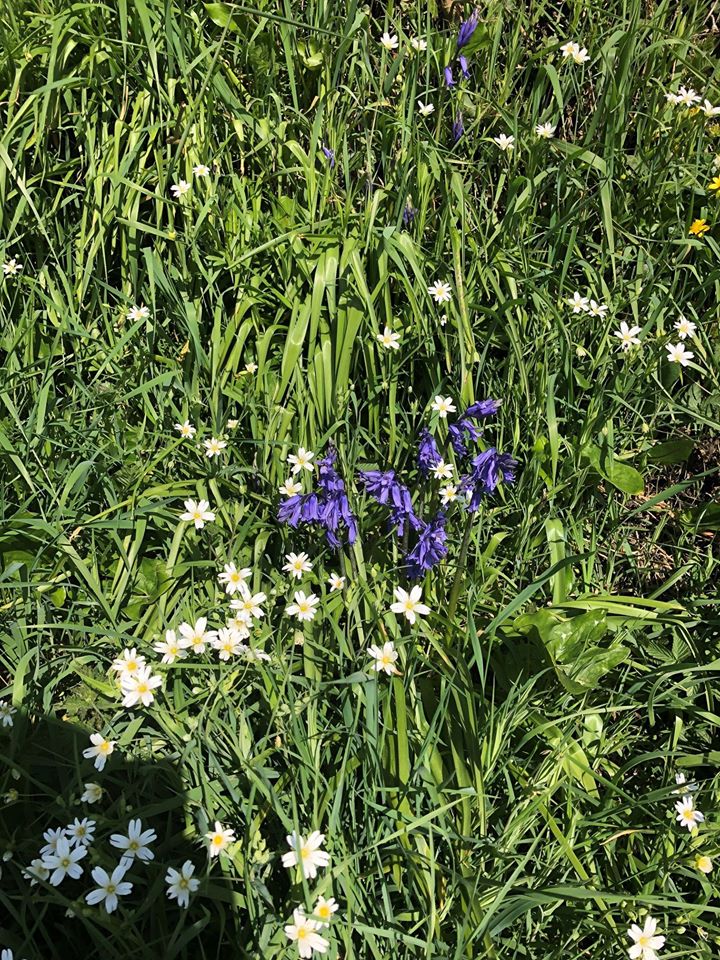
Day 15-Mossy carpets
Patrick Kavanagh’s Green Fool mused that “a man who cannot find happiness and content in a turf-bog is a bad case.” He was no fool, as to stand on the living surface of a turf-bog, is to be upon a rich carpet of sphagnum mosses, a hummocky quaky mosaic of colour; mosses which can engineer their own landscape.
Sphagnum mosses can hold twenty times their own weight in water. Water is trapped between the moss plants in a hummock but also within the special barrel shaped cells of the plant itself. To grab a handful and squeeze is like turning on the tap, so much water will pour out.
The storage of water continues even as the dead moss accumulates as peat. It does not decompose as other plants in the wet acidic environment it creates for itself – this is how bogs store carbon. They are carbon sinks, the plants are standing on their ancestral peaty remains, and have the best capacity of any ecosystem to store carbon. Bogs are vital to retain and restore in our fight against climate change and for this we need sphagnum moss to be able to actively grow.
The mossy hummocks can be 1m high on the bog and can be chocolate brown or orange. Others form loose mats in pink, red, copper and yellow. Others grow as single plants surrounded by water in bog pools. These ones are bright lucid green. As sphagnum moss plants are just one stem each, there can be 50,000 plants in just square metre.
Sphagnum is known for its medicinal and antiseptic properties, and it is recorded that Brian Ború used it at the Battle of Clontarf in 1014. It produces an antibiotic called sphagnol.
During the First World War, the collection of moss was managed from all over Ireland, by women relatives of Irish regiments in the British Army. The moss was separated, graded, washed and packaged in regional depots and then sent to the Royal College of Science on Merrion Street, Dublin. It was then sown into fabric for various applications.
In Monaghan, we have collected information on 711 wetlands, many of which have sphagnum mosses actively growing. The short video shows two young naturalists finding out how much water sphagnum moss can store, filmed on the blanket bog of Sliabh Beagh. More about wetlands in another Heritage Happenings!
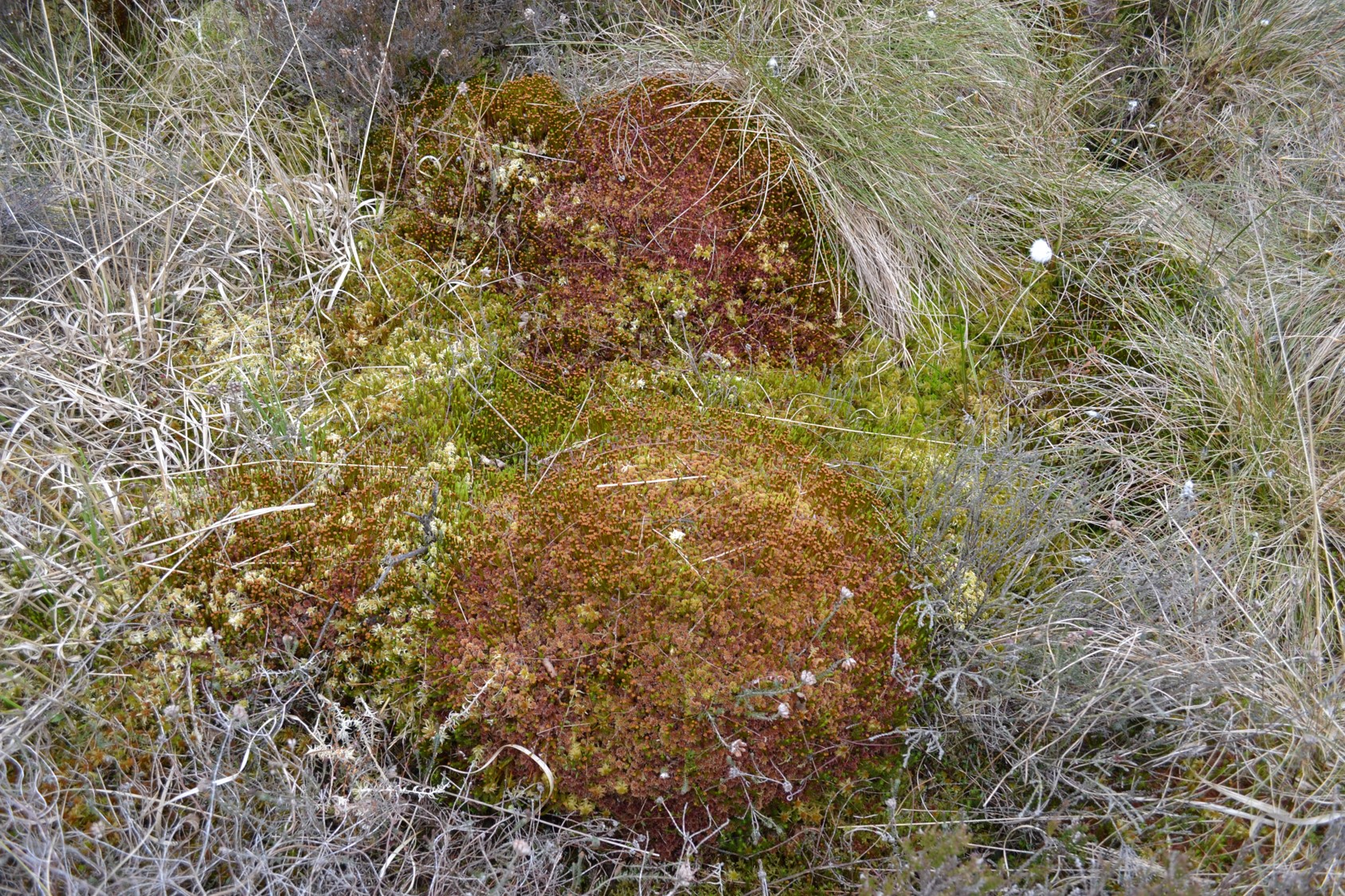
Day 16
Curlew, cry some more in the air
The curlew is an unusual tweedy brown bird with a long, curved beak like a cobbler’s needle, useful for probing soft ground for its dinner or small invertebrates. To match this quirky innovation, it also has a whistle like call often referred to as a “cry”. WB Yeats heard the curlews lament “O Curlew, cry no more in the air” and Robbie Burns heard its whistle and felt an “elevation of the soul”.
Robbie Burns soul would therefore feel loss at the dramatic collapse of the population by 86% over thirty years in Ireland. As did many more people, so after public pressure and advocacy for this special bird, the Curlew Conservation Programme was established.
Today, 21 April is World Curlew Day. Only 6-7 known breeding pairs of Curlew remain in all of County Monaghan. They like wide open bogs and meadows in Monaghan, and they lay their eggs on the ground so are very vulnerable to predators.
If you are lucky enough to hear or see one between April and July you can help by reporting it to the local Curlew Action Team who will work with farmers and land owners to help conserve the breeding efforts of the bird.
In Irish, curlew is Crotach, which also means crooked which indeed its beak is.
For those who have forgotten the Curlew call, the sound of Curlew calling can be found at the link below.
Thank you to Donal Beagan for the photograph of the chicks and some information for this piece.
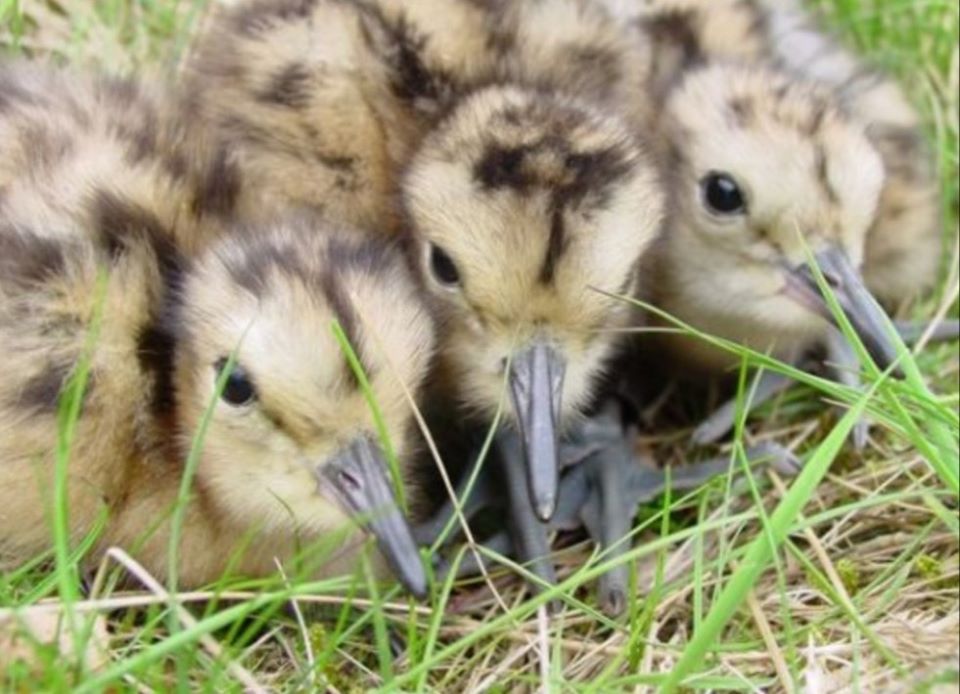
Day 17-Earth homes
One beauty of mud walled houses is that the main building material is usually close to hand, no travel miles. Another is that the earth is warm and insulating, although it needs good coat of lime render to keep it watertight. They have a gently softness about them as homes, almost a blurring of the edges.
The area around the Dromore River system in Monaghan – now named Rockcorry, but the old Irish name is Buíochar – from ‘yellow land’ on account of the yellow clay – less rock, more clay, has more mud houses than anywhere else in the county.
Houses like this must be built slowly, a couple of feet at a time, then drying and then another layer. Often the windows and doors were cut out afterwards with a spade, and the tops of the gables finished with sods, capped with a thatched roof which overhang at the eaves. Many people in the area still live in these houses, albeit they are modernised with slate roofs and all mod cons, but they still retain their charm, and importantly their warmth.
Today is Earth Day, the 50th anniversary in fact, although of course every day is Earth Day. We seriously must remake our relationship with our Earth home, and to nourish Earth, not deplete it; To respect Earth, not dismiss it; To celebrate Earth, not blame it.
Rachael Carson in her acclaimed 1962 Silent Spring wrote “No witchcraft, no enemy action had silenced the rebirth of new life in this stricken world. The people had done it to themselves.”
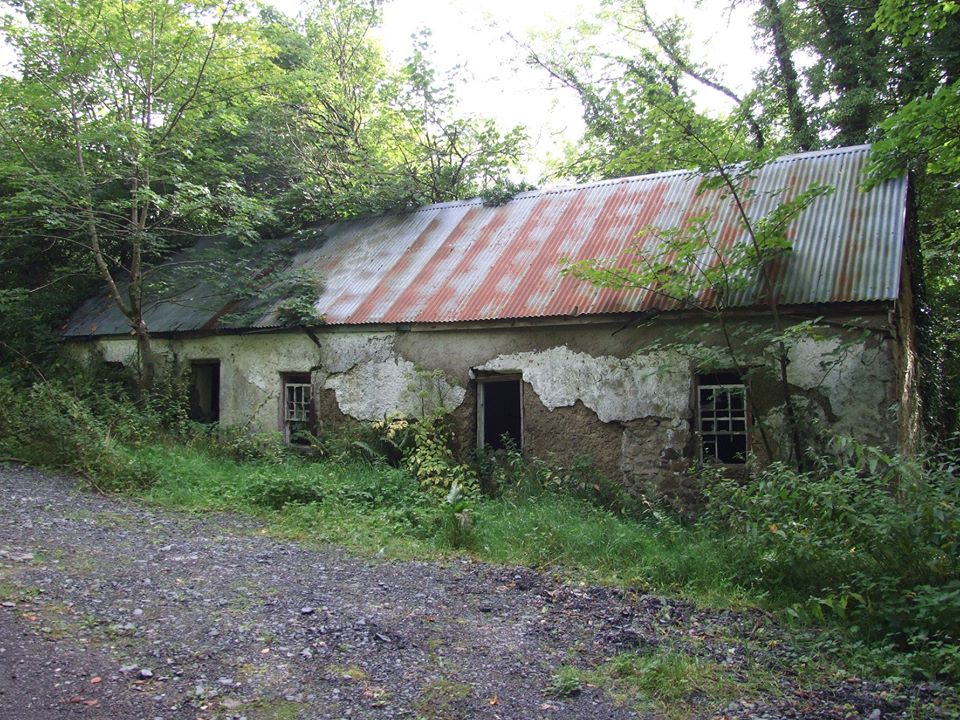
Day 18- Hazel
As a follow on from yesterday’s post about mud houses, hazel seems like an appropriate tree to muse over, as it was often the “wattle” in medieval wattle houses in Ireland. Surviving examples of wattle houses are recorded in 1946 in County Monaghan, that were built in the 19th century if not before.
Its leaves are unfurling and spreading out now, giving a gorgeous green softness as the light readily penetrates them. Because they can readily grow from a stump, hazel trees are often coppiced, or cut right back so that new straight shoots grow up as hazel rods. Many a hazel rod was used as wattle or as a pea stick.
The Irish for hazel is Coll, which also had the meaning of chieftan. Interestingly the English name Hazel derives from an Anglo-Saxon word meaning authority or kingship. In early Irish law hazel is classified as a Noble of the Wood – an Airig Fedo.
The yellow lamb’s tails or male catkins can have 4million pollen grains, and the tiny female red flower sits close to the twig and can be hard to find, but worth a search. After pollination these will be the tasty and nutritious hazel nuts, an important food source in Ireland from the earliest times.
It is regarded as a good protector against evil spirits and hazel sticks are often used by water diviners to find water. Hazel is found in older hedges, and old woodlands in Monaghan and indeed in some placenames too. Carnquill, Tedavnet is Carn an Choill, the Cairn of the Hazel.
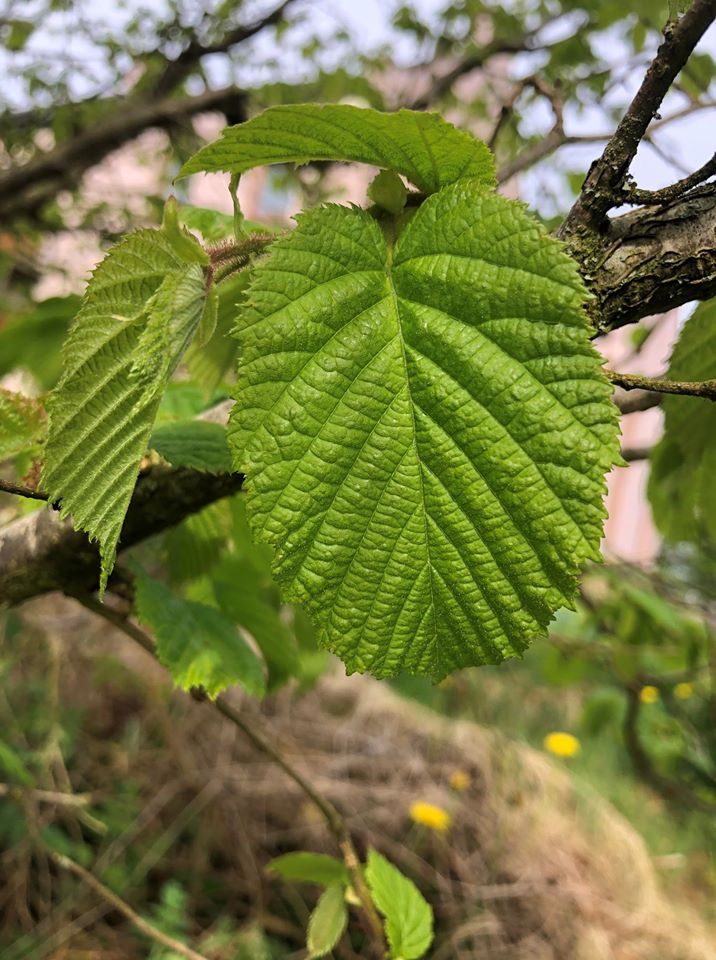
Day 19- Marshy placenames
Townland names in Ireland are a sort of risen cake, for which the ingredients can be discerned but a flavour, hence an ingredient can be missed or mistaken for something else. For they have been baked for 2,000 years, some of them, and evolved through various re-namings, anglisations and land-use changes so that the feature for which they were named may be long gone.
A felled woodland. A disassembled cairn. A drained wetland. A fallen church. But still, much remains, and that alignment of place and name still, carries optimism for our landscape.
Marshy or boggy townland names are found across the country and are very common in Monaghan, not surprising when one considers the drumlins peaking above the soggy bottoms of the wetlands.
Annacramph is Eanach Creamha – fen of the wild garlic, a plant coming into flower now. Wild garlic is also called Ramsons and likes a nice rich calcareous damp soil. Plants that were useful food sources, like garlic are often found in placenames.
Annaroe is Eanach Rua, translating as Red Fen, likely due to the presence of a species of Sphagnum moss which has a vivid red colour and grows in fen habitats.
Irish words for marsh include riasc, seascann and currach. Sheskin is An Seisceann which is a sedgey bog or marsh.
Another evocative townland name is Drumhillagh or Droim Shaileach or Ridge of the Willow. Willow of course is a well-known tree of wet places and will grow in the most waterlogged of conditions.
The Irish for Willow, Saileach is very close to its latin name Salix. The Sally rod was once a tool to be feared due to its pliable nature, an easy whip across many any outstretched palm at school or home. But this was a misuse of a lovely and useful tree, which was often planted as “Sally gardens” so to avail of its many positive uses.
Willow has a wonderful fragrance when steeped in water and used for basket making. In early Irish Law willow was classified as a commoner of the wood. We are all willow. Each of us are commonage keepers on this planet – if one person takes too much, it impacts on everyone else.
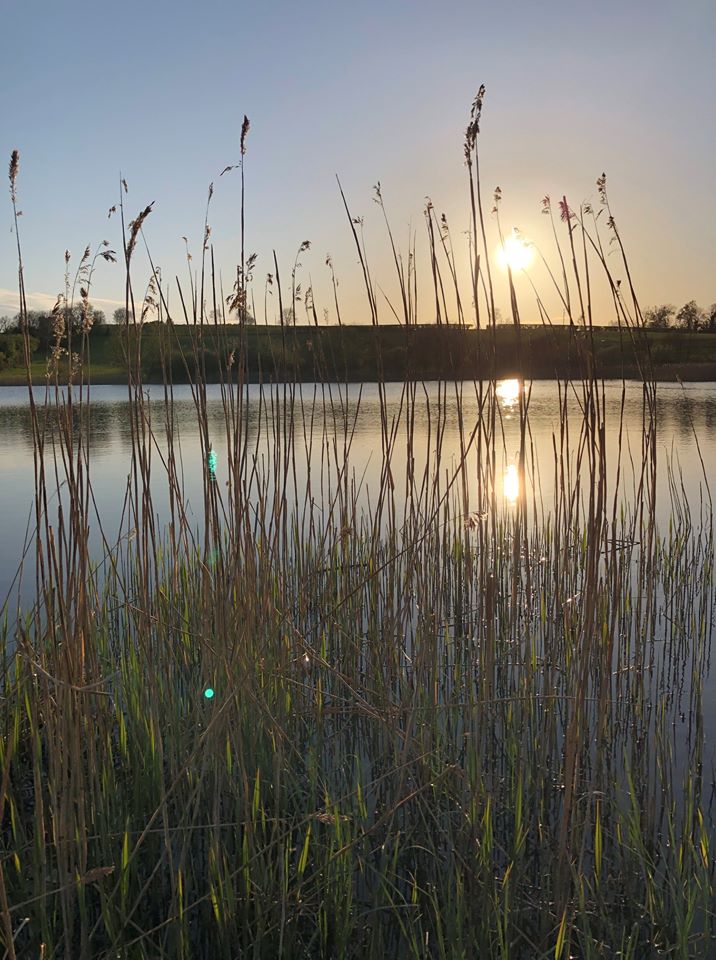
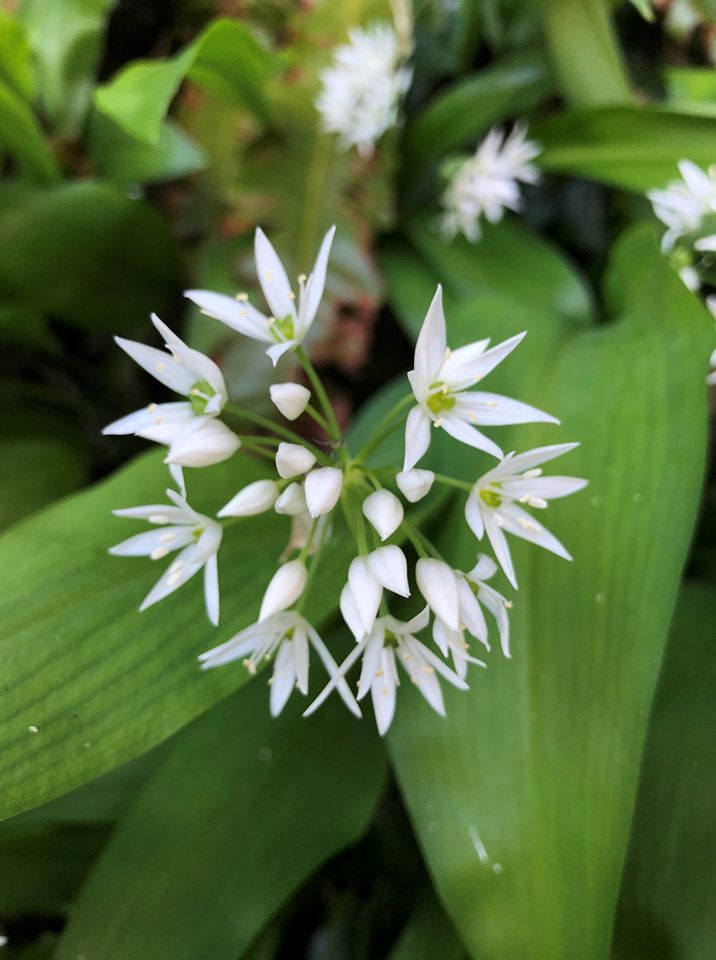
Day 20- Cow Parsley and other Bό flowers
Seemingly out of nowhere, Cow Parsley appears on grassy verges in late Spring, a showy triumphant umbellifer with lots of small white flowers waving lightly in the breeze. The combination of their leafiness and their lacey tops has resulted in their alternative name “Queen Anne Lace” but in Monaghan, even though we are proud custodians of Carrickmacross Lace and Clones Lace it doesn’t seem to be a common name here.
It is Peirsil Bhό as gaeilge, and it is apt as it flourishes on the Bόthar (road) edges. The origins of the word Bόthar derives from a path wide enough for cows to pass each other. Bό is the irish for cow. Cow Parsley grows very fast. With its hollow stems and leafiness, it shades out the earlier spring flowers very quickly before it has its moment in the sun or is chomped by livestock on their way to market, or more likely nowadays is chomped by a mower. It dies back very quickly in any case to be replaced by the next wave of summer flowers wanting to show their wares.
Another Bό plant out at the moment is the Cowslip, the nodding head relation of the primrose, with whom it sometimes hybridises to create false oxlips. Cowslip is Bainne Bό Bleachtáin which is Dairy Cow Milky flower. It was rubbed on cow’s udders in the past to help them produce milk. There’s often something in a name.
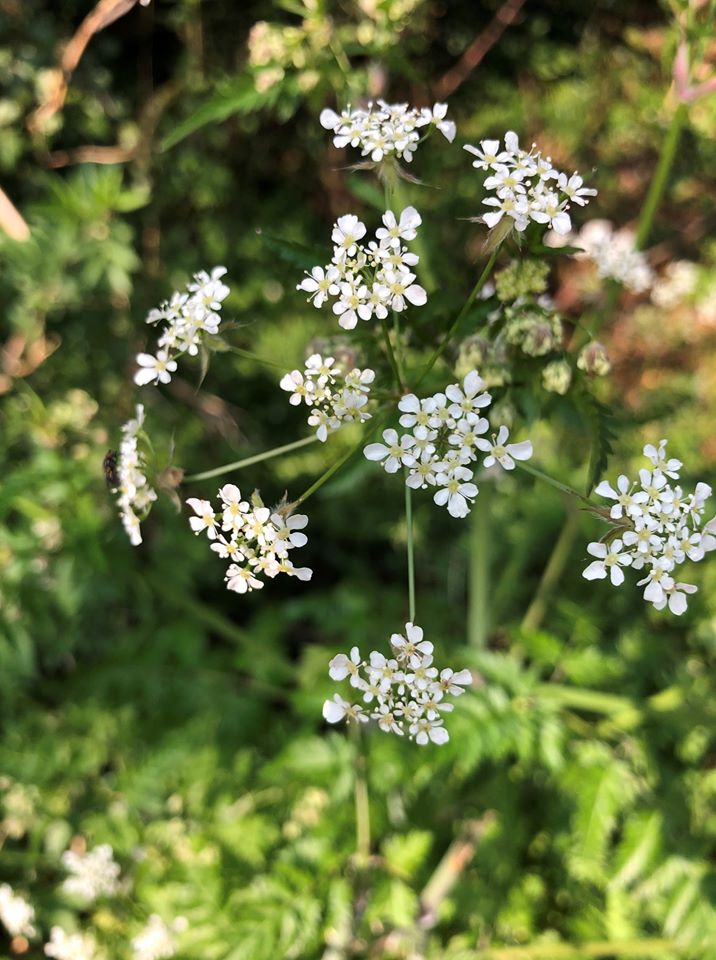
Day 21-Stepping stones
How we cross streams and rivers is scarcely remarkable to us now, unless perhaps we are on foot and can lean over the parapet walls of a bridge and look down to see the water below. As a people on foot, we travelled by “shanks mare” and knew special crossing places. Áthanna are fords or stepping-stones, a shallow part of a river, reaching from bank to bank augmented by stone and/or timber, where people, animals and vehicles crossed.
The ford at Aclint Bridge, had a famous meeting in 1599, where the second Earl of Essex met with Hugh O’Neil, the Earl of Tyrone. This is between Garlegobban, County Monaghan and Essex Ford, County Louth. The restored Essex Ford forge sits prominently on the roadside, waiting for the horses that are only ghosts now. Aclint is Béal Átha Claonta, mouth of the sloping ford.
Átha finds its ways into more placenames, at least twenty-nine places in Monaghan such as Béal Átha Beithe, the ford at the mouth of the birches, or Ballybay. Here the Dromore River links two lakes either side of the ridge where the town now sits, which is the perfect wetland habitat for birch trees still. Béal Átha an Iúir or Ford at the mouth of the Yew trees or Ballynure also speaks of trees. The majestic Irish Yews must have been a wonderful sight. They were much revered and important tree in early Irish law, and often planted to mark church boundaries. Yews have a very long life, many hundreds of years, and traditionally considered to be symbolic of eternity.
The term stepping stones emerged in the most significant European nature legislation in 1992, where the directive asked Ireland and other member states to encourage the management of features of the landscape, such as rivers, field boundaries, small woods and ponds for their function as stepping stones for “migration, dispersal an exchange of wild species”.
In other words, we must allow nature to function properly as a system with many parts. Increasingly, almost thirty years later this small paragraph in the directive is realised to be fundamentally necessary. Nature will not survive unless it can be everywhere, all its cogs turning together, all the jigsaw pieces together forming one picture with us as part of that picture.
Photo – Yew tree at Crom, Co. Fermanagh.
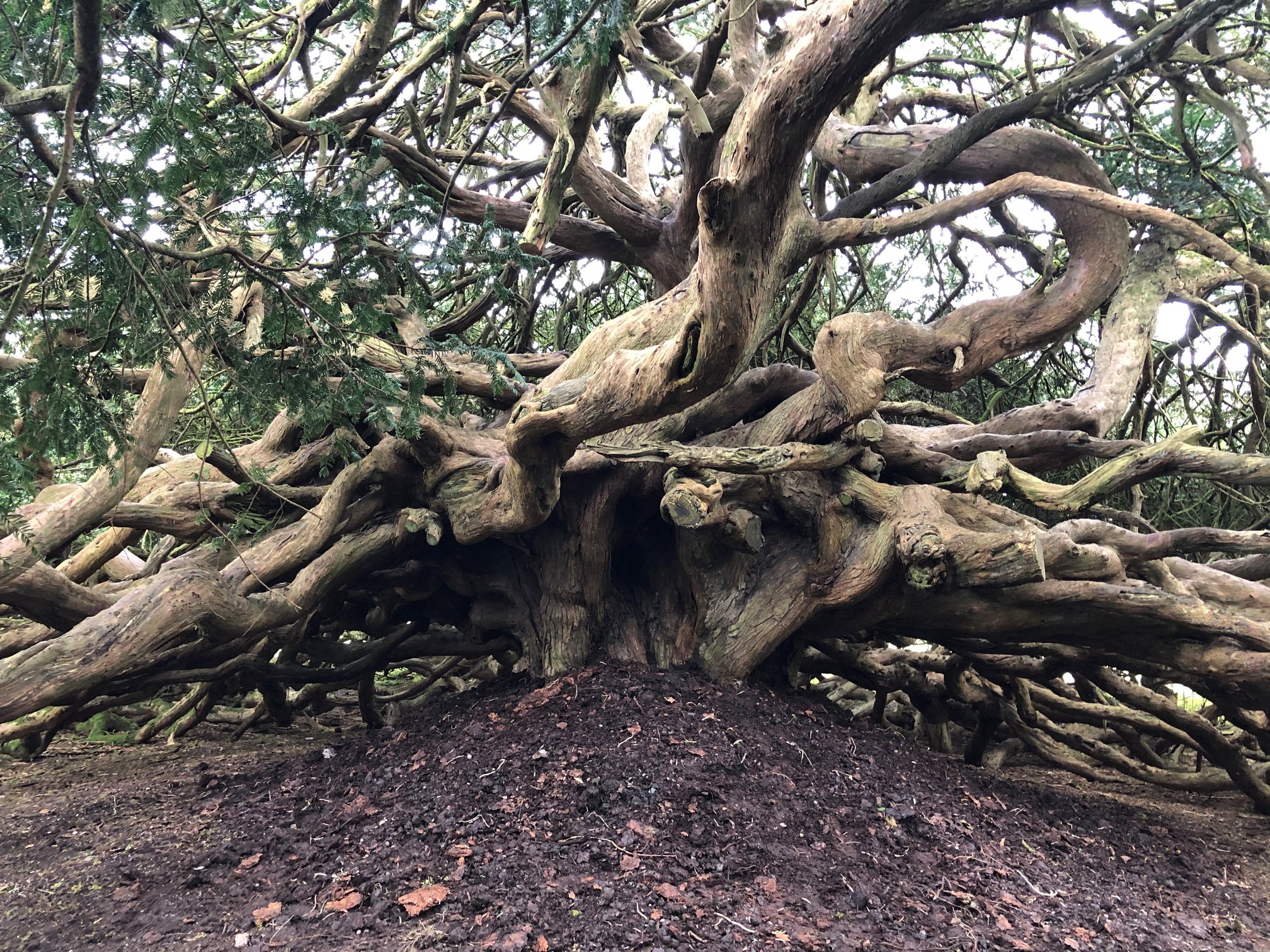
Day 22-Thorn quicks to a hedge
Hawthorn, a plant almost oblivious to hardship, is part of the thorny rose family. Now it is in leaf, we will soon see it blossom with its foam of May flowers, unless it has been trimmed too soon or cut down to a quick. If hawthorn is not allowed to flower, then it cannot produce the shiny red haws on which the birds so depend in the autumn.
Most of our hedgerows have hawthorn, or whitethorn as their staple, stable-ising structure – their spiny interlocking branches form a great weft and weave supporting other weaker plants to climb and ramble such as dog roses and honeysuckle. In the summer evenings, the wonderful scent of honeysuckle will stop any walker and the moths in their tracks, as the plant waits till then to send out its fragrance so to attract its pollinating insects. Bats need decent hedgerows to forage along in the evenings too, catching midges and moths along its route. Walking along a hedge which luckily has some height and dappled shade will now bring you close to the speckled wood butterfly. It spins around with its mate in a flurry of aerial dancing in its chocolate brown and cappuccino colours.
Hedgerows were planted in the 18th and 19th century for farming, for shelter, control of livestock and to mark land holdings and townland boundaries. Some are remnants of older woodlands. In wetter places, they have a drain on one side, the digging out of the drain itself formed the material for the earthen bank upon which the hawthorn quicks were planted. Gloriously often called the sheugh, pronounced shuck or simply the ditch.
The Irish for hedge is sceach and hawthorn is sceach gheal. It was always thought unlucky to cut lone fairy bushes – those singular whitethorn trees, or to bring it indoors. Considered to be powerful tree, the Maguire chiefs were inaugurated at a thorn tree at Lisnakeagh fort in Fermanagh. Lios na Scéithe is fort of the whitethorn tree.
The more species in a hedge, the better for wildlife, for they are the conduits through which nature survives in the countryside. Birds, especially. What would our days be without birdsong? This is one of the reasons why it is strictly prohibited to cut hedges now, except for a limited number of exceptions. The new awful fashion to treat hedges as simply gappy dentils – low, waist height, only sticks really must be revisited and resisted. As one of the farmers said at the 2019 Farming for Nature awards, ‘if whitethorn is not allowed to bloom, you don’t have a hedge you just have a bundle of sticks’.
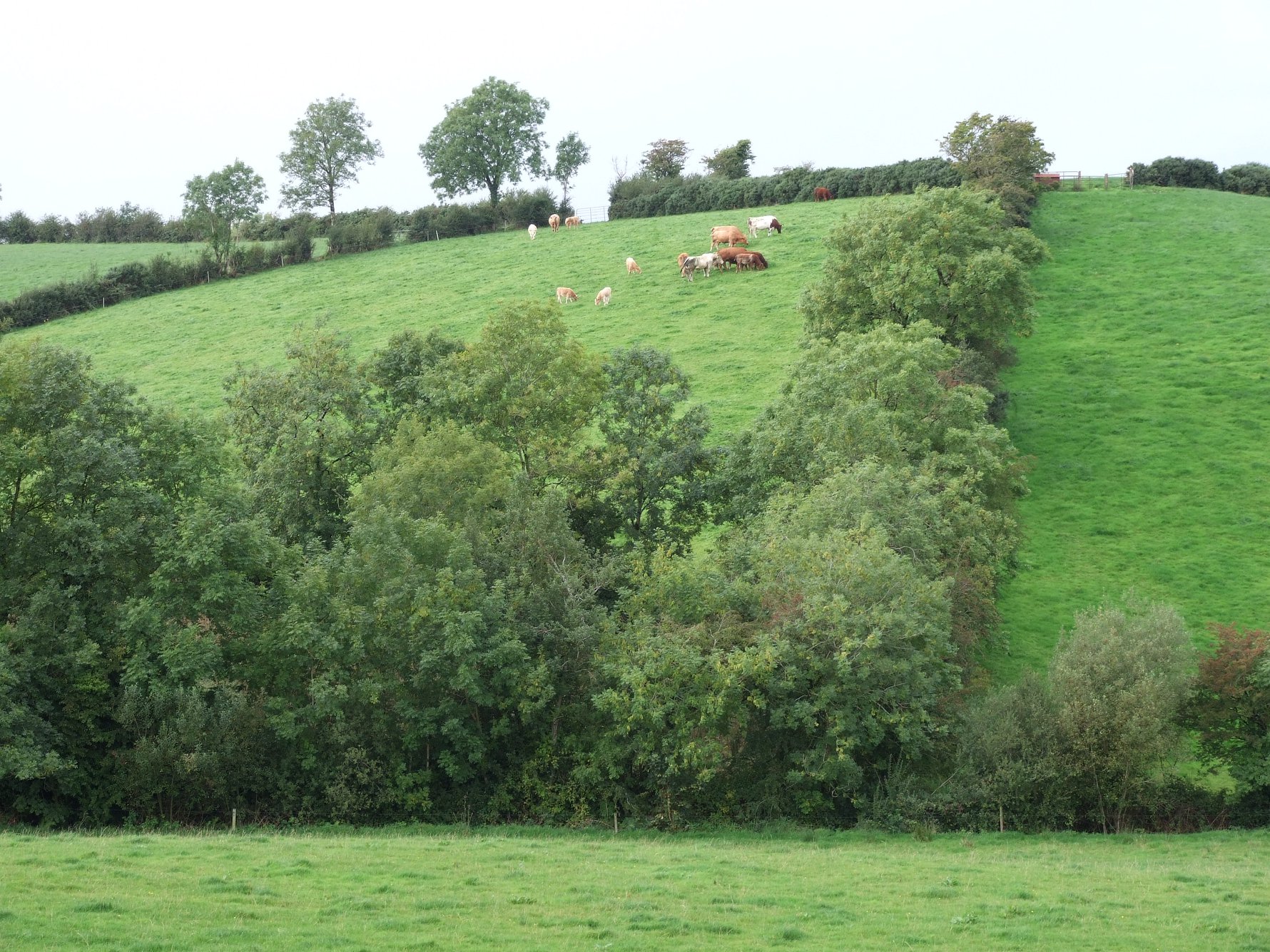
Day 23- First Fruits Gothic
It is worth casting an eye on church buildings afresh, for they are longstanding bystanders to all sorts of comings and goings over the centuries. All sorts of people, clothed in various fashions of the day, travelling by foot, horse, carriage, bicycle and car have been through the doors on occasions, sad and happy.
In 1711, Queen Anne established the Board of the First Fruits to build and improve churches and glebe houses in Ireland for the established state church, the Church of Ireland. Apparently, she was persuaded by the giant of Gulliver’s Travels – Dean Jonathon Swift. Perhaps he had a little self-interest in the matter and may have been feeling the chill in a draughty glebe house. Someone said, “Many are cold, but none are frozen”.
Many small rural and some urban churches were built with assistance from the board, often with a common feature of a small, sturdy, square west tower with pinnacles on top. Spires were more expensive add on and required a wealthy benefactor or congregation. The architects had a fine eye for a prominent and aesthetic setting for these new churches, moving away but often not too far from the old medieval church sites.
Newbliss Church of Ireland is one of these First Fruit churches. According to architectural historian Kevin V.Mulligan, it is “an exacting small church, dramatically sited against a hillside on the edge of town with a tower bristling with needle-like pinnacles”. Donaghmoyne, now disused sitting on top a good steep incline also with its gothic hall and tower is also near the site of an ancient church. The Annals of Ulster record that in 832 the shrine of St Adamnan was taken by the Vikings. A shrine is decorated fine metal box containing the saint’s relics or bones. It was apparently on tour at the time.
The Board of the First Fruits lasted until 1833, when it was dissolved.
Have a look for some pinnacles, they are not so rare as needles in the haystack.
The photo is of Crossduff Parish Church, close to Lough Egish, a small chapel with its tower and pinnacles, beautifully surrounded by beech trees.
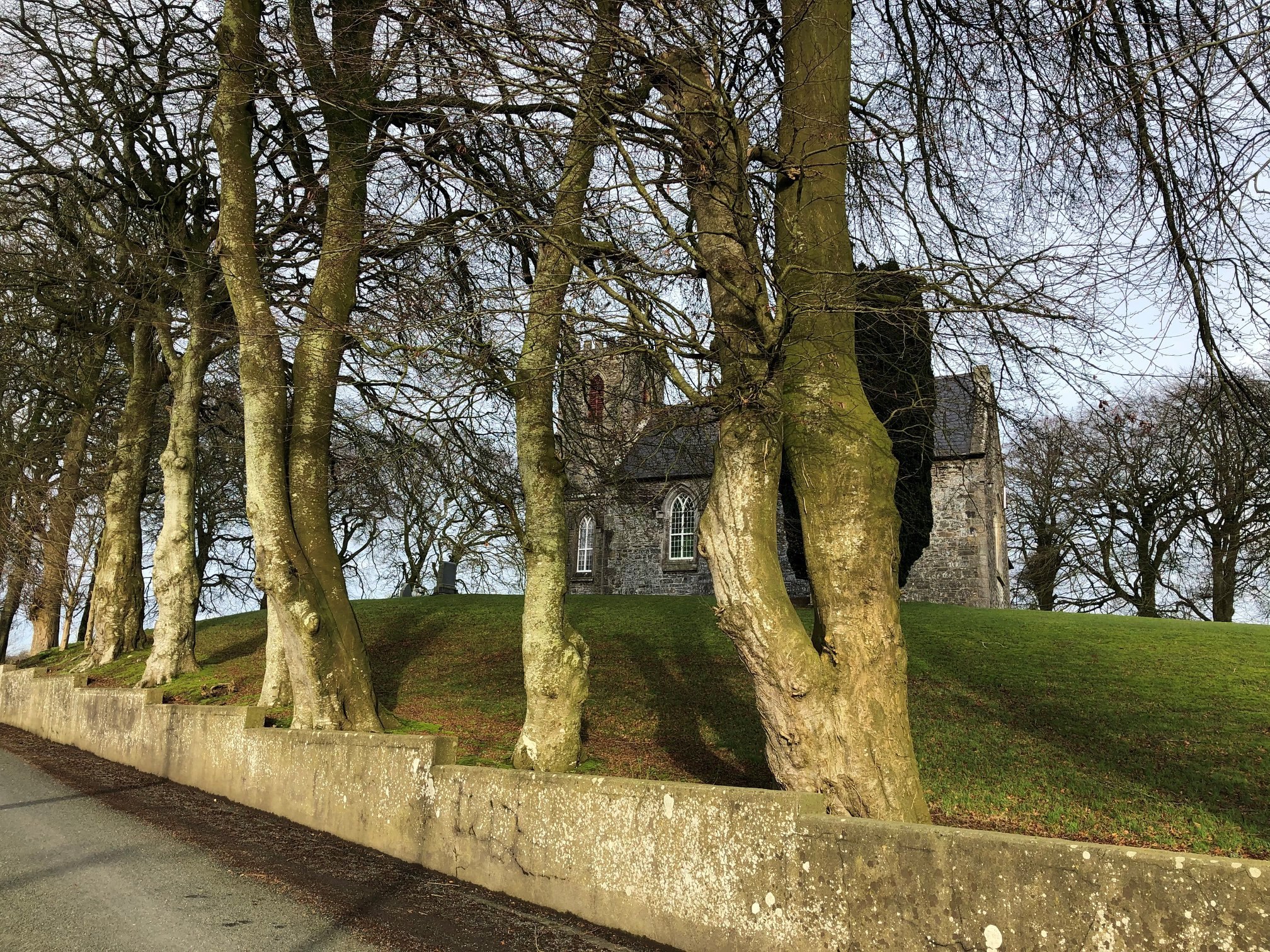
Day 24- Bell-houses
Patrick Kavanagh felt “the God of imagination waking in a Mucker fog”, which perhaps St Daig, the great maker of bells and shrines also felt, albeit centuries before, but the landscape remains silent on this rumination. St Daig of Inniskeen was a renowned metal smith or blacksmith and described as a “great artificer”.
Handbells, of sheet iron or cast bronze, so quite weighty and sonorous, were common in early medieval Christian Ireland and over 70 actual examples survive. They may have been used as part of processions into and ascending round towers. Cloictheach (Bell-house) is the Irish for Round tower, but no remains of actual belfries or large bells remain to provide definitively how this function was undertaken. So, it is possible that the monks rang the hand-bells from the top of the towers as part of ceremonies or to call people to prayer. Many of the depictions of monks from this time, show these holy men holding a hand bell.
The round tower at Inniskeen is much stunted now – it is hard to imagine it at its full height but it once was a thriving busy monastic site. Clones round tower is a more imposing structure still, only missing the very top capping, but hidden from view at the back of town.
Laobhán, one of Patrick’s smiths was the founding saint at Killevan, Cill Laobhán. He may have forged bells as well as tools and horse bits. Blacksmiths were fundamental to all societies, which is why they are specifically mentioned in the old annals. Monasteries, church settings, and farms all needed their fires lit to keep the societies functioning.
The photos are of Clones Round tower and a discoid headstone from Killeevan with a depiction of a hand bell amongst the symbols of mortality.
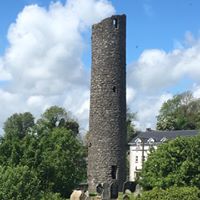
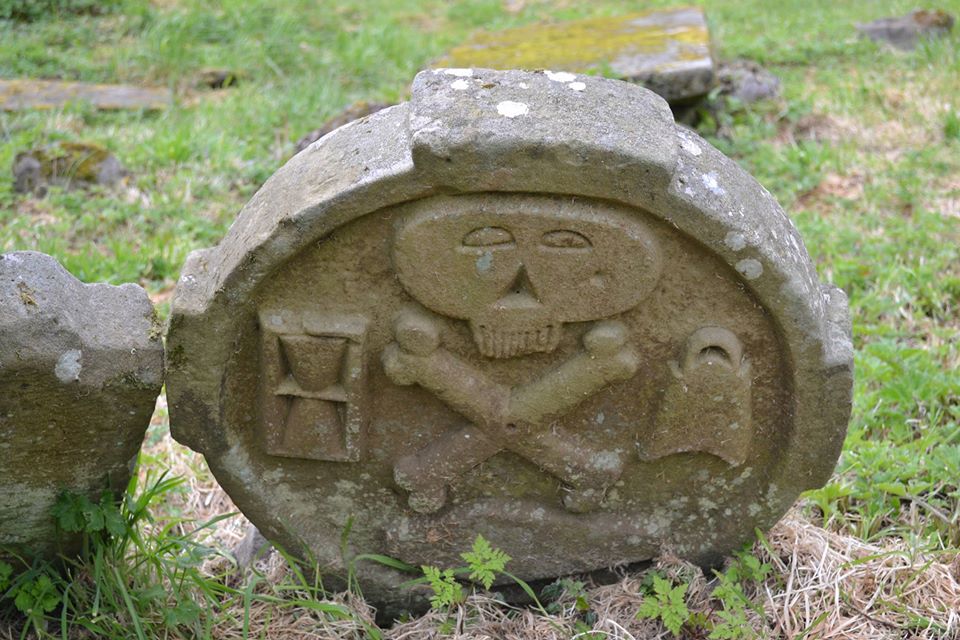
Day 25- Purple Vetchlings
These pea family members are scrambling through the lower grassy parts of hedges now, using their teeny curly tendrils to elegantly pull themselves up and wind themselves around other plants. Even though they rely on others for support, vetches give back to their neighbours by fixing atmospheric nitrogen into the soil. Vetches have a symbiotic relationship with nitrogen fixing bacteria; this aids its own ramblings and that of its neighbours. Very neighbourly.
They have little purple flowers, and pairs of leaves reaching up ending in tiny tendrils. Bush vetch or vicia sepium literally means vetch of the hedges as sepes is of a hedge. In Irish the vetches are Peasair vicia.
Later in the year, little brown or black pea pods will develop on the vetches.
Vetches provide important source of pollen and nectar for bumblebees, our little fluffy piled batteries of nature, which are in decline and need a variety of flowers and plants from early spring to ensure their survival. It seems that bees see the colour purple more easily than any other colour. Pollen is their protein and nectar their sugar.
Today 30 April is Poetry Day Ireland and so to quote some lines of Patrick Kavanagh…
Dead in a Ditch
(To Hilda)
Unless you come
I shall die in a ditch,
Poet dead in a ditch.
There will be no bluebells there,
Only the vetch
Smelling of death
Weeds around me,
The mud of hooves
That prance there
Falling over my eyes.
Patrick Kavanagh 1945
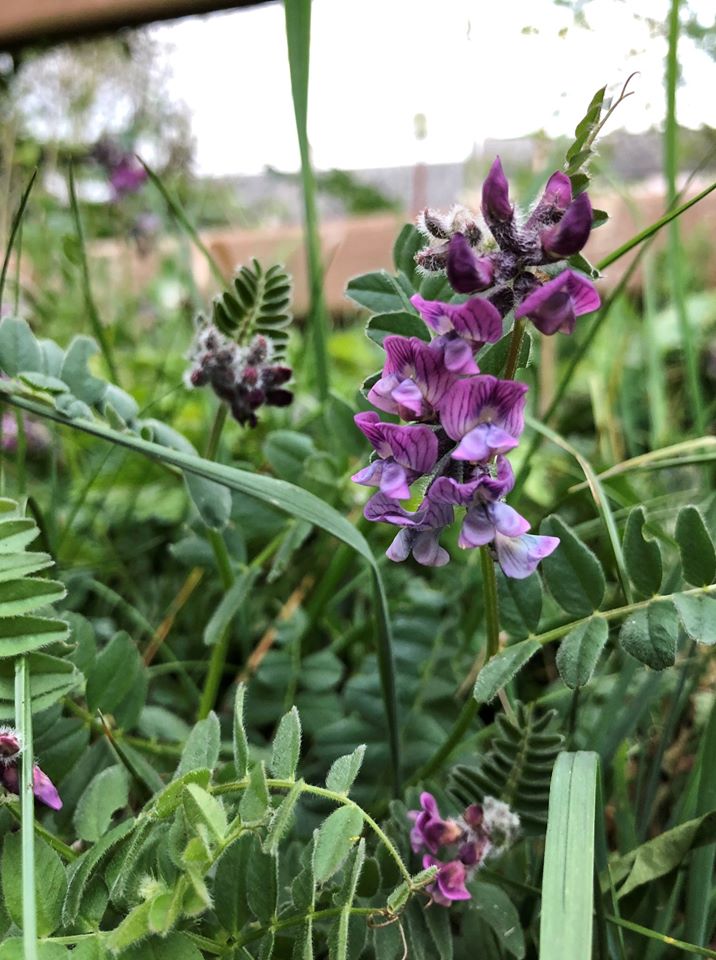
Day 26- Megalithic Court Tombs or Giants Graves
Surviving through 6,000 years of immense cultural and ecological changes is no mean feat, yet at least 19 examples of court tombs remain in Monaghan. Part of megalithic tombs types (mega – large, lithic – stone), these are often called Giant’s Graves on the old maps and in memory.
Court tombs have U-shaped open roofed court-yards set in front of a long covered gallery or cairn. Inside the gallery there is often 3-4 or more rooms or chambers into which cremations were placed. The tombs were used over centuries. The old burials were often pushed aside to make room for new ones. The courtyard, which was flanked with large standing stones is thought to have been used for long forgotten rituals, wakes maybe, fires perhaps, to do with the ancestors held within.
A tremendous example of a court-tomb was at Cashlan, long since destroyed but it is worth the effort to read the 1841 and 1897 reports on the National Monuments website, and to see the plan of the chambered cairn that was drawn at the time. It is part of the collection of these tombs in the Newbliss area. Its reference number is MO012-080
Aghnafarcan or Ath na Farcan, Ford of the Oak, or alternatively Achaidh farcáin, meaning field, has a giant’s grave called ‘Minnavarmore’. Recorded in the Irish Folklore Commission collection is a folk tradition of a Scandinavian giant called Manowar, who came here to kill Finn McCool. Fearing the giant, Finn disguised himself as a baby, and bit Manowar on the finger. Naturally enough, if this was the baby, no doubt he thought, what is that father like? In any event, the Scandi giant tried to leave but mysteriously dropped dead, and hence ended here in Farney.
In absence of access to photographs at the moment, here is an outline of a court tomb from nearby County Tyrone.
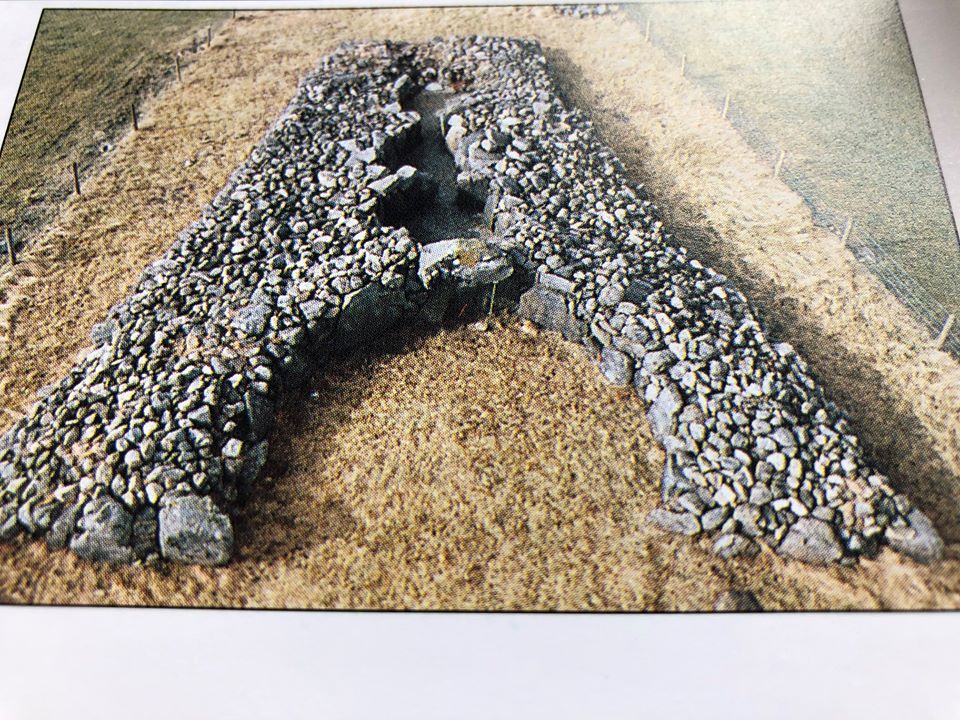
Day 27- Orange tip Butterfly
This striking and beautiful butterfly has a dark side, and by that I refer not to its green marbling on the underwings, which is in fact made from black and yellow scales, but to its cannaballistic nature. Yes, that is right, the caterpillar will eat any eggs and competing caterpillars it finds on the same plant.
Orange tip butterflies are attracted to cuckoo-flower or lady’s smock, the mauve delicacy of the cabbage family, which has a circle of dainty flowers topping off a soft stem. Cuckoo-flower favours meadows and verges with low nutrients or low fertility and low stocking density so less grazing.
Its latin name Cardamine pratensis means watercress of the meadow, and the butterfly complements this, it is named Anthocaris cardamines or Barr Buí as gaeilge. Yellow tipped. Only the male butterflies have the orange tips though, so the sexes are easy to tell apart.
It lays its wee eggs on the stalks of the cuckoo-flower, which are at first a pale green changing colour to a vivid orange. The caterpillar is green with a white line along each side and will eat the developing seeds and fruits of the flower and other younger caterpillars. Survival of the fittest rules the roost.
An old Irish poem praises the cuckoo-flower (Bioloar Gréagáin), where it grew in Gleann Ghualainn at the time of the warrior fianna. It was deemed to be good for nervous afflictions like hysteria. Considered to be a flower of the fairies, whose magical powers are to be respected, it is not to be picked and brought into the house for fear of been struck by lightning. Its name cuckoo-flower may be because it blossoms around the time of the first cuckoo calls. The alternative name Lady’s Smock may derive from its wee circlet of flowers which look like smocks blowing in the wind as they are hung out to dry.
This weekend the National Biodiversity Data Centre are asking us to record sightings of the Orange-tip butterfly. You can find them easily on twitter, on Instagram or their wonderfully informative website www.biodiversityireland.ie
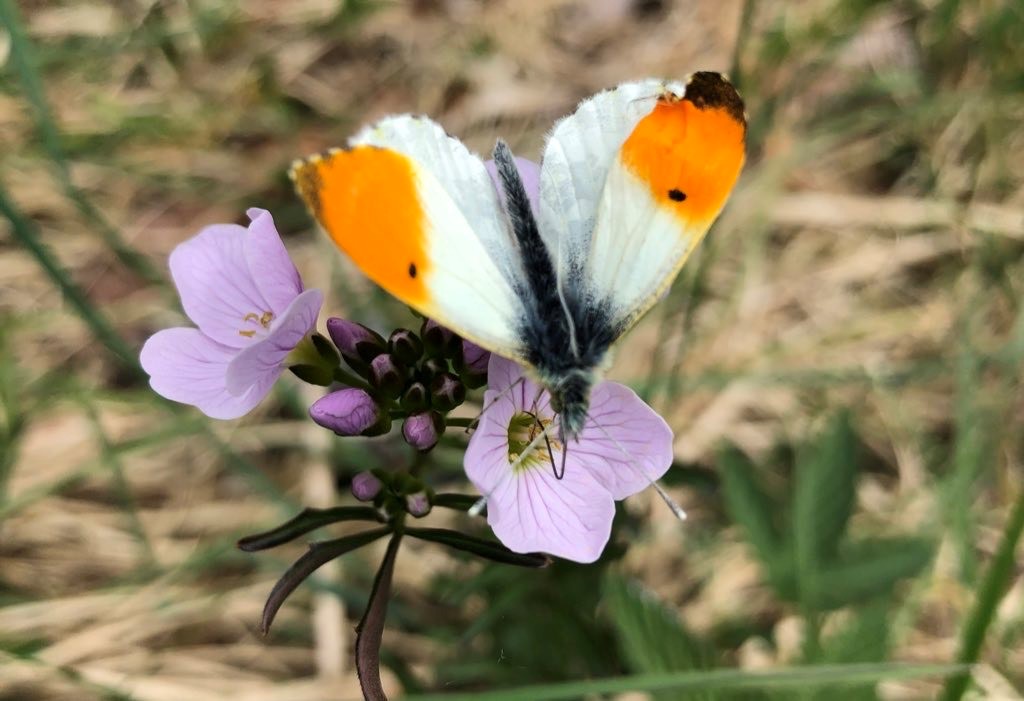
Day 28-Home fires & vernacular homes
In the vernacular or traditional houses in Monaghan, till after 1600, houses had a free-standing hearth with a simple smoke-hole in a central position of the roof ridge, and the pot hung from the central roof timber. Very smokey and dark.
The innovation of a hearth and chimney style houses from the 17th century, must have brought great clarity and relief from the smoke. A canopy made from hazel – wattle and daub, or wickerwork was positioned on the gable wall of the house over the hearth. This was a big pyramidal flue essentially, which was plastered with mud and straw and then limewashed. Its top is recorded as protruding above the roof ridge, was obvious from the outside – a kind of chimney.
The big canopy was supported on a timber that ran across the width of the house, supported on the side walls. Flanking the hearth was often niches called keep holes, sometimes with doors, used to keep things like salt dry or for other bits and pieces, pipe and sewing are recorded. The blacksmith was able to forge cranes on which to hang an assortment of pots and skillets. Some of these cranes were decorated, a little flourish of pride in the new arrangement.
The canopy and the brace beam on which it was supported allowed the homes to have a half-loft either side of the hearth. Warmer places for sleeping than before. Often called the thallage in Ulster, this seems to be anglisation of the word tailleog meaning loft.
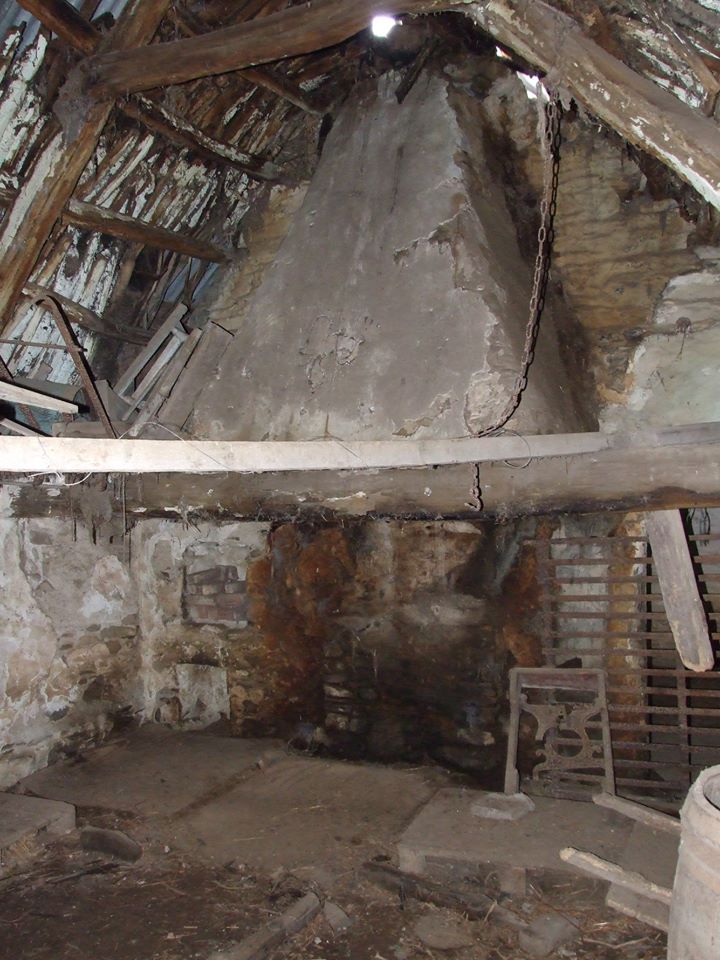
Day 29- Herb Robert
This is a gangly, leafy plant when it is growing in spots that suit it, but it is a tough cookie and will grow in suppressed conditions like cracks in pavements and on stone walls but looks dried out and stumpy there. In all places it has gorgeous dainty red-pink flower, and often red stems. In Autumn, the leaves can turn pink or red. It is in the hedgerows now.
Herb Robert is an unusual name, and thought to be a corruption of Herba Rubra – Red plant, not Robert Plant, although wouldn’t it suit a Led Zeppelin band member? It is a species of crane’s bill, or geranium, and as gaeilge it is Crobh or also Ruithéal Rí.
Medicinally, its bright red stems were used to cure cattle from red water fever – fire fights fire. It was also used to staunch bleeding, treat kidney problems and sore throats.
When its flowers hang it is a sign of bad weather, and do not bring it indoors for it has an unpleasant smell and hence another name – stinking bob.

Day 30- Rowan or Mountain Ash
This commoner of the wood, according to the brehon law texts, is quietly bursting into flower now. Minute umbels of creamy white flowers erupt from tight little pearly balls, sitting proud above the toothed leaves. Pollinators, especially bees and flies are attracted to its flowers.
Later in the season, there will be clots of rowan berries in their place, much revered since ancient times and found in old stories and poems. A Seamus Heaney translation of ‘Sweeney Astray’, a poem about Suibhne Geilt, king of Dál Araide, one of the kingdoms of Ulaid (Ulster) finds that-
“scarlet berries clot like blood
On mountain rowan”.
Birds, especially thrushes like their berries, but they do not digest the seed within, so new seedings are propagated by being passed in their droppings.
Its scientific name is Sorbus aucuparia. Its Irish name Caorthann, refers to caor, which means burning flame. Rowan is associated with the month of May, and the first smoke from a chimney on a May morning should be from the fire of rowan. It was used to protect cattle and was tied to their tails to save them from fairies. In some old poems it was referred to as the fid na ndruad, the druids tree. They apparently used it for divination. Spells.
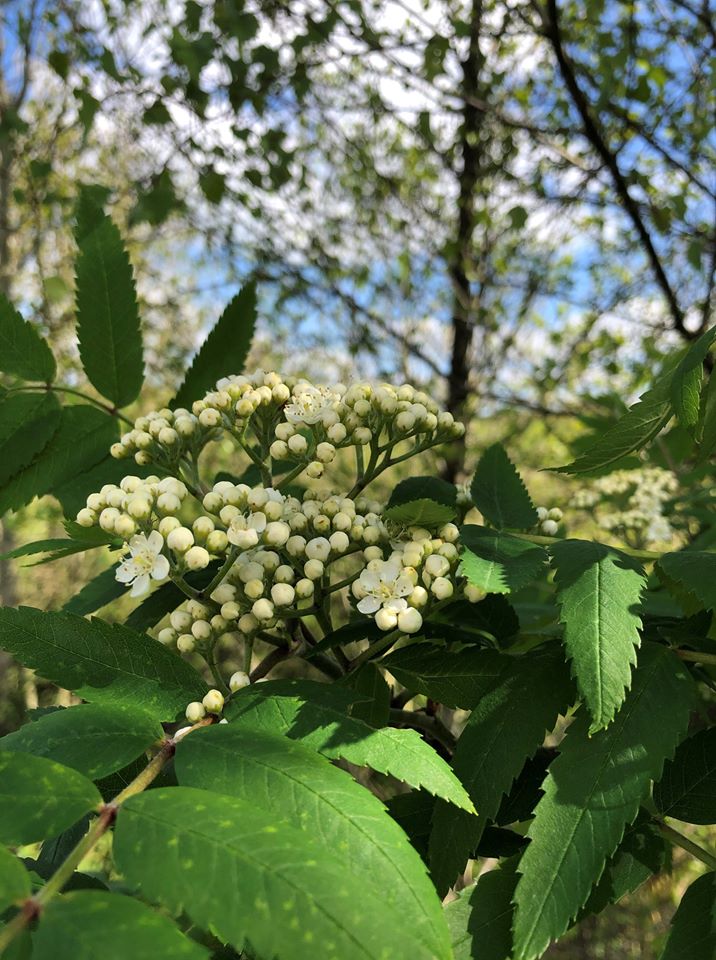
Day 31- Waterwheels
It is a clever and simple invention to capture the power of water, by spilling it into cascading buckets on a wheel, making it turn cogs and shafts. The industrial process of casting iron, pouring liquid iron like lava into moulds enabled the combination of timber and iron to create waterwheels.
Fred Hamond conducted an industrial survey of mills some years ago for the Monaghan Heritage Office. He identified 193 locations where mill once operated in the county, 165 of which used the renewable energy of water to power them. The water was abstracted by constructing a weir across a river or stream to divert some of it, so that it arrived at the waterwheel at a higher level than the river. The largest waterwheel, 25ft in diameter, in Monaghan was at Tullygillen Corn Mill, a few miles south of Monaghan town. Locally called corn, oats grew better in wet Monaghan soils than wheat so small corn mills were more common.
Neal Doran (1849 – 1937) of Derrynoose and Doohamlet, penned songs of local interest, people and places, that were recently compiled into a book by John Makem. Here are the first two verses of “The night of the big wind” –
In the year eighteen hundred and just sixty-four,
The likes in this country was ne’r seen before
The wind and the divil they made combine
And on that day they left nothing behind.
The flax over hedges and ditches was blew,
And besides all the stooks in the fields they were threw
The corn was threshed into straw on the hills
No business at all will we have for the mills.
The photo is of New Mills, Kilcran, outside of Glaslough. This fine mill has an internal waterwheel.
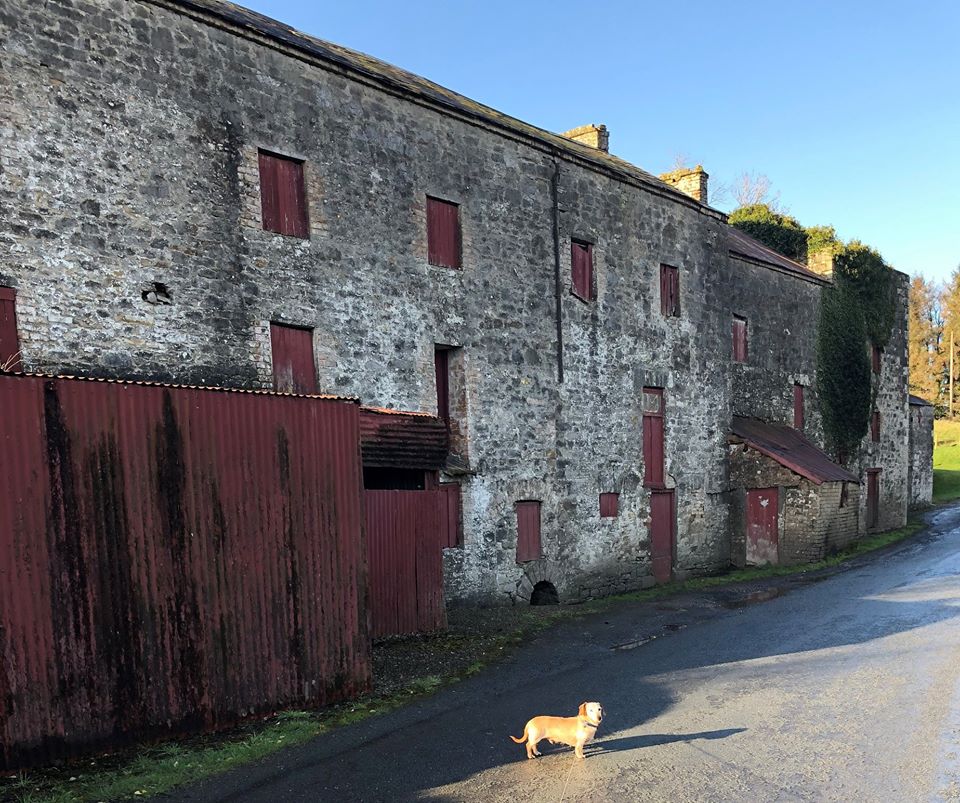
Day 32- Mostly known as Bulrush
You will recognise this plant immediately, no matter what its’ given name, by the tall sausage shaped heads, vegan of course. The brown shaped sausages are actually a collection of teeny flowers that make up the inflorescence. Variously known as bulrush or reedmace it is one of the tallest grasses that grows around the margins of lakes, in canals, and transition mires (which are a stage in the development of lake to fen to bog). Its scientific name is Typha latifolia.
The underground rhizomes are edible. Evidence of preserved starch grains from bulrushes have been found on grinding stones in Europe 30,000 years ago. The green long flat leaves have been used in cooking as well, and the fluffy seed heads were used for lining baby baskets in Finland.
It flowers in the spring and the male and female flower clusters are borne on the same stem. Reedmace produces huge amounts of seeds, which are equipped with tiny parachutes to help them disperse with the wind. The photo taken at Killyboley Lough shows the fluffy seed head, honestly looking very otherworldly.
It is no surprise then, that as gaeilge it is Coigeal na mBan Sí, the fairy woman’s spindle. A spindle is a slender rod used in hand spinning to twist and wind wool or flax. Possibly she was winding thread to weave some class of invisibility cloak, as used more recently by the well-known wizard Harry Potter.
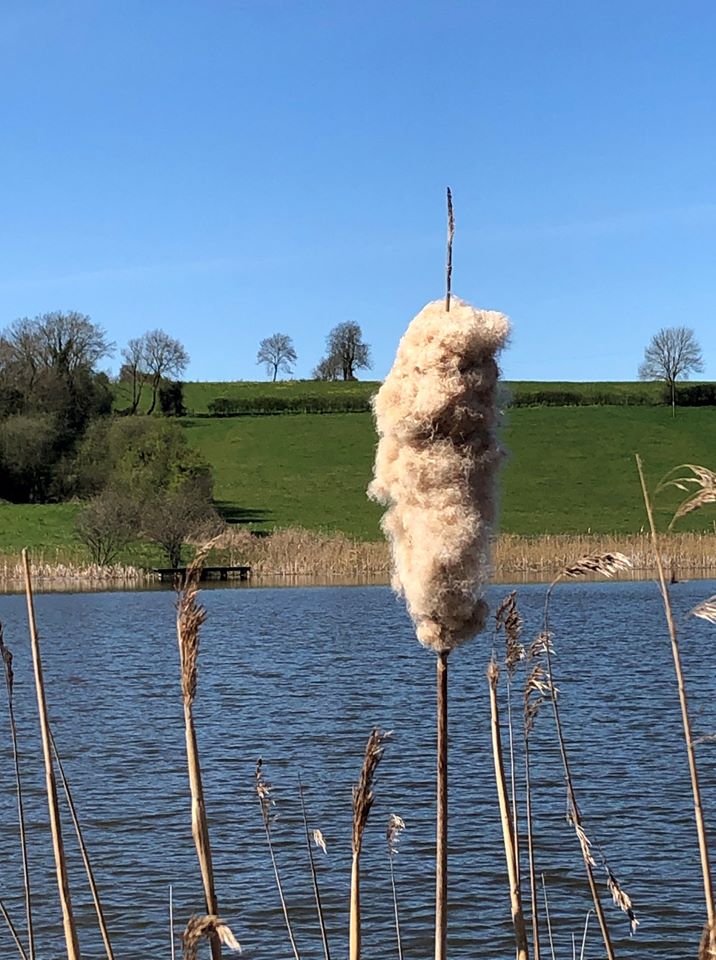
Day 33- Gothic Monaghan
Today for Heritage Happenings we are launching our film ‘Gothic Monaghan’ online. Filmed three years ago, on locations in County Monaghan with a few shots from France, this film looks at the fashion for gothic architecture in the landscape of Monaghan, Ireland and traces the evolution of the style through old church ruins and abbeys. Presented by architectural historian and author Kevin V. Mulligan and heritage officer Shirley Clerkin, directed and filmed by Dara McCluskey, its’ premier showing was at the International Clones Film Festival in 2017. The film was funded through the Heritage Council and Monaghan County Council.
Locations include Magheross Old Church, Killeevan Old Abbey, Clones Round Tower graveyard, High Cross and wee Abbey, Lough Fea House, Bessmont House, St. Josephs Carrickmacross, Adragh Church, Cahans Presbyterian, St. Patricks Church Monaghan, St. Macartan’s Cathedral and many more.
Day 34- Lost Book of Drumsnat
Where the lost things go?
In the latest Mary Poppins film Emily Blunt sings about the lost things. Two of these particular lost things, the lost book of Drumsnat and the chest of gold fallen to the bottom of the lake would create more than a musical response if discovered.
Drumsnat Monastery, between Monaghan and Clones, was founded by Molua MacOche of Kyle, Killaloe and of Drumsnat in the 6th century. He studied with Comhgall at Bangor and performed many miracles for which is was named “Servant of the three nines”. He died in AD 609 aged 55.
Mullanacross, Mullach na Croise, Hill of the cross, where the monastery is said to have stood, now has an old graveyard with some interesting stone markers, and more recent headstones, still overlooking the pretty Drumsnat Lough. It is called Drumsnat, Droim Sneachta, Hill of the snow due to the sign of snow covering the landscape un-seasonably in June and on that basis Molua established the monastery here.
The lost book of Drumsnat, Cin Droma Sneactha was written here in the 8th century, which is the oldest known manuscript to contain Old Irish Saga material. These epic sagas or stories were highly complicated prose and poetry brimming with tragedies and drama. The Cin is referred to in many later books, but alas it has not been found.
As for the lost gold, well it is said in the folklore that when St Patrick banished the serpents, a great chest of gold fell into the bottom of Drumsnat lough. A serpent has been coiled around it guarding it since.
The drawing is a reconstruction of early timber church at Drumsnat, overlooking the lake by Philip Armstrong. This was drawn for the soon to be published conservation plan for Drumsnat Monastic site, by IAC for Monaghan County Council Heritage Office.

Day 35- Purple blues – the bugle and the dead nettle
Two little purple gems of the woodland and verge edges are peeking out now, adding that purple dash of colour that is so perfect amongst the green.
The Red Dead Nettle is related to the mints, and non-stinging as its name suggests so you can grasp it without fear. Dead nettle has a square stem and an unusual flower shape, a sort of hooded tube in purple, and the leaves can also have the purple tinge. Its Irish name Neantóg Mhuire, Mary’s nettle.
Bugle is slightly bluer, and its grows as tiny turrets of dark colours in drifts at the edges of woodland or on old verges. It likes damp but limey conditions. It is Glasair choille in Irish was used in the past as a cure for ulcers and gangrene.
Look out for them, they are pleasant to see and to know. Prepare to impress others by grasping the dead nettle.
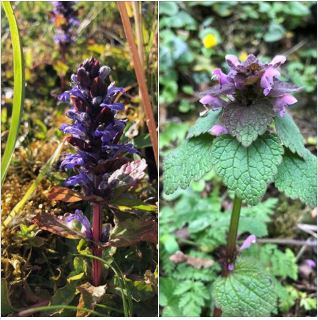
Day 36- Signal Cabins
The Ulster Railway started life in 1837, initiated by local businesses who wished to join Belfast with the linen milling centres around Armagh. By 1876, many lines had been completed through the complicated topography of the wetland – drumlin south areas into Monaghan and Cavan, line guages were standardised and the Great Northern Railway company incorporated. In County Monaghan there were fourteen railway stations.
Signal boxes were an advance in safety for railways and integral to the busy transport infrastructure. They allowed rail staff to safely observe nearby trains and to control their movements. The boxes were designed to a generic standard and could be sized up or down depending on the levers required inside, without compromising their aesthetics. All was considered, type of brick, timber for windows, bangor slates for the roof. They are instantly recognisable as to their function as a result.
The photo shows the rebuilt Glaslough signal cabin, reconstructed faithfully to the original design by the local community. Railway stations varied in their designs, some were classical, italianate or in Glaslough – gothic, but the cabin boxes are a pleasing punch of replication except for the name of the station above the door.
Sadly, the GNR lines in County Monaghan closed in 1957.

Day 37-Private sculpture or public art?
There are a number of Black Islands in County Monaghan, but only the one with a life-size white sculpture. Amidst the former Dartrey Estate, situated on the island is a grief-stricken group of marble figures dating from 1774, housed in their very own classical temple.
The entire ensemble was commissioned by Lord Dartrey following the death of his young wife Anne in 1769. The temple is just that, it is not a burial place or mausoleum, but a memorial sculptural set, designed to be visible from his house, a private yet public declaration of love or maybe to record in stone his own grief. The square classical temple box in which it is housed was designed by James Wyatt. It has no windows, one light source only from above through the domed roof.
The marble figures and funerary urn are of Lord Dartrey himself, his young son and a beautiful angel with large feathered wings, gracing a cloud. The entire arrangement is most affecting. The sculpture was designed and carved by Joseph Wilton, one of the founding members of the Royal Academy.
After the estate was dismantled, the temple and sculpture fell into a ruinous state in the late twentieth century. One of the most amazing aspects of the story is the rescue. Through the valiant efforts of the Dartrey Heritage Group, the temple and Wilton’s grieving figures were rescued and restored in the early 21st century. The light shines on them once more.
The photo shows Noel Carney from the Dartrey Heritage Group at the sculpture in 2015.

Day 38- Crannógs
A high proportion of our ancestors in the drumlin-wetland landscape were water people, living on artificial islands on lakes. Social distance by means of a watery protection, and a timber palisade which generally surrounded these sites.
Crannógs were built up with layers of stones, gravel, peat, brushwood, upon which the dwelling was built.
Archaeological investigations have shown that there was a wide time period of construction, from at least the bronze age to post-medieval times. Up to a few hundred years ago, therefore. Dendrochronology, or dating analysis of the timbers suggests a major period of building during the 6th and 7th centuries.
In Monaghan there are almost 90 recorded examples, in which antiquarians of the 19th century became interested when the agricultural drainage schemes dropped the water levels in lakes making the sites more visible and accessible.
E.P. Shirley of Lough Fea, Carrickmacorss investigated the Monaghan crannógs of Drummond Otra in Loughnaglack, Drumbo in Rahans Lough and Monaltyduff in Monalty Lough.
Artefacts from crannógs show that the sites were of high status, with evidence of metal working and crafts – bronze pins, knives and blades, thimbles, glass beads; tillage, commerce, music – harp pegs; food storage and fighting.
The St. Louis Secondary School in Monaghan town may be the only school in the country overlooking its own crannóg, that of the McMahons, now in the Convent lake, Mullaghmonaghan. This was MacMahons caislean or castle of MacMahon mentioned in 1492. The tops of four oak piles can be seen on the northern side still, and the boulder kerb can be seen beneath the water. Old maps and drawings show that once it had a slated house situated upon it.
The photo depicts part of the 1591 map of Monaghan showing Franciscan Abbey and Macmahoones house on the crannog, copied from the Historic Monument Viewer.

Day 39-Not so humble Bumblebees
Charles Darwin noticed that “humble-bees alone visit red clover, as other bees cannot reach the nectar”. Humble not bumble bees was an old name, not in use since world war two, and Darwin was referring to their long tongues which allow them to collect nectar from flowers that are closed into a tube.
Bumblebees are plump, fuzzy, stout flying bees with bands of colour making up their dense pile, their varying stripes a good aid to tell which species is which, together with their tail colours in Ireland of white, buff or red. They can sting but they have no barbs on their sting so can survive an encounter. Bumblebees form small colonies with one queen. There are 14 species of true bumblebees in Ireland, and 6 cuckoo bumblebees which as their name suggests don’t bother making their own nests but invade instead, kill the resident queen, lay their own eggs which are then cared for by the workers.
Bumblebees usually forage within 200-500m of their nest, generally an underground disused mammal burrow, but the new queens will travel from 1-5km away from their birth nest to establish their own colony.
Sadly, due to habitat loss, pesticide usage and other human impacts one-third of all bees species in Ireland are threatened with extinction. As three out of every four wild bees is a bumblebee and we rely on them to pollinate fruit and vegetables this is very bad news. We drastically need to improve habitat, shelter and food for bumblebees and every little bit makes a difference. Check out the All-Ireland Pollinator Plan website for resources and easy things you can do for bees at pollinators.ie and check out Gardening for Biodiversity by Juanita Browne available online as well.
J.K Rowling is an admirer of bumblebees and named the headmaster of Hogwarts in the Harry Potter books after an old name for the buzzy fuzzy batteries of nature – Dumbledor – “one of his passions is music and I imagined him walking around humming to himself”.
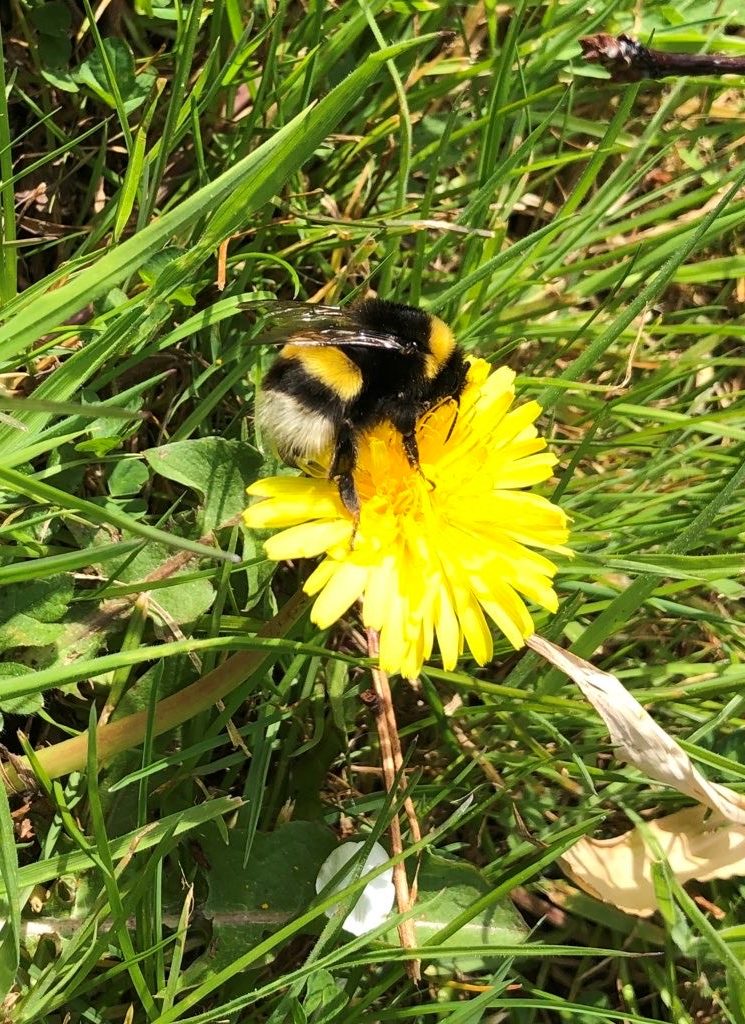
Day 40: The majestic bird of the uplands – Hen Harrier
Initially, it was thought that male and female Hen Harriers belonged to two different species, so unalike they appear – a touch of the “men are from mars, women are from Venus,” but that is all sorted out now. They are a majestic, daring and protected bird of prey, found in the uplands, and on Sliabh Beagh – the upland plateau joining Monaghan, Tyrone and Fermanagh.
Their scientific name Circus cyaneus captures a part of their behaviour and personality, astonishing circular aerial acrobatic displays called sky dancing which the male performs to impress the female during courtship. She is hard to impress. The male rise high in the sky and then suddenly plummets to the ground in a series of somersaults, twits and corkscrews, to all intensive purposes seemingly bound to crash, when he halts his screech to the ground and rises upwards again. He can perform these dances for twenty minutes, a demonstration of stamina and daring.
The female though, can fly upside down and catch food mid-air that the male drops to her which she then feeds to the chicks.
The male is grey mostly with black wing tips, and the female is mainly brown. The food they expertly hunt consists of small mammals, and sometime small birds, and even occasional frogs. They breed from March to September, and it is crucial at this time not to disturb their nests, or foraging areas.
In Irish, Hen Harrier is Cromán na gCearch which could translate as Hip Hen, which of course they are. No other bird can undertake the flights of fanastical fancy of the Hen Harrier. We are privileged to have them in Monaghan under our protection. We have a duty of care to these birds and should not deprive the skies of their wonderful acrobatics.
Farmers are taking part in the Department of Agriculture scheme for the Hen Harrier in Monaghan currently and it is hoped that this project together with the interreg CANN project which also is working to protect Sliabh Beagh will be successful in their aims to restore nature.
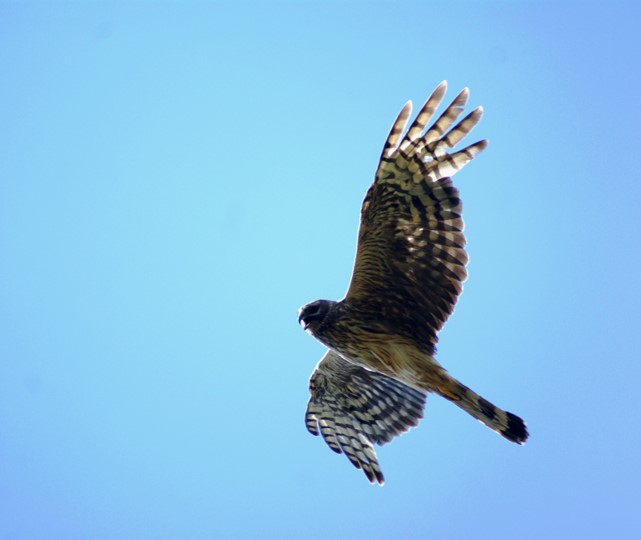
Day 41-A noble of the wood and hedge – the Ash
The Ash tree or Uinnius or fuinseóg is the commonest tree found in our hedgerows. Always the laggard, they are finally leafing out now. According to the seventh century Brehon laws, where trees were ranked according to their usefulness, the ash was a one of the Airig fedo or seven nobles of the wood. The fines for damaging a noble was two milch cows and a three-year old heifer. Ash was useful for making hurleys (camán), spears, furniture, boats and other agricultural implements.
Sacred trees with a special place in the Irish landscape are known as bile. Bile Maedhbhs’ are said to have sprung up wherever Queen Maedhbh planted her horsewhip, which were made of ash. In addition, three of the five great trees of Ireland were ash. Bile Uisnigh at Uisnach, Bile Tortan at Ardbreccan (County Meath) and Craobh Daithi at Farbill (County Westmeath). Craobh means branch. Ash has stout grey twigs, with large leaf scars and black buds – easily recognisable along with its opposite pinnate leaves.
You will see it coming into leaf close to you now. Give the tree an appreciative pat or nod, as it’s an often overlooked species because it is ordinary and commonplace. We might only miss it when it is absent from our places. It is hoped that the Ash Dieback which is threatening so many of the trees at present, can be beaten by this noble of our hedgerows.
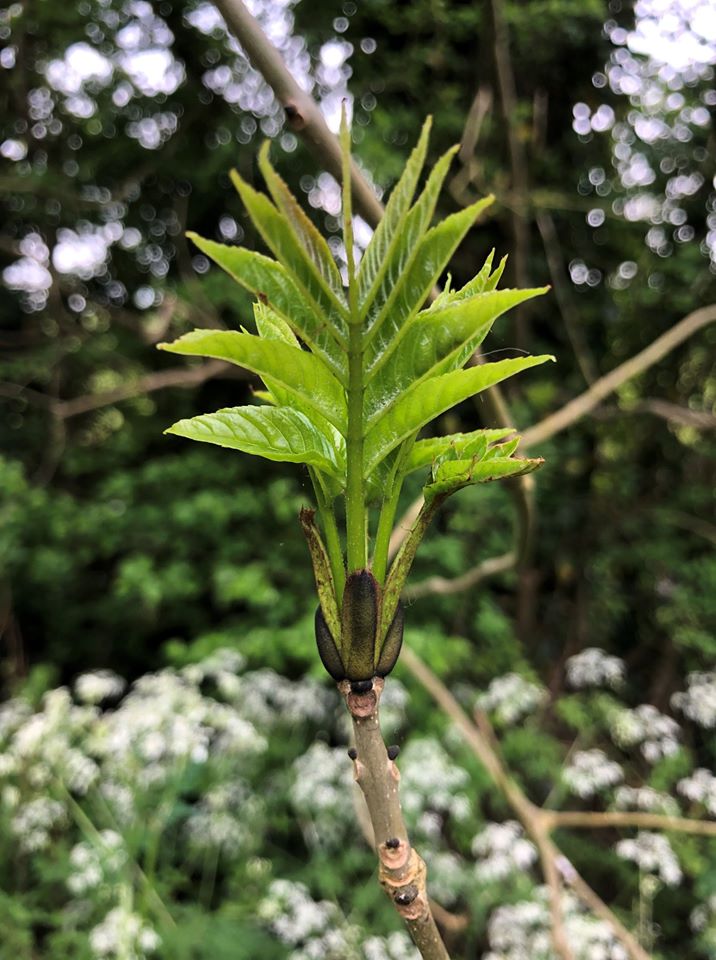
Day 42-The bright eye of the speedwell
These small four-lobed flowers, bright blue with a white eye in the centre are commonly found now along hedgerows, edges of woodland or in grasslands. Called speedwell, as they seem to wish good fortune to the traveller, they are also called Eyebright in ulster. They creep and wrangle their way upwards, with shapely leaves of about 1cm, and white hairs on their stems, ornamented with the startling blue flower, with two conspicuously draping long stamens.
Germander Speedwell, which is this specific species, is Veronica chamaedrys. The veronica species are so named, after the saint who wiped sweat from Jesus’s brow as he carried the cross. ‘Vera icon’ means true image.
In Irish, eyebright is anuallach, which possibly derives from humble-minded.
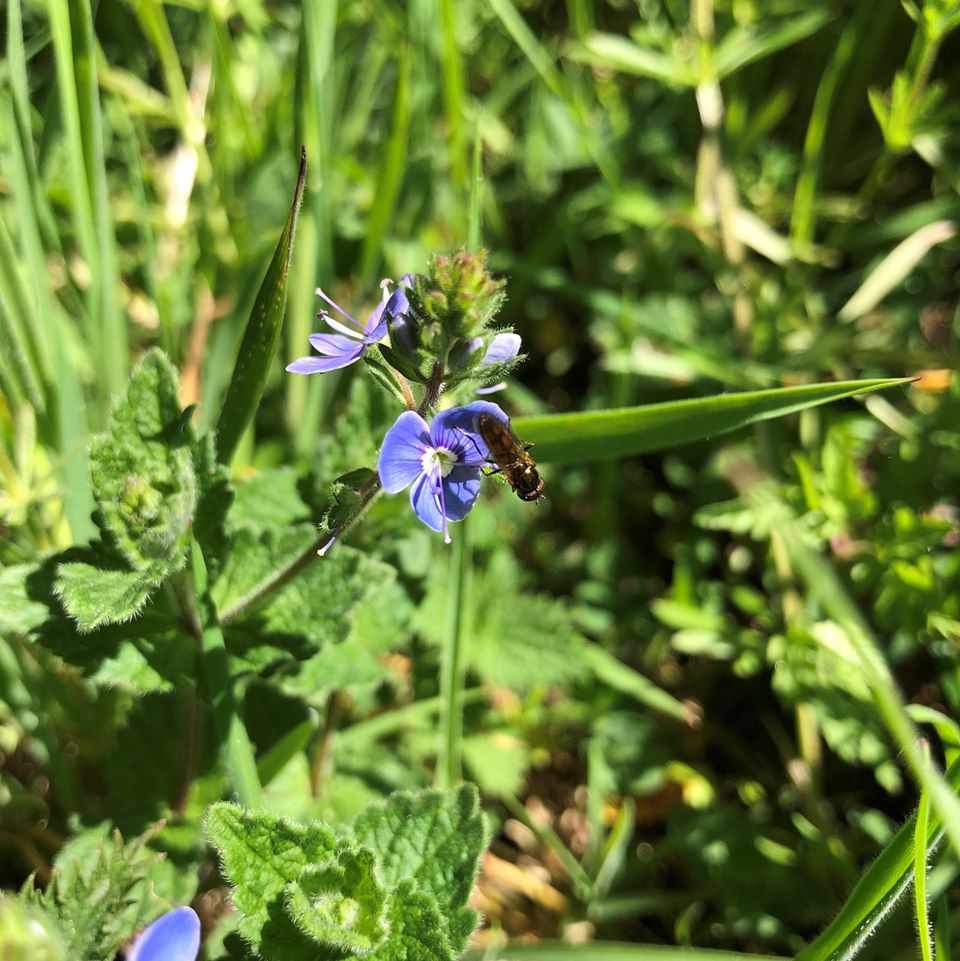
Day 43-Red Clover
The red globes of nectar rich Trifolium pratense is popping up now on road verges, fields and under hedges. Its leaves form a trefoil, like a shamrock, only larger and they often have a crescent pattern on them which bring a pleasing continuity across the leaves.
In Irish, it is Seamair Dhearg, and is one of the plants that was identified as the Irish emblematic “shamrock” in 1893, and again in 1988 when Charles Nelson repeated the survey.
Red clover is a pea species and can fix nitrogen in the soil and is very nutritious plant for livestock. Bumblebees too are very keen to suck the nectar out of its juicy pink-purple flowers. In the past, it had medicinal uses, as a cough remedy and for bee stings.
Clover appears as a symbol of prosperity and fertility of the land in early Irish myth. A story in the Dindshenchus describes how Tailtiú cleared rough ground until it became a plain blossoming with clover. She died from her labours, however, and a fair was held every year to mark her clover meadow, at Teltown, Co. Meath.

Day 44-Gate lodges
Once there were well over two thousand of these porters houses in Ulster, built to manage the entrances to the gated estates and as houses for the porter and his family. Well over half of these are now demolished or fallen into complete ruin. In contrast the larger house contained within the walls, the gate lodges were visible to all, a hint of what was to come inside the estate and a contrast to the vernacular small cottages built by the rest of the population. The divisions in society were maintained through architecture.
J.A.K. Dean describes them in his book Gatelodges of Ulster –
“In their size, style, placing and relation to other buildings they have much to tell us about their owners and about those who were expected to occupy them. Sometimes they heralded the style of the big house they shield. Occasionally, they were an architectural experiment, a test of style. Sometimes they were a remnant of an older style after the main house was remodelled.”
They were generally positioned at the gates, neatly behind the wall, or even as part of the wall itself, carefully thought out as one ensemble. These buildings are a valuable part of our social and architectural heritage, wonderful to see them in re-use as holiday lettings, offices and best of all as neat compact homes.
St. Macartan’s Cathedral in Monaghan finished its magnificent gates and screens with a victorian gothick gate lodge in 1884 by William Hague, the architect who completed the building of the cathedral after J.J. McCarthy died. Images of St. Macartan and St. Dympna, together with a bishops’ hat grace the stonework.
The Blayney Demesne originally had four gate lodges, three of which remain. The West Street lodges of 1860 are currently undergoing a phased programme of restoration by Monaghan County Council. The smaller lodge is now in use as office and community space, and the opposite larger lodge will be a new library for Castleblayney. Both beautifully frame the lime avenue to the main house and lake.
Castle Leslie in Glaslough had 6 lodges originally, all of which remain and according to Dean are “the most important and varied series of porter’s lodge buildings in Ulster, if not in Ireland”. They were all built within 75 years from 1800 – Gothick entrance (1812), Cottage Orné (1840), Tudor Romanesque entrance (1845), the Scots Baronial entrance on the main street (1875) and the Jacobean Entrance of (1878).
The photos are of the Scots Baronial entrance and the Jacobean Entrance to Castle Leslie, and the West Street lodge of Castle Blayney.
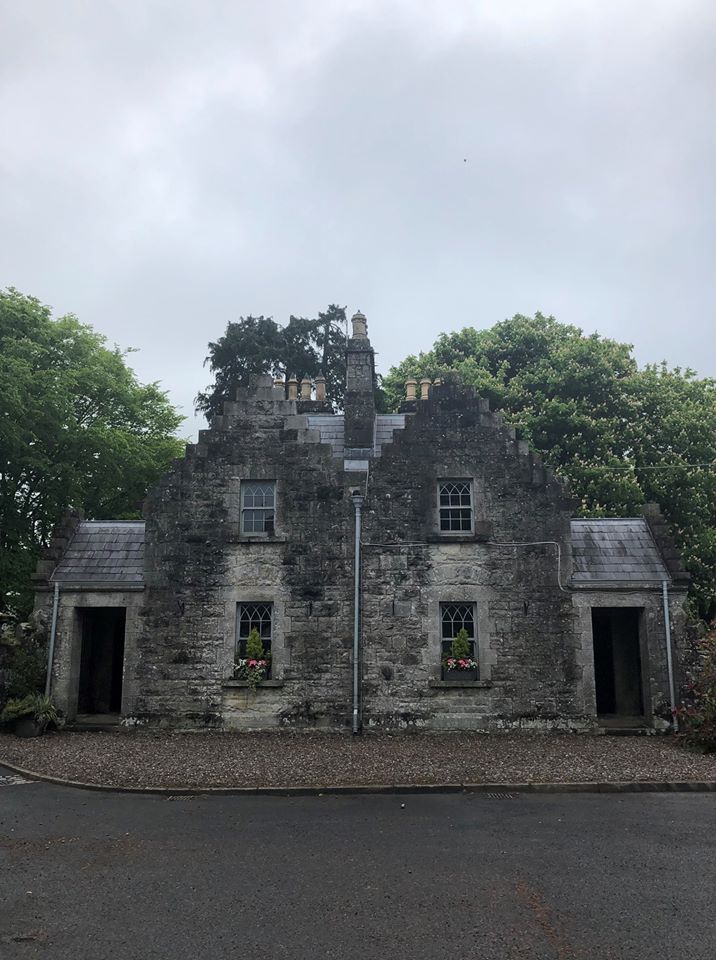
Day 45-World Bee Day
Today 20th May is World Bee Day.
Bees are vital insects which pollinate wild flowers, shrubs and trees, and also as cogs in the wheel of the agricultural and horticultural industries who rely on these largely unsung heroes. Their intrinsic qualities, buzzing, flitting, hovering behaviours and stripey bands of colour are just as important. They do not have to be useful, but they are, it is enough to simple be a bee to be a valuable member of It is no wonder that their appearance is often mimicked by other species like the hoverflies. They say they there is no higher form of flattery than imitation. But we should not want to be a society that wears bee costumes to fancy dress parties while the real things flounder due to our negligence.
Over one-third of bee species threatened in Ireland, yet we can decide to make a difference on our patch of the planet. Every garden is important and can be a place where bees and other wildlife are welcome.
If you mow your grass less often, plants like clovers and dandelions will grow – great food for bees. Or if you leave longer grass areas around the edges of your garden for example, you will provide them with shelter and food. Native hedgerows abounding in hawthorn, and native trees like willow all are part of the solution. It is clearly important is not to poison these little creatures, so please avoid using pesticides and weed killers. You can also plant herbs and flowers which attract bees.
The National Biodiversity Data Centre provide useful information on their website for pollinators at pollinators.ie. There are great animations, lists of suitable plants and simple ways to improve the life of bees in your garden.
Happy Bee Day.
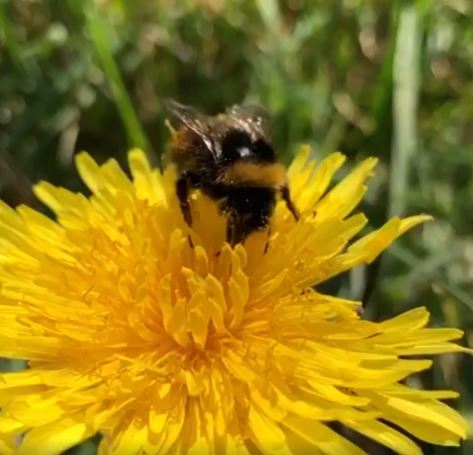
Day 46-Biodiversity Week
Biodiversity – our life support system
Nature’s own music. Birdsong. Hum of bumblebees. Dashing screeching flight past of swifts. Dandelion clocks floating past on the air. Fragrant boughs of hawthorn. Glut of tadpoles. Steadfastness of oaks. Soggy bottom of sphagnum moss. Dragonfly nymph emerging from water to go out on a wing. Caterpillars transforming to butterflies. Patterned colours of their wings. Hedgehogs snuffling. Foxes silently brushing past.
Although biodiversity is a big scientific topic, we can think about it in endless ways, and why not consider it through the lens of wonder? If we were to create a magical place to live, would it be concrete all about with bowling green lawns, silent except for the noise we make, colourless except for the dyes we mix?
Biodiversity is all about us, but it is in serious trouble because we have neglected to include our very own life support system in our decision making, failing to realise that our quality of life and livelihoods, and the equity of human beings is dependent on it. We must break the cycle of harm and disrupt the systems to create better ways of doing our lives.
Biodiversity is the variety of life on the planet and how it interacts with the natural water cycles and climate conditions to create ecosystems that provide habitats, and ecosystem goods and services. Goods like timber, healthy soil, raw materials for clothing, medicines – everything. Services like carbon sequestration, water filtration, pollination – everything we rely on.
This is Biodiversity Week. But everyday we depend on biodiversity. Take a first step and connect with the wonder of the nature this Biodiversity week. Find a quiet spot and listen to the sounds of nature about you. This is the sound of nature supporting your life.
We will have some biodiversity tips on this page all week.
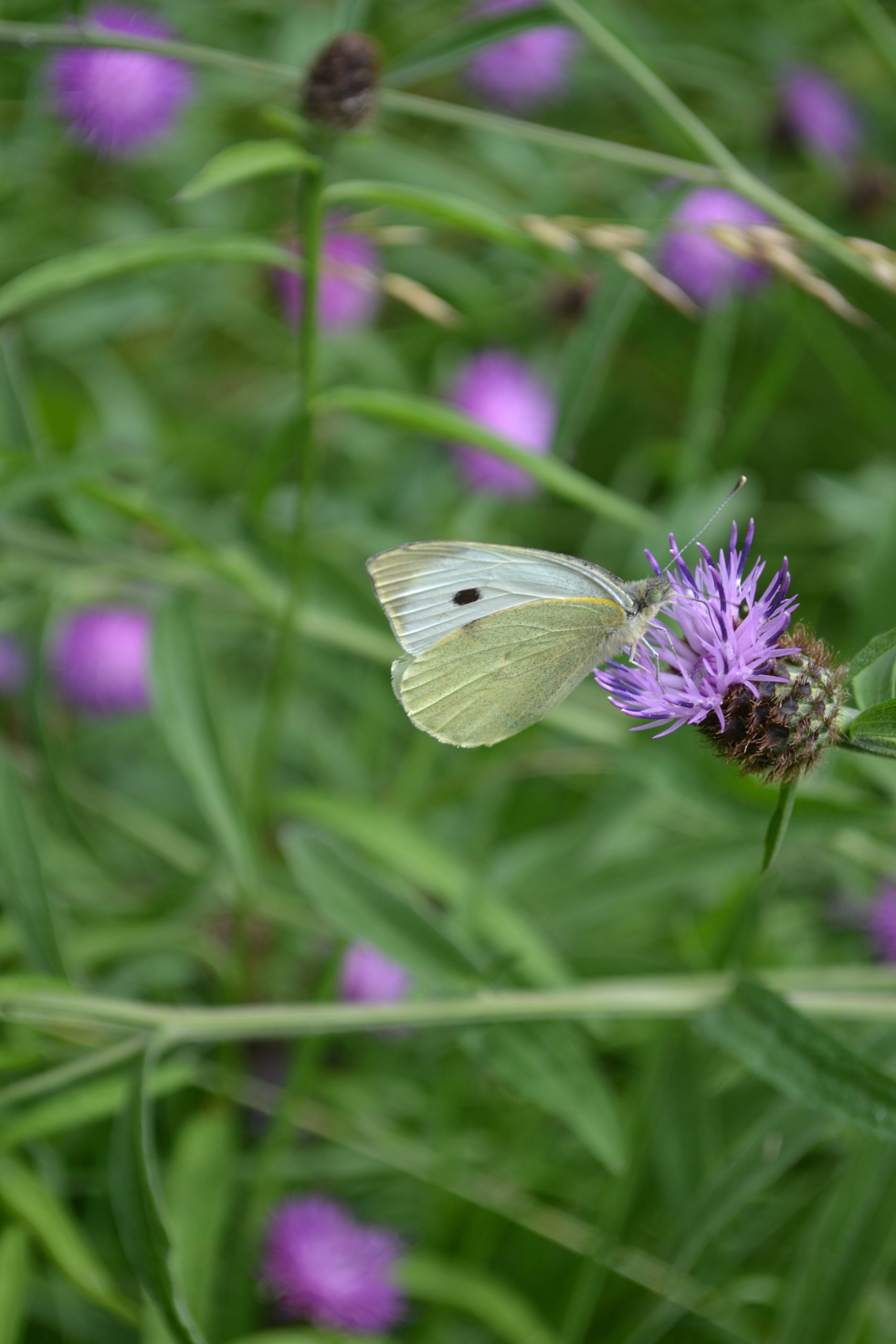
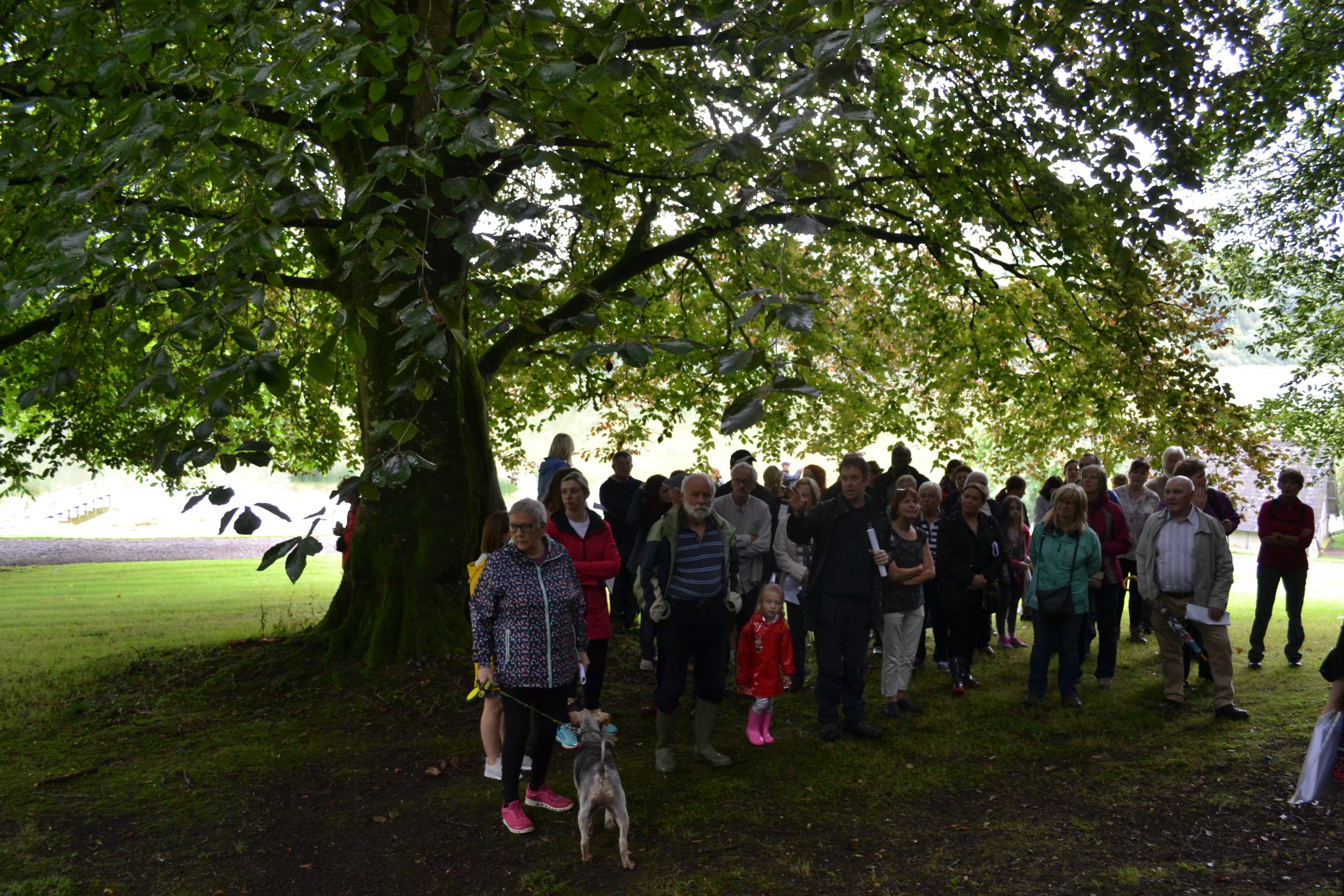
Day 47- Switch for Biodiversity
We want to live more harmoniously with nature. There are some simple switches that can be made that will set us on that pathway. Always the best place to start is where we can have the most influence, and for most of us that is our own homes and gardens. Today is International Biodiversity Day, no better day to start,
Here are ten SWITCHES you can make to benefit biodiversity right now:
1. Switch peat moss or compost with peat FOR PEAT-FREE COMPOST. Ask your garden centre. Or make your own compost. This will help protect our valuable bog ecosystems.
2. Switch your weekly mow to LET YOUR GRASS GROW. Leave an extra margin around the edge of your lawn and cut it every 3-6 weeks, to provide shelter and food for pollinators.
3. Switch tap water in your watering can to WATER FROM A WATER BUTT. Rainwater collected from your roof is a good way to re-use water and be more economical with treated water.
4. Switch plants in pots for PLANTS IN THE GROUND. These need less watering.
5. Switch pesticides for NATURAL PEST CONTROL AND COMPANION PLANTING. (Carrot fly is distracted by the smell of rosemary and thyme, plant marigolds or lady’s mantle close to tomatoes, nasturtium beside broad beans). Encourage ladybirds to your garden to eat greenfly.
6. Switch chemical fertiliser for NETTLE OR COMFREY FERTILISER. This is made by soaking the plants in water for a few weeks and then diluting the resultant liquid with water. Areas of nettles and comfrey are super for pollinators – bees and butterflies, so a patch has additional biodiversity benefits.
7. Switch cutting hedges at waist height to LETTING HAWTHORN HEDGES GROW TALL AND BLOSSOM. Vital for pollinators and will bring a wonderful sight and smell to your garden.
8. Switch tidying up to BUILDING A LOG PILE. Great spot for hedgehogs, bugs and beetles. The garden is not a place for Marie Kondo’s house tidying approach!
9. Switch planting the same plants everywhere to PLANTING VARIETY. This will protect your garden from being overrun with any one pest or disease, and bring more wildlife to your place.
10. Switch social distance for HUGGING A TREE.
Monaghan County Council has some copies of GARDENING FOR BIODIVERSITY available. This wonderful publication from Laois County Council, supported by the Heritage Council and the Heritage Officers is written by Juanita Browne and illustrated by Barry Reynolds. It is wonderful, and full of fantastic ideas for your garden. If you would like one to be posted to you, please email shclerkin@monaghancoco.ie and we will arrange it.
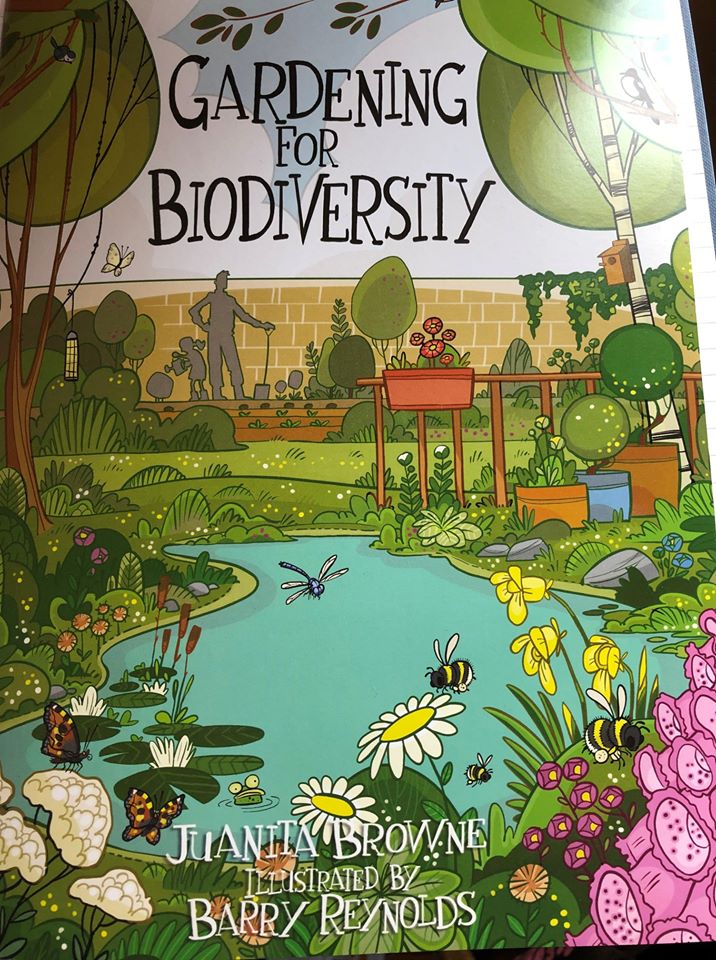
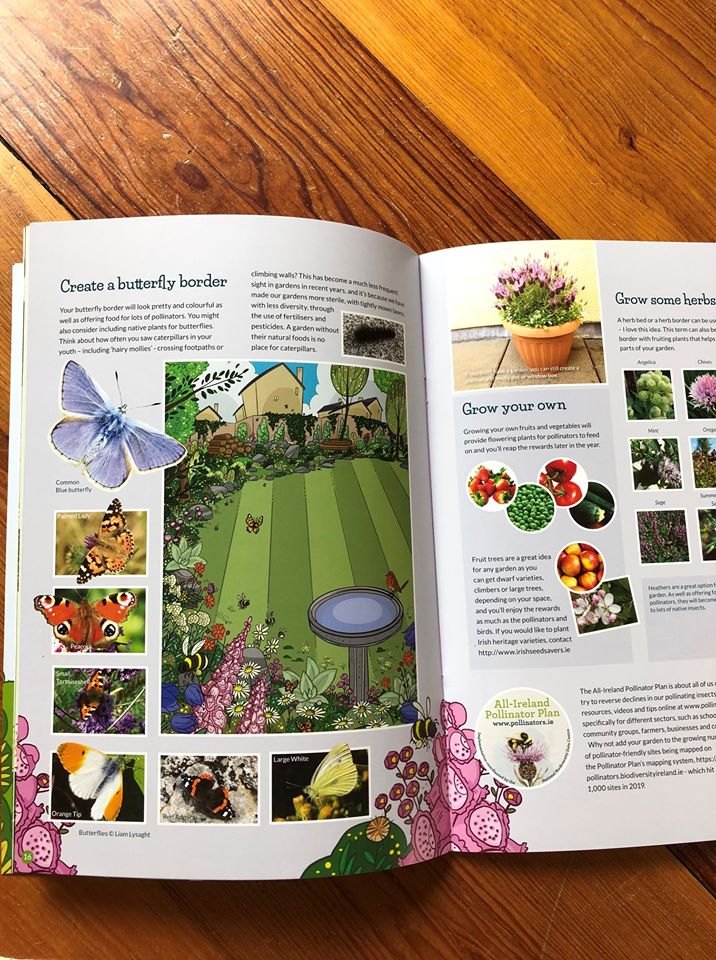
Day 48- Biodiversity for Birdsong
In her 1962 book Silent Spring, Rachael Carson worried that a quiet might descend on the landscape, a melancholic silence caused by an explosion in the amount of chemicals in use for farming and gardening. She passionately advocated for insects and birds, against the use of poisons directed towards the earth that provides our food, trying to disrupt the big players in the system with evidence-based arguments. Parts of America had already fallen terribly silent by 1962.
Here, the mantle of destruction has continued on a piecemeal basis, so that many farmland and garden birds have diminished dramatically in numbers of the last 50 years. The baseline has shifted to a new normal, we gradually fail to notice until songs are no longer sung.
We can act for birds, quite simply. Plant a tree in your garden or a group of trees if you have space, choose from the list of deciduous trees that are native to Ireland if you can – such as ash, rowan, hazel, holly. Encourage insects, leave seed heads in your garden, provide water. Farmers can plant corners of fields, where the big machines in use now cannot access at any rate or leave areas of gorse and scrub. We evolved on the planet alongside these creatures, and we must recognise that we are part of the same evensong. Welcome birds into your life, they will sing, and your heart will too.
Birdwatch Ireland, the charity in Ireland, which advocates for birds and their habitats has useful resources on their website.
The Gardening for Biodiversity booklet is available at https://www.chg.gov.ie/how-irish-families-can-cultivate-na…/
Or by emailing shclerkin@monaghancoco.ie for a hard copy.
Photograph of two blue tits by Richard Duff.
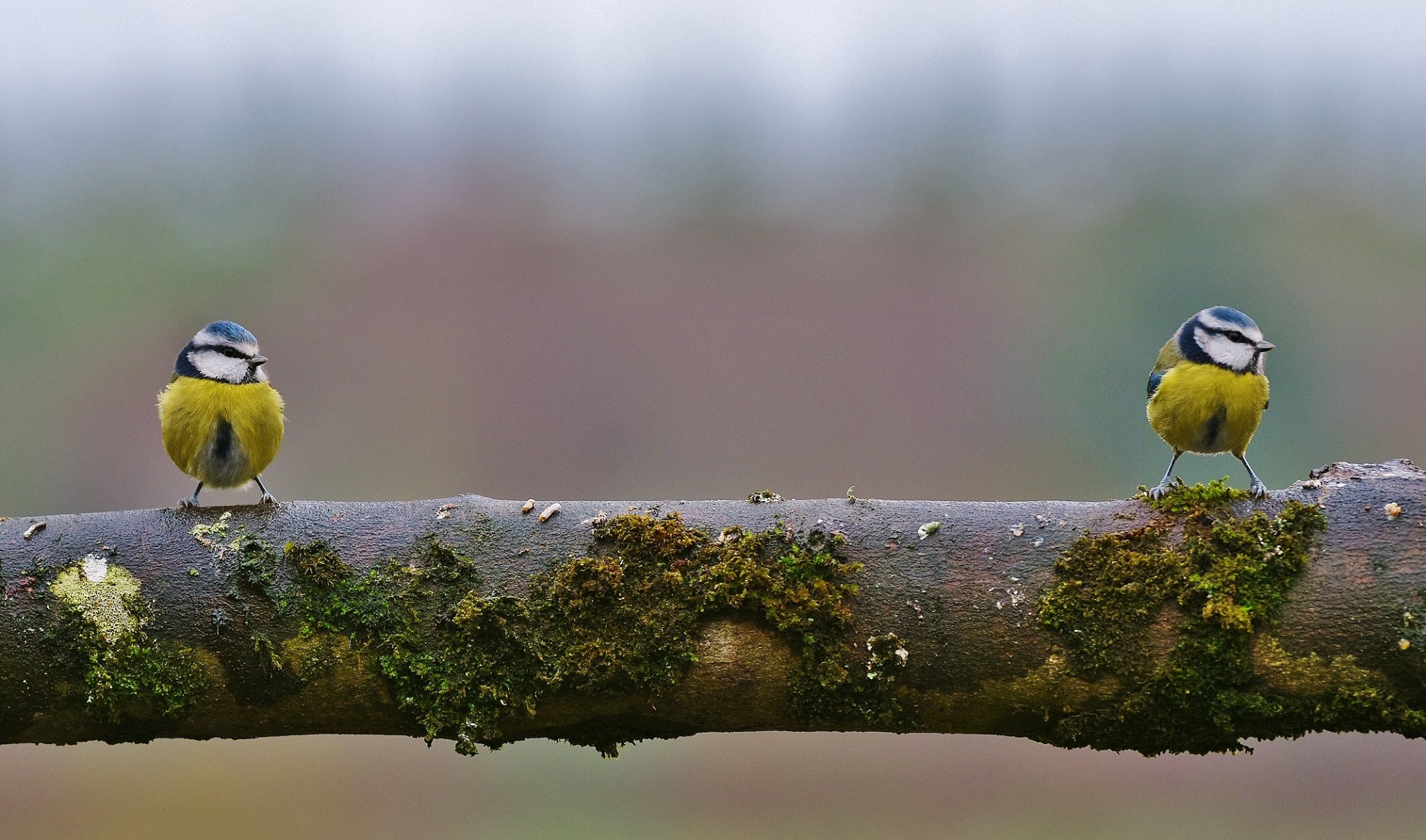
Day 49- Exploring heritage through the Schools Collection
Fifty thousand school children participated in collecting the local history and heritage of their localities in the years 1937-1939, as part of an innovative project established by the Irish Folklore Commission. A massive undertaking, supported by the primary school teachers across 5,000 schools, the children interviewed their parents and grandparents in an inter-generational effort on a range of subjects including legends, folklore, placenames, gaelic words, crafts and recipes.
40,000 of the original copy books are stored at the National Folklore Collection, copper plate handwriting neatly preserved for posterity, a skill in itself almost completely lost as we type more and write less. This truly fascinating archive is fully accessible online to everyone on
www.duchas.ie
You can search by school and locality, or by topic. Believe you me, it is a rabbit hole you will wish to descend into.
By way of example, this morning I delved into Cor na Péiste (Vol. 0947), Cornapaste – Hill of the worm, and found a list of gaelic words from the locality in west Monaghan that were no longer in use by that time.
Neatly transcribed on the copy pages are exacting words describing the physical and personality characteristics of persons, many of which now would be considered politically non-correct. A báirseach (barge) is a female scold, and I recall being called this myself as a youngster but did not know where the term derived from till now. If you stay out too long in the sun today you may have a brocach (brocked) – a sun burned face. If you are clatty – dirty or untidy, the word derives from claitseach.
There is a great emphasis on agricultural terms, such as bórach – a cord used to tie cows in the byre; béitín- conacre; sluagh – a large quantity of hay; turnóg – a clump of rushes.
Snipe is meannanaicir and sgaltán, a scaldy, which is a baby bird still in the nest are in amongst other observances of nature.
As for Cornapaste, and the worm – this is the townland through which the Worm Ditch or Danes Cast passes – now commonly called the Black Pigs Dyke. This massive Iron Age Earthwork snakes its way through the countryside amongst the drumlins and lakes of this townland and beyond. In the copybook it is recorded that the farmers “coveted the soil of the Worm Ditch, as a convenient top dress for their fields”. Luckily, they were not able to level it all, and miles of this imposing monument still stands. This ancient monument will be covered in another Heritage Happenings.

Day 50
Standing with the High Crosses
Dating from as early as the 9th and 10th centuries, stone high crosses followed a tradition of carved wooden crosses at the abbeys and monasteries that were established in Ireland. They are the work of master stonemasons, so richly and deeply carved, beautifully designed to have a real wow factor, centuries later still communicated through their silent stone.
The crosses typically depict scenes from the Old and New Testament, and decorative patterns of plait-work, knot-work and interlace – similar to those panels knitted into Aran jumpers, wool replicating stone. But then, one must imagine that the High Crosses were probably plastered and painted in bright colours to bring alive the stone stories of these public religious art monuments.
The cross heads were often in an open ringed formed, with raised circular bosses and a central crucifixion scene. The ring strengthened the arms of the cross, whilst providing more area to carve.
The crosses were important devices for the early church, a way of embedding the bible stories in a population that were familiar with the great epics and journeys of the Irish heroes and legends. There was stiff competition for hearts and minds. In the absence of an oral tradition, the church embraced visual communication in a very effective manner by commissioning and placing High Crosses in prominent outdoor locations at the abbeys, churches, boundaries and at cross-roads.
The tradition dies out in the 12th century. All of the High Crosses are therefore over 800 years old, not a durable as the oral tradition of legends and folklore, but their stoney longevity speaks of a respect and love for them even as they gradually weather away.
High Crosses are irreplaceable pieces of sculpture and art, all are protected archaeological monuments and much loved in the Irish landscape. Over the last ten years, they have been digitally scanned with new technologies so that their carvings can be recorded. Many of the original crosses have been brought indoors to museum settings, and resin or stone copies placed on the original site. This is to protect their now fragile surfaces from the poor air quality and intense weather.
The High Cross in Clones, 4.5 metres high, although not on its original site, has stood in its present location in the Diamond for hundreds of years. Composed of at least two different crosses from the remains of the monastery established by St.Tighearnach in the sixth century, the shaft is from a much larger cross than the ringed head, topped off by a little house-shaped shrine. The cross thought to date from the 9th century, a real legacy for Clones and for the national archaeological and artistic heritage.
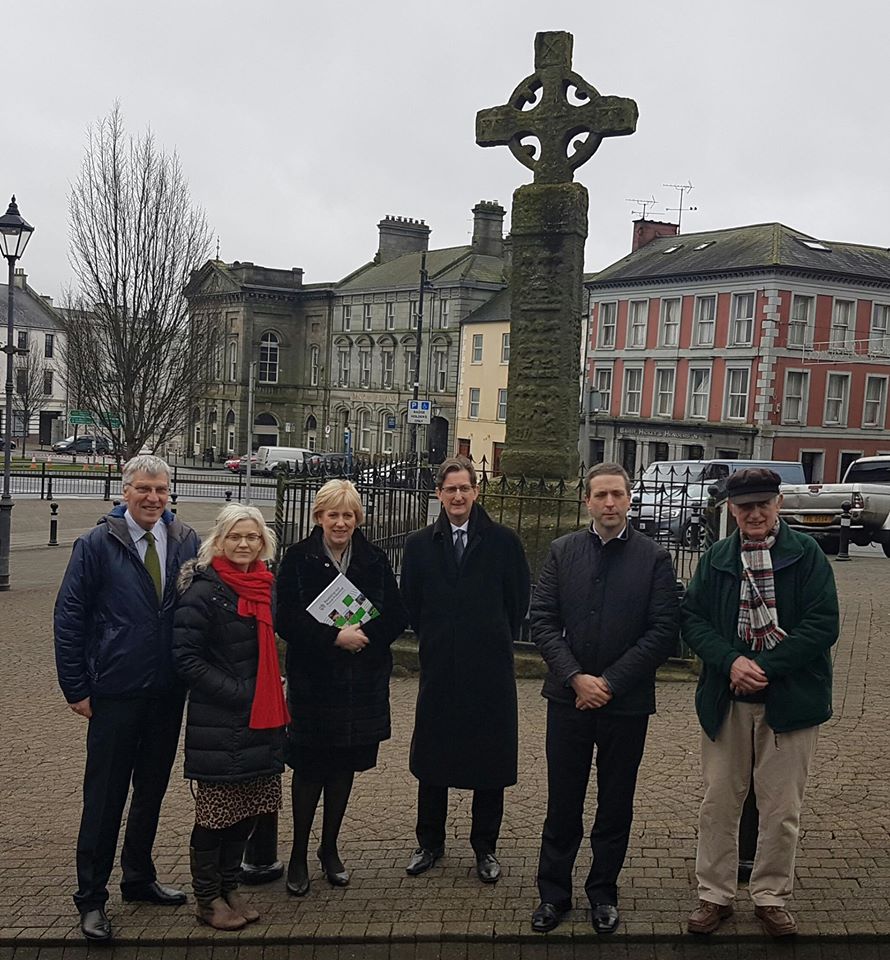
Day 51- Golden buttercups
The golden buttercups, flashing their sheeny brilliance at passing insects are not all the same species of Ranunculus, but consist of four main types in Ireland. We have the creeping buttercup, or Fearbaán Reatha (runner), which is very common and can be found on wetter soils as well as the edges of wetlands. The meadow buttercup, or Fearbán féir (grass), is found in grasslands and meadows often in profusions. In the legend of the Táin Bó Cúalgne, Cuchulainn is described as scattering his enemies like buttercups in a meadow.
Fearbán comes from fearb, meaning welt on account of the acrid nature of the plants sap, which is considered to mildly poisonous and of no grazing value for cattle.
The bulbous buttercup, or Tuile Thalún likes dry, well aerated soil. The wonderfully named goldilocks buttercup or Garbhlus na Móna is a woodland margin species, and often found where stitchwort and bush vetch are growing. The flowers often has a few missing petals, maybe accounting for the irish Garbhlus, which means rough herb.
The buttercup is a glossy flower, so much so, that it often reflects back light from the camera when trying to capture it. This is due to an optical thin film on its petals which reflects light like a sheen of oil on a puddle. The impact of the yellow pigments in the petal’s surface is dramatized by layers of air just beneath the surface, causing the mirror effect. In addition, each flower acts like a mini solar panel, curving up like a satellite dish on cold days, so that the heat is reflected onto its reproductive organs. The buttercup also attracts pollinators which prefer warmer flowers and you will often see little flies sleeping within.
Buttercups are clever adaptors to their environments, there is one for every condition. The next time someone enquires whether you like butter, and presents your chin with a buttercup, you might tell how buttercups reflect the golden light, and why cows won’t be grazing on their sour sap with any delight.
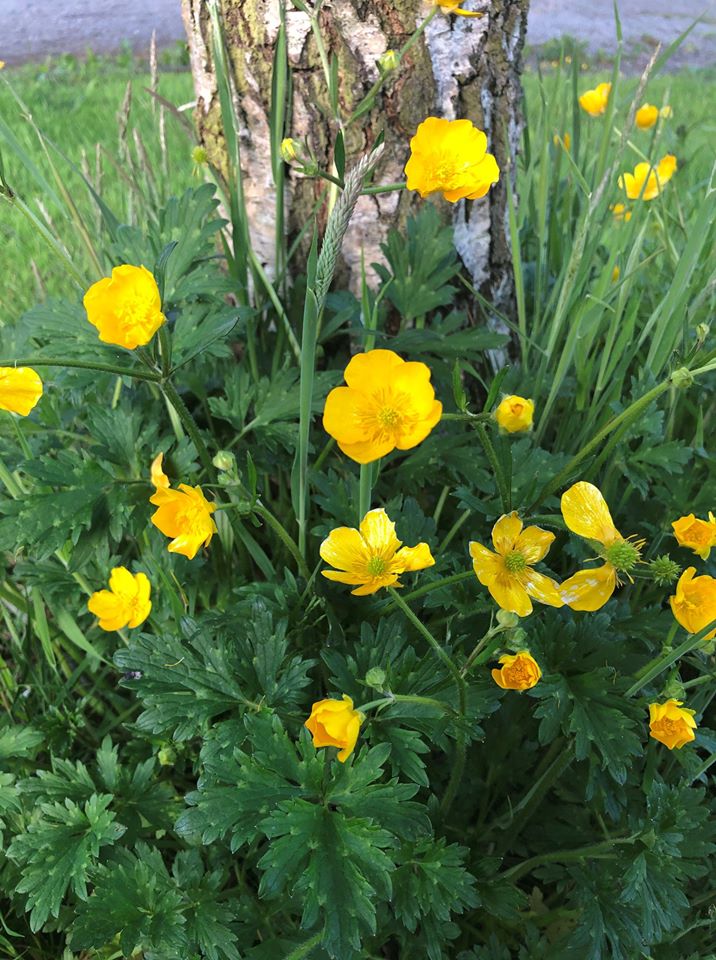
Day 52-The Soaring buzzard
“Now you see me” is a good line for the buzzard. It is often its mewing cat like calls which draws your attention first, and after scanning the sky for a moment you might see it sailing in and out of the grey mist, or circling small and high against a blue sky. The common buzzard, Buteo buteo was not so common until recently, persecuted to extinction in Ireland by 1891. The buzzard along with other raptors were listed on the Tudor Vermin Act of 1566 as a species for killing and payment. In 1933, a pair bred on Rathlin Island off the Antrim coast, and from there the buzzard spread its way through Ulster and down the island once more. Its’ strongholds are now Louth, Monaghan and Donegal.
The buzzard, or Clamhán meaning shaggy or mangy looking, is a brown medium sized raptor, with black tips to the tail and wings. Buzzards frequently breeds in woodlands with access to farmland, moors and wetlands. It is a versatile predator, feeding on small mammals, birds, frogs, birds and insects which it takes from the ground. It nests in the trees and lays 2-5 eggs in March – May.
At this time of year, family groups of parents and juveniles can be seen and heard mewing and calling to one another, circling ever higher as they soar on the warm air, learning flight and hunting skills. Or you might come across one, sitting motionless on a fence post or above on a telegraph pole watching the ground carefully for signs of movement.
The Cherokee believe that the buzzard or “suli” had a part in shaping the earth and that it is a doctor amongst birds. We are certainly lucky to be able to witness this wonderful bird in flight in many places in Monaghan now. As it glides on the draughts above us, it has a view of the earth that might be advantageous for us to understand.
Day 53-Clones Lace
Four years after Irish crochet lace was introduced by Cassandra Hand as a cottage industry to Clones, Queen Victoria wore it, on her lavish costume to the Stuart Ball in 1851. The Stuart Ball was the last of three costume balls given by Queen Victoria and Prince Albert at Buckingham Palace, and her costume designed by Eugène Louis Lami is a off the shoulder creation of silk, clone lace, gold braid and silver fringing.
The story of the successful social and cottage enterprise that was Clones Lace, started in 1847, or black 47 as it was known due to the severity of the famine at that stage at the height of the potato blight. A new rector was posted to the Church of Ireland to Clones and his wife Cassandra Hand was an energetic philanthropist who introduced the lace making to communities in Clones, Co. Monaghan and Rosslea, Co. Fermanagh. She was quick to see the benefits of the lace, which was cheaper to produce than venetian lace, as labour was cheaper, the tasks could be specialised by different people and it required no specialist tools.
It is made using a very fine crochet hook, which could be home-made by breaking the eye of a needle and inserting into a wooden handle. This became known as the famine hook. The thread was of linen, plentifully available locally. Motifs based on local flowers were developed by different families, these were crocheted separately and then sewn temporarily onto cloth, and then the whole pattern was stitched together using chain stitches and the distinctive “Clones knot”.
Clones became the centre for the production of lace in the north of the country and exported lace to the fashionable markets of Dublin, Paris, Rome and New York. The production of Clones Lace saved thousands from starvation. As advocator of a woman’s right to education, Cassandra also set up a school for infants and girls in Clones. She was buried in Rosslea in 1868 and her headstone reads “During the famine of 1847, and subsequent years she contributed largely to relieve the distress then prevalent…”.
Fashions changed of course, and together with mechanisation the market for hand made Clones Lace died out by 1910, but it continues as an important craft today. This is largely due to Máire Treanor who researched and produced an important book on the subject and started the annual Clones Lace Summer School in 1990. Máire has travelled all over the world sharing her knowledge, ensuring the craft is living vibrant skill and tradition. The wonderful Clones Lace gallery in the Ulster Canal Stores in Clones is worth a visit, and if you search youtube you will find some demonstrations on how to crochet Clones Lace.Clones Lace.
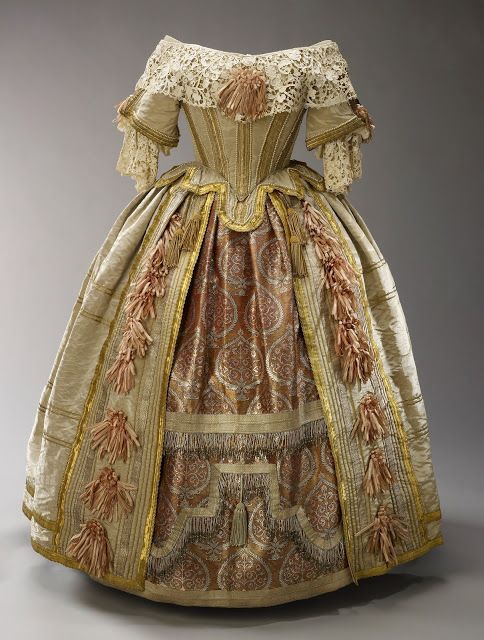
Day 54- The Bore-tree or Elder
Creamy clusters of elderflowers are starting to bloom now on the Elder tree, one of the fodhla fedo, or lower divisions of the wood under the Brehon Laws. The scent is heavenly, and the flavour too especially for elderflower cordial or as a flavoured tonic to dilute gin. Elder is a woodland margin species, and so is commonly found now in hedgerows, especially where the soil if fertile or where agriculture has enriched the soil with nitrogen and phosphorous. In Irish, it is trom. Elder is known as the bore-tree because the hard wood can be hollowed out to create a tube.
Elder can grow to 10metres, and it produces straight suckers from its base. Its bark is deeply furrowed, pale and corky. It has pinnate leaves, and the creamy 5-petalled flowers sit in lovely clusters which will be replaced with black berries in the autumn. Its scientific name Sombucus niger refers to these black nutritious berries, which makes delicious preserves and was much used in ancient medicine. “The seeds contained within the berries dried are good for such that have the dropsie, and such as are too fat”. The berries also make a gorgeous purple or lilac dye.
But back to the elderflowers, which are said to be mildly narcotic, so is unwise to plant near a bedroom window or to let cattle shade under it. Dried elderflower deters flies and acts as a good insect repellent. Elder is considered to be a highly magical tree, both a symbol of witchcraft and of healing. Elder is said to have a bad temper or crostáil and hostile to infants. If a cradle was made from elder wood the child would sicken and the fairies would take the baby away.
In a poem by Lubhdan, quoted by McCoitir, the facts are laid out thus –
Elder with its tough bark, truly wounds the most,
Burn it into charcoal, steed of the fairy host.
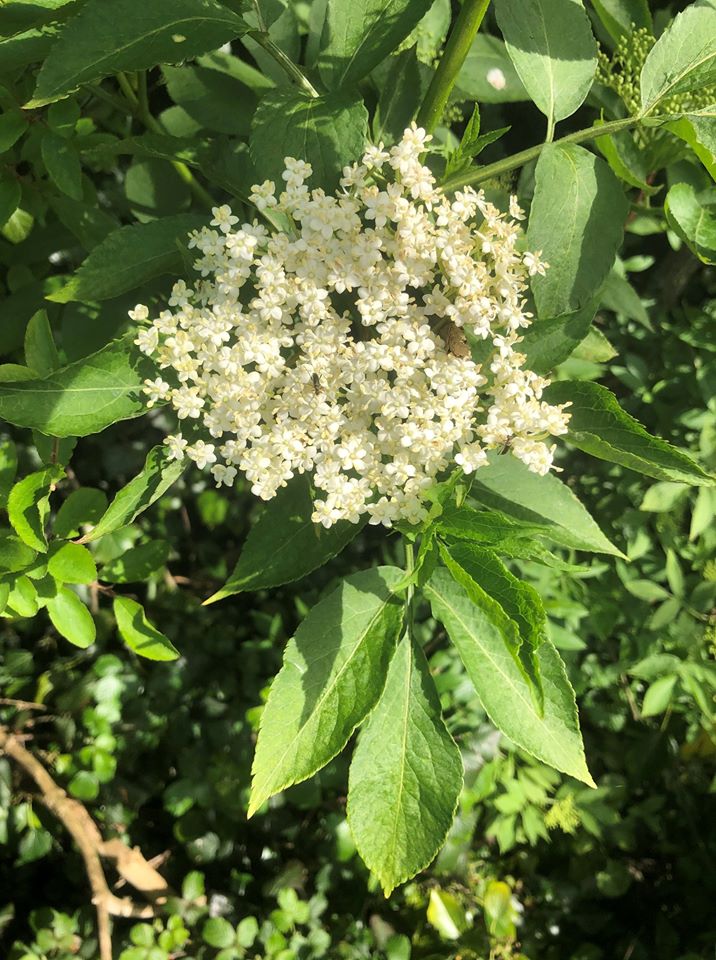
Day 55- Oak
Of all the tree species in Ireland, oak or dair is the tree which supports the most types of mammals, birds, invertebrates, mosses and lichens in its cocooning branches. Oak truly is an ecosystem all of its own.
Two types of native oak in Ireland can be most easily told apart by their leaf stems. Pedunculate oak or Quercus robur has a short leaf stem while Sessile oak or Quercus petraea has a long leaf stem. Sessile oak prefers acid soil and is predominant in native woodlands. Pedunculate oak is commonly the planted species in estates, avenues and plantation woodlands.
A good ‘mast’ year for the oak, with a heavy acorn crop quite often coincides with a good crop of hazel-nuts as well. This is usually every 6-7 years and in the Annals of Ulster they are recorded as being as good for feeding pigs. The townland Dernamuch in Errigal Truagh, Monaghan meaning Doire na muc or oakwood of the pigs attests to this.
You might notice abnormal growths on the oaks occasionally. These do the tree no harm whatsoever. They are usually caused by various types of mites or gall-wasps which stimulate the affected part of the host tree to create abnormal shapes and forms to protect their offspring, such as oak apples and marble galls which are brown and spherical and found on the twigs. The insect then bores its way out when its ready.
Under Brehon law, Oak was one of the Airig fedo, or nobles of the wood.
Oak planks and timbers are well recorded in the archaeological record. Neolithic houses have been found walled with oak planks. The excavation at the Iron Age Emain Macha or Navan Fort in Armagh found a the remains of a large oak post in the centre of massive circular structure. The oak post is thought to have been the focus of ritual practices. An oak palisade running the length of the Worm Ditch or Black Pigs Dyke in Monaghan was dug into the northern bank of the double ditched monumental earthwork during the Iron Age, and then set alight around 100AD.
Oak has so many valuable uses from ship building, barrels, rafters for roofs – Irish oak was exported to Salisbury Cathedral for the roof in 1222. The bark produces a black dye and the tanins of oak were used for tanning leather. The usefulness of oak is one of the reasons why most of the oak woodlands in Ireland were long gone by the start of the 20th century. The controls of the Brehon Laws were long gone.
In Monaghan, there are many places which attest to oakwoods once being present. Dernadarrif or Doire na dTarbh in Errigal Truagh is Oakwood of the bulls. Derrylavan in Magheross is Doire leamhán or Oakwood of the elms – another majestic tree. Derryvalley in Ballybay is most likely Doire bhealaigh – oakwood of the pass, and Dernacoo in Errigal Truagh is Doire na Cú – oakwood of the hounds.
In the 12th century poem Sweeney Astray, the oak is well regarded – “o bushy leafy oak, you are high above every tree”.
A good activity for the autumn is to collect some acorns especially from areas of old native woodlands or from old trees and set them in pots, to create a small tree nursery of your own. Leave some for the squirrels though, only take what you will use.
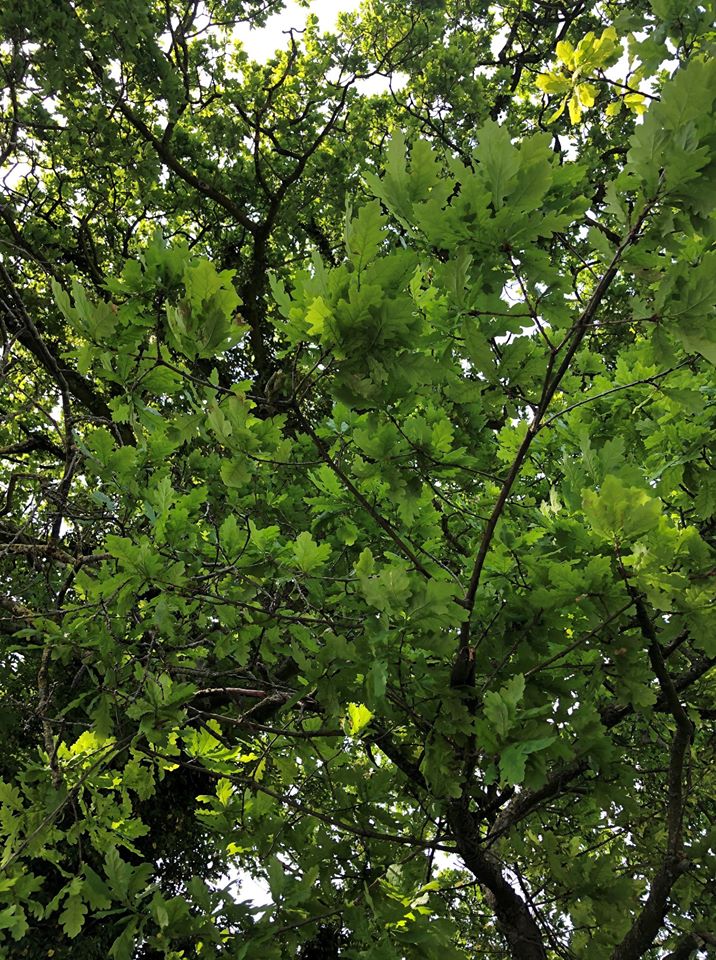
Day 56- Hart’s Tongue Fern
Ferns have been on this planet for millions of years longer than flowering plants. They are in effect living vegetative dinosaurs.
reproduced by means of spores which are on the underside of their fronds or leaves.
When young, fern fronds are tightly coiled. Then they unfurl and unwind from their bishop’s crozier shape in the early Spring, to their characteristic drooping or curling leaf habit.
They are a very successful type of plant, and are found in woodlands, hedgerows, spreading across old walls and even springing out where a leaky downpipe drips water in the corners of old buildings.
Many of the leafy split leaf ferns looks quite similar but Hart’s Tongue Fern is one that is easy enough to identify. It has smooth strap like fronds and is very common. In Irish it is Creamh na Muice fia (muice – pig, fia – deer), and was in the past boiled to make an ointment to cure burns and scalds, soothe insect stings and cure warts.
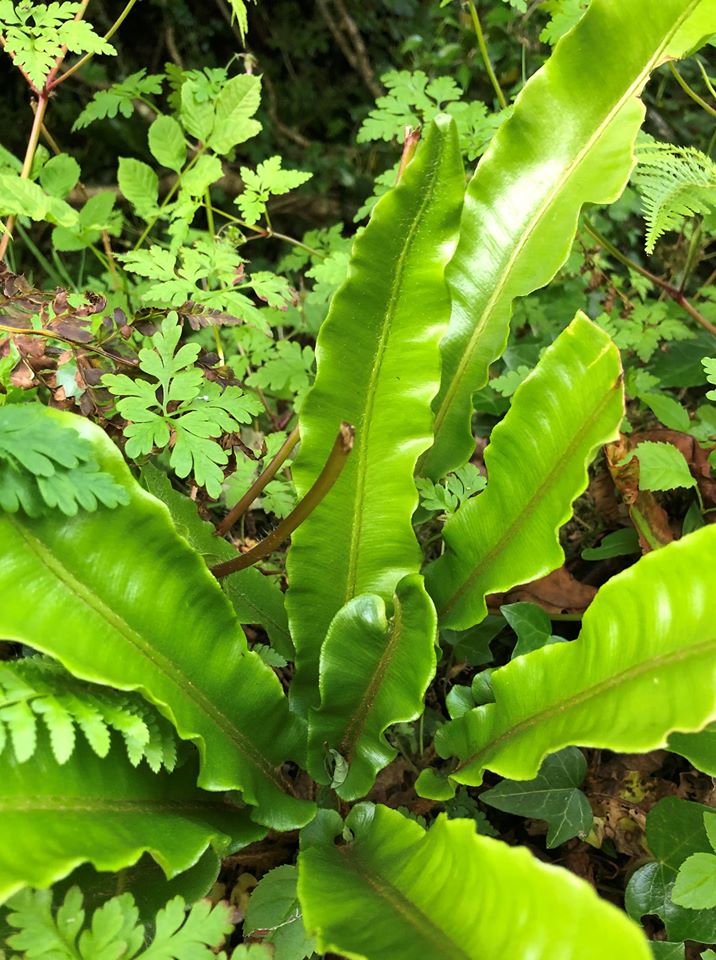
Day 57- Historic hand-blown glass
We are familiar to seeing our reflection in our mirrors and even in our smooth, fully transparent modern windows. Of course, this is a relatively modern phenomenon thanks to Mr. Pilkington who revolutionised mechanised glass production in the mid-twentieth century. Most of the generations before us who had the luxury of glass windows, peered out through small slightly wavy panes produced by the human breath blowing molten glass into globes.
Crown glass was blown into a ‘crown’ or hollow globe by a person blowing their own breath through a pipe. Then it was flattened by hand spinning it out into a large open circle up to 5-6 feet in diameter. Very skilled tough work. Then it was cut, the edges had the thinnest most expensive cuts, as it thickened towards the centre of the bullion or bullseye.
The edges were generally cut into diamond shapes and then fitted into leaded frames, such as you will see in old church windows. The centre thicker pieces were less expensive, and the piece with the bullseye was also used – sometimes you can still find these in small paned sash windows. Overall, the glass has a slightly wavy reflection.
Cylinder glass was an innovation on crown glass, which started with the same hand-blowing technique but then the glass was swung in a trench to stretch it out. This allowed the production of much longer sheets of glass and the waves were less curvy and more parallel than with crown glass.
If you have old windows, one of the irreplaceable elements may be the old hand-made glass panes. You will know from your slightly distorted reflection, and the faintest of patterns in the glass. Think of the person, who using their own air, created something so delicate and durable from rock to sand to glass. Real geological anthropological transformation.
The photos are from Cahans Church, close to Ballybay, taken during filming for Monaghan Gothic – a film you can find on youtube. Pictured are Kevin Mulligan and Dara McCluskey. Windows before and after restoration.
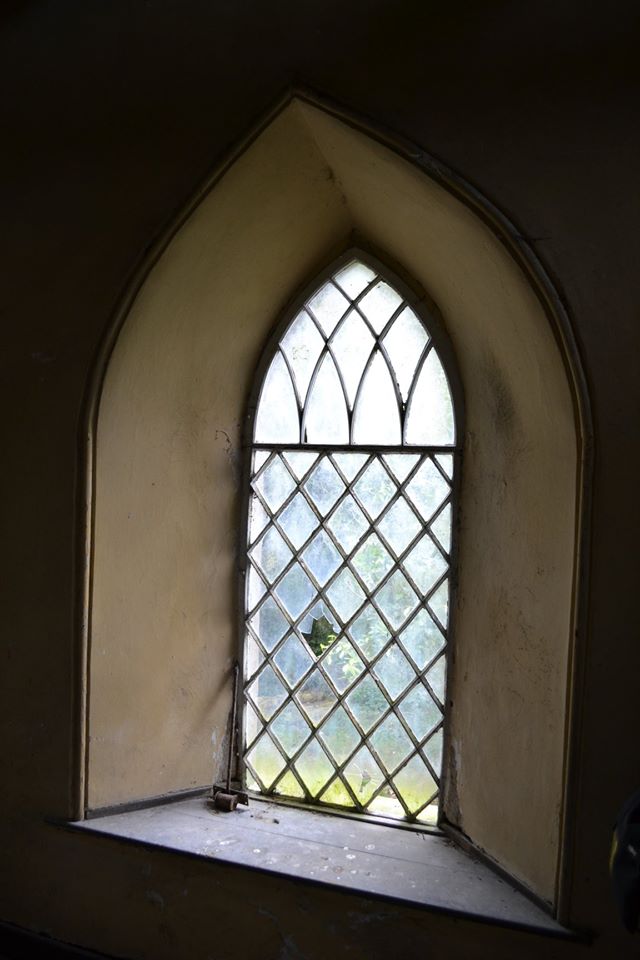

Day 58- The Worm Ditch
On the 27th May 1835, John O’Donovan of the Ordnance Survey, writes about the area of Dartree, Monaghan which is has just traversed – “it receives here the stranger name of “the worm track” or the “worm ditch” in Irish Cladh na Peiste. It runs from one extremity of the parish (Currin), to the other in a SE direction. As the people are plagued with it, striving to pay rent for it, they are labouring to level it with great industry, and it is completely defaced in various fields, but up the sides of the barren hills it still shews its double ditch or rampart in all its pristine perfection, defying plantations across the summits of unprofitable hills; the pick-axe of the covetous farmer for at least another century”.
O’Donovan was correct – it has defied the pick-axe, miles of it remains proud and where it was dug out in the past, modern technology can detect its traces and history of burning with geophys surveys and Lidar imagery. The old name of the “Worm Ditch”, was replaced in more modern times by the Black Pigs Dyke, possibly due to O’Donovan’s ruminations, and indeed both names are inscribed on the Ordnance Survey maps. But it seems that the Worm Ditch or Track is the older one. It gives its name to one of the townlands it graces – Cornapaste – Cor na Péiste – Hill of the Worm.
Now, the earthwork is mostly wooded or scrubed over with hazel and ash, but imagine the denuded landscape of its construction and the later barren hills of O’Donovan. The tracks would have snaked their way around hills, unclothed and visible for miles. The earthwork itself, dates from the Bronze Age and Iron Age. It was a monument that was re-used and re-configured to take a massive oak palisade running down one bank, which was then mysteriously burned around 100AD. Perhaps these were the serpents or worms that St. Patrick got the reputation for banishing from this island – the pagan people of the Worm Ditch with its giant serpent ancestry.
We will have more on this archaeological monument in another Heritage Happenings.
You can read some of our archaeological research on the Worm Ditch on
Day 59- Our Earth Home
The word “eco” comes from the Greek òikos, meaning house, dwelling place, habitation. Eco is the root of many of the words which describe processes on our planet – ecology, ecosystem, economics and ecocide.
David Day wrote in 1989 that “there is only one life on this planet, and we are all part of it”. We are all inter-dependent on one-another, mutual altruism pervades even the meanest of communities, and by ‘one-another’ I refer to all life. The ecologist Edward Goldsmith noted that 3 billion years of evolution of species has “tended in the direction of increased biospeheric stability”. The community of life on earth generated and still maintains the composition of the atmosphere. However, since the historic times and the Industrial Revolution in particular, the biosphere has, under our direction “tended towards decreased stability”. This is caused by the destruction of habitats and loss of species, loss of ecosystems that influence soil fertility, carbon sequestration, pollination services, water cycles and ultimately the stability of the climate. In short, the loss or extinction of plant and animal species greatly limits the choices for a sustainable livelihood and life for current and future generations.
As far back as the 1980s Edward O. Wilson warned of our foolisness – “The one process ongoing in the 1980s that will take millions of years to correct is the loss of genetic and species diversity by the destruction of natural habitats. This is the folly our descendants are least likely to forgive us”. Will we be the ancestor’s others will mark out in the history books for negative reasons or will we be a generation that will turn it around?
Nelson Mandela said “Sometimes, it falls upon a generation to be great. You can be that generation. Let your greatness blossom”.
Sustainable Development depends on production systems for food, travel, work, creativity that respects the obligation to preserve the ecological basis for that development. The late Polly Higgins, who died last year, conceived of a draft International law of Ecocide, defining ecocide as “extensive damage, destruction to or loss of ecosystems”. Ecocide is the absence of care for the Earth and causing it significant harm.
Although massive system change is required to enable us all to live more sustainable lives, changes at policy, legal and practical levels, it is an error to wait for someone else to walk the walk.
“Nobody made a greater mistake than he who did nothing because he could only do little.” – Edward Burke.
5th June is World Environment Day.

Day 60-Underground cultural spaces
Underground, mostly unseen spaces hold a mysterious fascination, going below the surface seems counter intuitive. Yet this space holds spaces, caverns, caves and tunnels where people have placed hoards of precious objects for safety, where people have hidden in times of strife and where people seek to find ores and materials to use above ground.
Caves are natural underground cavities in rock, that are formed by the solvent and erosive action of water as it slowly travels downwards through joints, bedding planes and fissures. They are most commonly found in limestone, because it is a soluble rock which can be dissolved by the slightly acidic rain and surface water. There are almost 800 recorded caves in the Irish state, 10% of which are classified by the National Monuments Service as archaeological monuments.
In Cloughvalley Lower, Carrickmacross, one of these caves called Creevy Cave (MO031-137001) contains a possible hearth, post-medieval pottery finds and an earthern platform along with a stone structure. People lived in this natural limestone cave in the past. Referred to in the past as Fin McCools cave, a small stream from Lough Aphuca (lake of the ghost or hobgoblin) flows into the cave, and the cave is a geological delight with stalactites and flow stones inside created by the constant slow dissolving drip of the water.
In other areas, people built their own underground spaces, now called souterrain (meaning under ground); there are 58 known examples in County Monaghan. MO007-019 is in Creighans townland, in a location marked as Cave Hill on the map, adjacent to Cornahoe – Round Hill of the Caves. It is a stone lined tunnel structure with stone lintels possibly running from a ringfort.
Others at Moylemuck, Bocks Uppers also are associated with ringforts. One at Ouvrey – or Aimhréidh, meaning rough ground may speak about the surface undulations relating to the underground happenings.
There is a whole world under our feet.
Day 61- Forget-me-not
The delicate blue petalled and yellow eyed flowers of the forget-me-not have been symbols of friendship, faithfulness, and love for centuries. But it was originally known as the less romantic ‘scorpion grass’ because of the way the flower heads curl over on themselves. The scientific name Myosotis scorpioides for Water Forget-me-not embeds this characteristic. Myosotis is derived from the Greek for mouse ear.
From about 1400, Forget-me-not had become the common English name. Its’ naming story comes from a German legend of a knight and his lady walking along the River Danube. He picked some of the blue flowers for her but he was wearing a heavy suit of armour and toppled over into the waters. Before he drowned, he threw her the posy and cried “Forget me not”. The poet Samuel Coleridge embraced the story into a stanza in 1802 –
“Nor can I find, amid my lonely walk
By rivulet, or spring or wet roadside
That blue and bright-eyed flowerlet of the brook
Hope’s gentle gem, the sweet forget-me-not!”
Water forget-me-not or Ceotharnach uisce grows in wet and also dry conditions to as tall as 30cm. It has oblong downy leaves.
Heritage is what is we inherit from the past. Academics, archaeologists, geologists, botanists and ecologists often work from fragments of what now remains to piece together a picture of a former habitat, landscape, culture or society. By doing so, memories imbued in the landscape are brought forth and we are the richer for the enhanced understanding and engagement with people and places.
Forget-me-not is the symbol of many associations who work to support those with Alzheimers Disease. There is a choir for those affected by dementia beautifully called ‘The Forget-me-nots’. It must be difficult to lose touch with personal memories and the sense of security and rootedness those bring. Today this column is dedicated to all the individuals, families and carers who find themselves on that path.
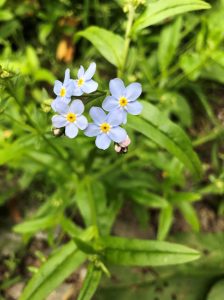

Day 63- The Pink family
Two members of the Pink Family that are easy to identify are in bloom now.
In woodland clearings, where a little light can permeate through the overstorey of leaves, you might see some striking rose-pink reddish flowers. The red campion, Silene dioica is a perennial herb, with creeping rhizomes, with bright rose pink petals that are gently forked. They have separate male and female plants and are pollinated by bees and flies. Cleverly, the red campion hides its nectar in a tube behind the flower so that only flies that are big enough to pollinate it can reach the reward.
Apparently its names was coined by the Romans, who used the plant in garlands to crown their “champions” in their public games in Rome.
The ancient herbalist Gerard maintained that “the seed drunken in wine is a remedie for them that are stung with a scorpion…”. Its scientific name Silene derives from a merrily drunken Greek God called Silenus. In Irish, red campion is Coireán Coilleach and considered to be a fairy flower and unlucky to bring indoors.
The other pink flower, also a fairy flower, is called Ragged Robin, on account of its raggedy, shaggy, frayed pink petals. In Irish it is Lus síoda (silk herb). Butterflies and long tongued bees feed on its nectar. It is most often found in wetter habitats, and on edges of wet grasslands. Its frayed flower shape has evolved to endure windy conditions. Ragged Robin is especially loved by the Common Blue butterfly, making a gorgeous combination of petal-wing colours if one can catch a glimpse of them together.

Day 64- The Monaghan Market House and Avondale
If you read the plaque commemorating the joint enterprise between its creators – Hayes and Cunnighame on the gable end of the Monaghan Market House, you will find yourself at the start of a story –
“Dedicated to the convenience of the inhabitants of Monaghan by Rt. Hon. Lieutenant Gen. Robert Cunnighame. M.D.CC.XC.II S.H. of Avondale Del”.
Cunnighame was MP for Monaghan from 1769 and responsible for creating the Barony of Rossmore. As a member of the West Yorkshire Regiment, 14th foot infantry regiment of the British Army, he fought in the Battle of Culloden in 1746. This infamous battle last only an hour, after an unsuccessful charge by the Highlanders against the government lines. His friendship with Samuel Hayes (S.H.), from Avondale in Wicklow, resulted in the design the Market House in 1792. Although he was an amateur architect, Hayes had an eye for proportion, elegance, and the potential for the sloping site.
The Market House is a tidy neo-classical building, symmetrical, arcaded and sitting on a low podium, built from rough-hewn stone with dressed limestone trim. The arcades were originally open and gated with wrought-iron flat bar gates, to allow for easy access and trading within and around the “house”. Over each open bay is a panel of Portland stone with drapery festoons. Matching niches on each gable end of the Market House are now filled with pollinator friendly planters and busied by bees.
Hayes was also an Irish MP and to boot a barrister, amateur architect, draughtsman and planter of trees. He designed and planted Avondale – the estate later made famous as the home of Charles Stewart Parnell. To this day, the oldest trees there are those planted by Hayes.
Trees seem to be the real passion of Hayes. Born in 1743, he inherited the 4,500 acre estate in County Wicklow from his father, “Hayesville”, which he renamed Avondale in 1770. In 1794, two years after he built the Market House, he wrote the first book on trees in Ireland called “A practical treatise on Planting and on the Management of Woods and Coppices”. A facsimile copy of the book has recently been produced by the Irish Tree Society, with a foreword by Thomas Pakenham. He died soon afterwards in 1795.
Having no family, he left Avondale House to his close friend, and second cousin, Sir John Parnell, great-grandfather of Charles Stewart Parnell.
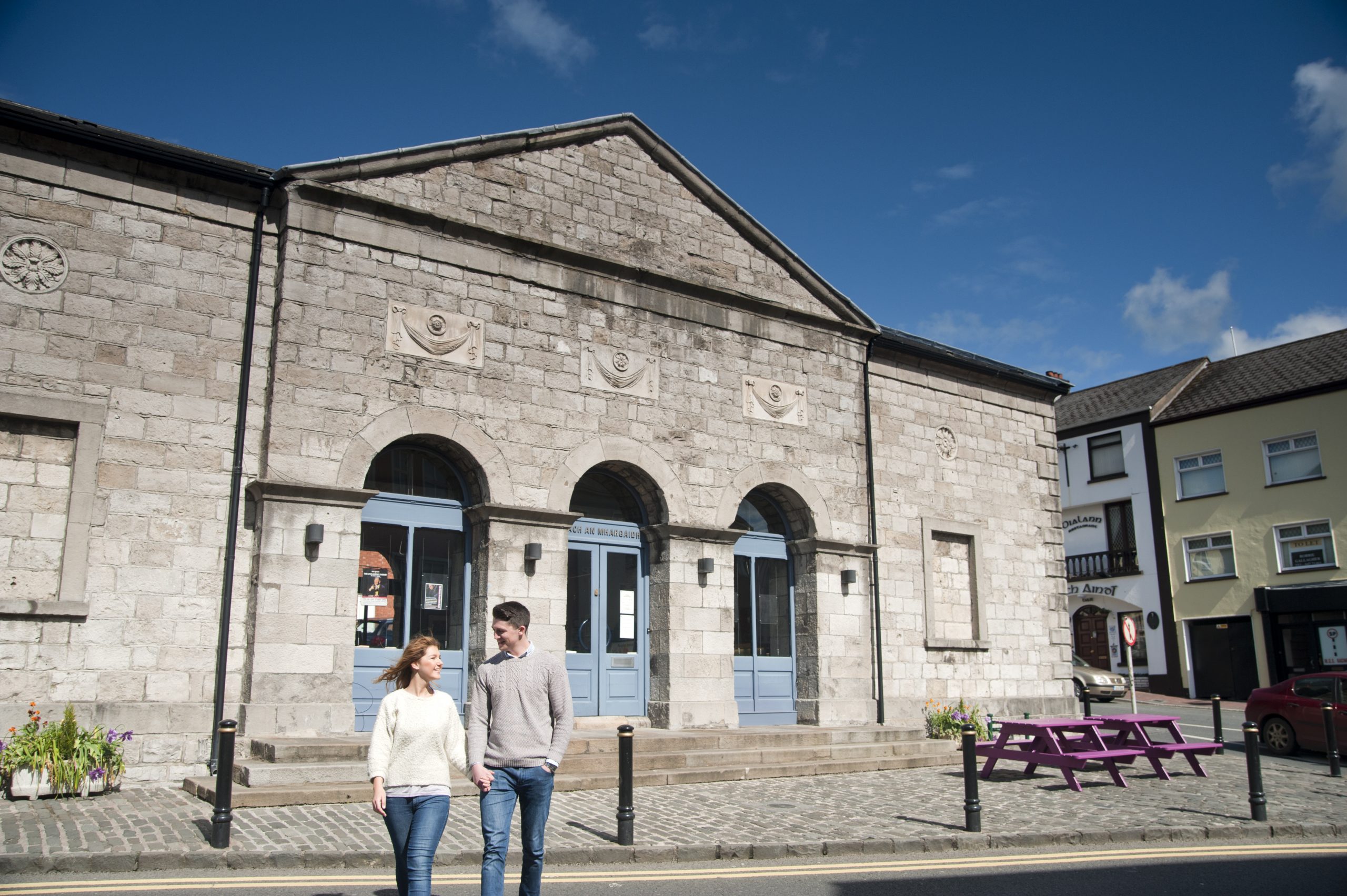
Day 65- Alder –from battle shields to women’s shoes
Alder is a fine deciduous tree, most often found alongside willow on the edges of rivers, marshes and on the shores of lakes as a wet woodland. Indigenous to Ireland, alder is one of the Aithig fedo, or commoners of the wood in Brehon Law. It has a very dark fissured bark, dull and purplish buds, with rounded leaves that have no point or tip, which taper elegantly onto the stalk. Alder bears two types of catkins, yellow male hanging catkins and round, green egg-shaped female ones. It is quite a common tree in Monaghan, well worth looking out for and appreciating. In Irish it is Fearnóg, and Alnus glutinosa (means sticky) is its scientific name.
Bronze Age alder battle shields have been uncovered in Ireland, and there is evidence presented by McCoitir that alder was the “craobh ruadh” – red branch of the Ulstermen or Ulaid. When alder is cut, the wood turns from white to red. The druid Cromm Deróil recites in “The Intoxication of the Ulaid” –
“Men of triumphs these men of alder shields,
Red their weapons”.
Samuel Hayes in his 1794 book, “A Treatise on Trees” refers to more modern and recognisable uses for alder – “Birch and alder of the smallest size will fell for the chairmakers use; if larger, they are used for cart saddles, soals for pattens, and heels for the women’s shoes, the demand for which is often very considerable”.
A patten is a protective overshoe or outdoors shoe, worn to elevate the walker above the mud, dirt, human and animal excrement of the roads. These wooden soles prevented clothes and long dress hems from trailing on the ground and were in use until late 19th or the early 20th century in parts of Ireland. Jane Austen when talking about Bath, England refers to the irritating noise of the wooden clogs on the streets “the ceaseless clink of pattens”. Anyone who has ever worn a wooden soled clog, a swedish Hasbeen, or wooden scholl sandal will recognise this clunky clinky noise.
In County Monaghan, clogs were still made locally and worn in the twentieth century. In 1938, 11 years-old James Ward writes – There was a clog-maker name Rocks and he lived beside Mullagreenan school. He made clogs about twenty years ago. Nearly everyone wears clogs in the winter. An old proverb the people had was “Shod in the cradle and barefoot in the stubble”.
Young James was a student in Tattenclave National School, from Calliagh, Co. Monaghan and he interviewed James Ward, farmer aged 58. You can read more in Volume 0948, page 320 of the Schools Collection on www.duchas.ie

Image credit: Dúchas.ie
Day 66- Lead and silver mines
The industrial revolution increasingly drove men underground as the ore mining industry took off during the mid-nineteenth century. One shaft at Cornalough, part of the Hope Mines, close to Castleblayney was reported to be 100foot deep. The daily descent into darkness was only dimly lit with oil lamps. One can imagine that the ascent up the shaft was a jolt back into colour for the workers.
The first mineral deposit to be commercially developed in Monaghan, around the middle of the 18th century, was probably Tamlat, near Ballybay, where lead was mined briefly from a series of shallow shafts or pits. Lead mining at this time may have been associated with pottery manufacture and the use of lead in glazes.
Antimony was discovered near Clontibret, apparently in the early 1770s and was the subject of several attempts at exploitation, the last by the Mining Company of Ireland which developed several shafts in1825–26 before abandoning it. In 1784, British General Henry Shrapnel developed a lead alloy containing 10-13 percent antimony that could be formed into spherical bullets and used in artillery shells. In the 19th century, the British military adopted Shrapnel’s technology, and antimony became a strategic war metal. ‘Shrapnel’ (the ammunition) was widely used during World War I, but none of it was mined from Clontibret.
Tassan, north of Castleblayney had the largest and most productive lead and silver mine in the Monaghan district, owned by the Castleblayney Mining Company. Production started in the 1840s until 1866, with a Mr. Joseph Backhouse listed in the Griffith Valuation as the first worker.
The total production was 742 tonnes of ore – 546 t of lead and 37,478g of silver. The 1857 map shows five shafts descending to the underground, only one of which is easily found today. This is a site that always requires caution because of the activities over a hundred years ago. The remains of the mine buildings, one shaft, and large solid waste heap together with the flat dressing floor bounds the west shore of Tassan Lough.
The silver mines at Cornalough commenced production in 1852 until 1874, producing 314 tonnes of ore. The Cornish engine house chimney is a rare and still standing heritage structure – the overground monument of an underground world
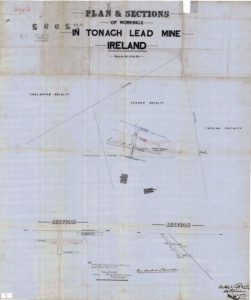
Day 67- St. Maeldoid and the Muc
On the 14th May, 1835 John O’Donovan writing to the Ordnance Survey tells about his jaunt the day previous “Yesterday a very intelligent old farmer (of the name MacShane) walked me through the beautiful demesne of Castleblayney to shew [show] me the romantic lake, called Muc Snamh, the site of the monastery and where the pig swam across the lake to point out to the saint where he might build his church with safety.”
According to Seosamh O’Dufaigh, Maeldoid perished in the Buidhe Conaill, the yellow plague, which came into Ireland in 664, according the Annals of Ulster. The yellow plague lasted twenty years, causing widespread mortality, social disruption and apparently abandonment of religion. According to some sources, the Annals of Tigernach of Clones note that the plague was preceded by a solar eclipse on 1 May 662. Places of burial were needed such was the ravages of the plague. The placename – Tamhlacht is a “plague-grave” from tamh – a plague, and lacht – a stone or memorial.
Maeldoid’s brother was Scannlan, the first named king of the Uíí Méith, providing his monastery with the protection and patronage of the civil ruler, as well as the pig’s advice.
The Church of Ireland in Castleblayney is dedicated to this saint, the current church dating to 1858 is the third church built on this site since 1622. It is built from rubble stone with Scottish sandstone trim, designed by Joseph Welland, the polygonal apse faces east over the “romantic lake”.
Lough Muckno is an important natural habitat for Castleblayney as well as being a cultural site and designed landscape as part of the demesne. It holds layers upon layers of history and legends within its drumlins, wetlands and lakes.

Day 68- Wych Elm
Wych Elm or leamhán is a dark majestic tree, with spreading branches reaching almost as far out as its height, known to be a significant component of early woodlands in Ireland before Neolithic farming 6,000 years ago. Elm has large, oblong elliptical leaves, toothed and rough, with unequal bases and short stalks. It is the only Elm that is native to Ireland.
Although it is more resistant to Dutch elm disease than English Elm, the beetle and fungi combination still will damage the tree and wych elm does not send out suckers like its English cousin. But it will send out fruits with seeds in the centre of a papery wing if the tree is mature enough.
The wood of Wych Elm is resistant to water, so will grow alongside a sheugh or wet ditch, so long as the soil is quite alkaline, and it is this quality which makes the wood valuable. In early times it was used as piles under bridges, and in buildings close to water, or in basements in damp conditions. Wood was also used for water pipes, coffins and divining rods.
Elm is mentioned in the Life of St. Patrick on many occasions and is often found in conjunction with Holy Wells. It is associated with the goddess of fertility of the land.
Leamhán is a commoner of the wood under the Brehon Tree Laws.
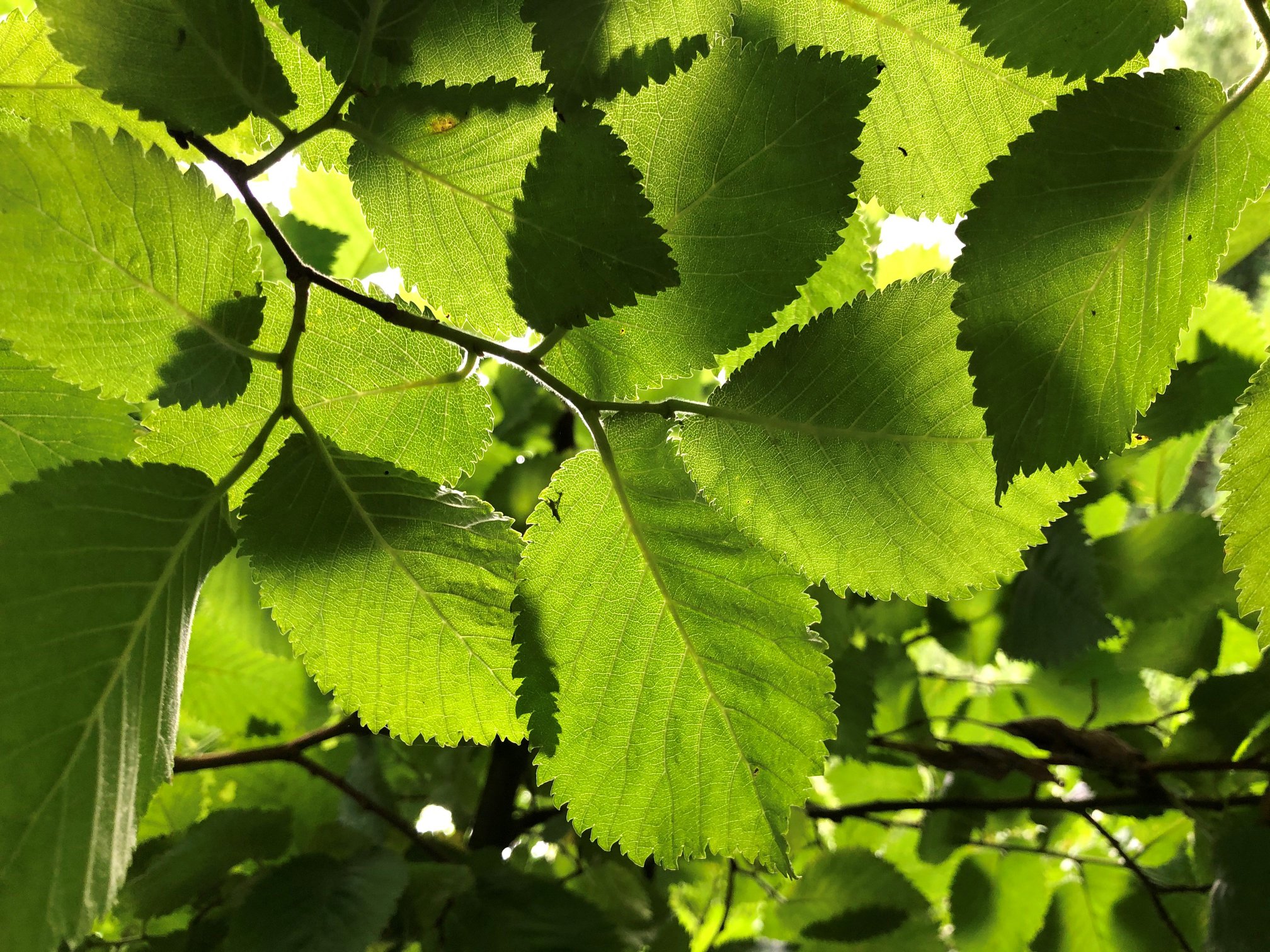
Day 69- Summer Solstice
We have reached our annual peak light, as the earth’s north pole has now tilted closest to sun, giving us a whopping 9 hours 30 minutes more light than on the opposite day in December. The Summer Solstice marks an important turning point, and its sunset has been celebrated for thousands of years with customs and traditions that demonstrate its cultural resonace. Solstice or grianstad (grian – sun, stad – stop) as gaeilge, means stopping or standing still of the sun. It is the cross-quarter point between Bealtaine in May and Lughnasa in August.
Megalithic tombs in Ireland are often aligned with these calendar points, with the rising of the sun at the winter solstice such as at Newgrange and the setting of the summer solstice at Carrowkeel in Sligo. Both the pouring in of the new sunrise to the stone chambers, and the leaving of the sunset from the darkening interiors were made tangible by the astronomer tomb builders.
One such tomb in Monaghan intrigues the writer in this way. It is Mullyash Cairn in the east of the county close to the Armagh border. Before the conifers engulfed its viewshed, it commanded views to Loughcrew and Slieve Gullion, as well as to Sliabh Beagh, the Mournes and the Cooleys. Loughcrew has a rich archaeological landscape also with alignment, but to the equinoxes. Slieve Gullion is aligned with the Winter Solstice sunrise.
Lughnasa was celebrated at Mullyash until the 1950s, on the last Sunday in July, a tradition known as Blaeberry Sunday. People climbed the hill, coming from the south west route, which may have gone past the now fallen standing stone, and collected bilberries.
Have a listen to our Heritage at the Heart podcast where we talk to local experts about Mullyash, by clicking on this link: https://monaghan.ie/heritage/2019/03/29/heritage-podcast-series-episode-2-mullyash-cairn/
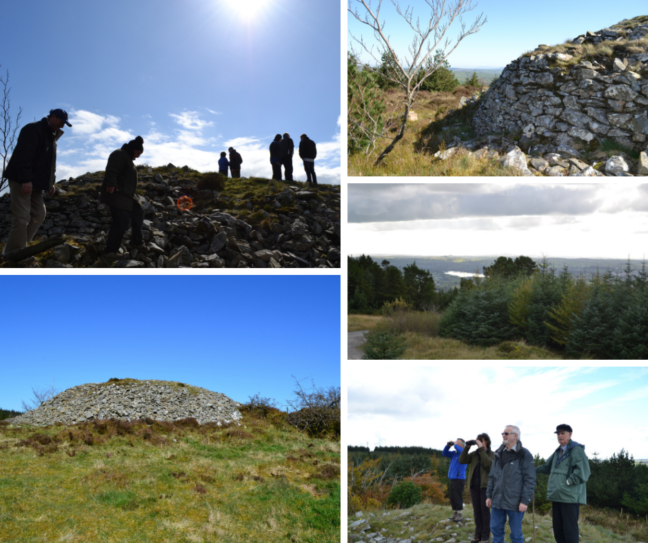
Day 70- Guelder Rose
This small tree or big shrub is not a rose at all, but a deciduous species of viburnum, with small maple like leaves which are green now, punctuated with flat umbels of white flowers. It is found in many of the hedgerows in Monaghan, particularly liking limey soils and damp conditions.
It’s unusual name Guelder Rose, apparently comes from the Netherlands. Its’ latin or scientific name Viburnum opulus derives from the gaulish “opolos” meaning maple. Dangling crimson translucent berries are produced in autumn that are entirely opulent, in the decorative sense. They shine as the finest jewels, like sewn in beads on the dark crimson, orangey autumnal leafy fabric. But they are poisonous, so leave them for the birds who love them.
The white unbel flowers have a division of labour worked out. The outer ring of flowers are sterile with no carpels or stamens, and the inner ones are fertile. The insects are attracted inwards to pollinate by the outer showier flowers.
In Irish, it is Caor chon. Caor means a glowing object or berries. Guelder Rose is a wonderful addition to a wildlife hedge as it provides good shelter and habitat, food for birds, and nectar for pollinators. It doesn’t mind being trimmed after its berries have fed the birds in late Autumn.
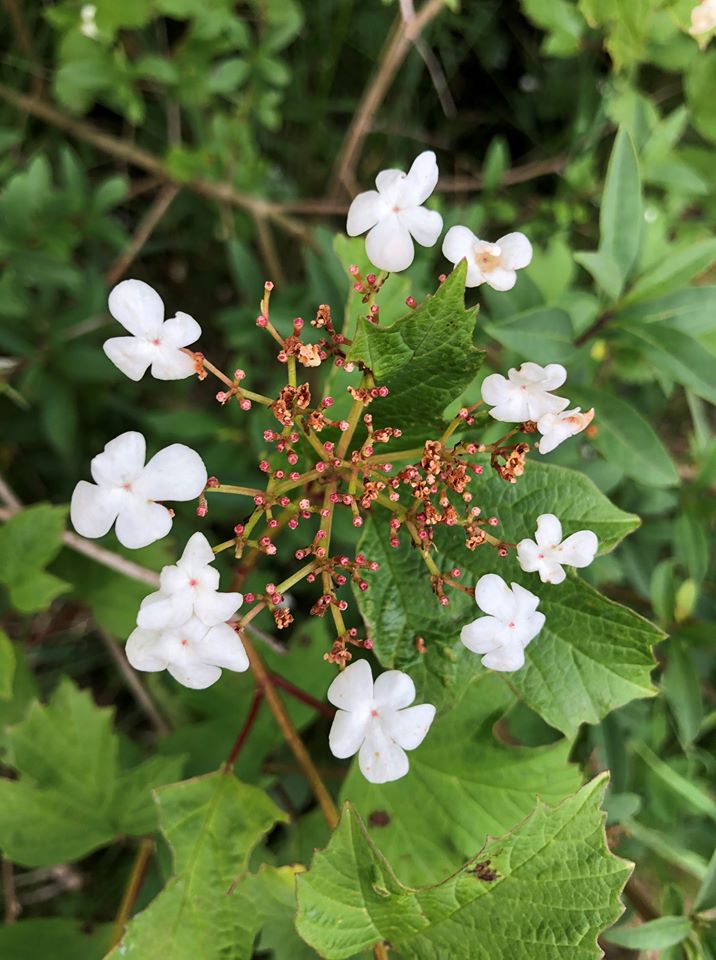
Day 71- St. John’s Wort
This is the cultural and ecological time of St. John’s Wort or Beathnua in Irish, very much associated with midsummer and St. John’s eve on the 23rd June. Hypericum – it’s scientific name derives from the Greek “over an apparition” hinting at its apparent supernatural properties which transcend cultures and languages. McCoitir notes that it is one of the seven herbs in Ireland that nothing natural or supernatural could injure.
It is a sturdy stalked little plant, with dainty yellow flowers, red buds and red sap. The dominant red may be one of the reasons why it was considered useful for staunching bleeding, and as a remedy for sore eyes. It is also effective against depression and is still sold as a preparation in health shops. It used to be said that to be fully effective for any remedy that it should be pulled at noon on a bright day near a full moon.
It is very much associated with St.Colmcille and a story from Scotland where he advised a young frightened boy to place Hypericum under his armpit to provide comfort, is said to have led to a tradition of fixing bunches of the plant under a persons’ oxter. (Ulster and Scottish word for armpit).
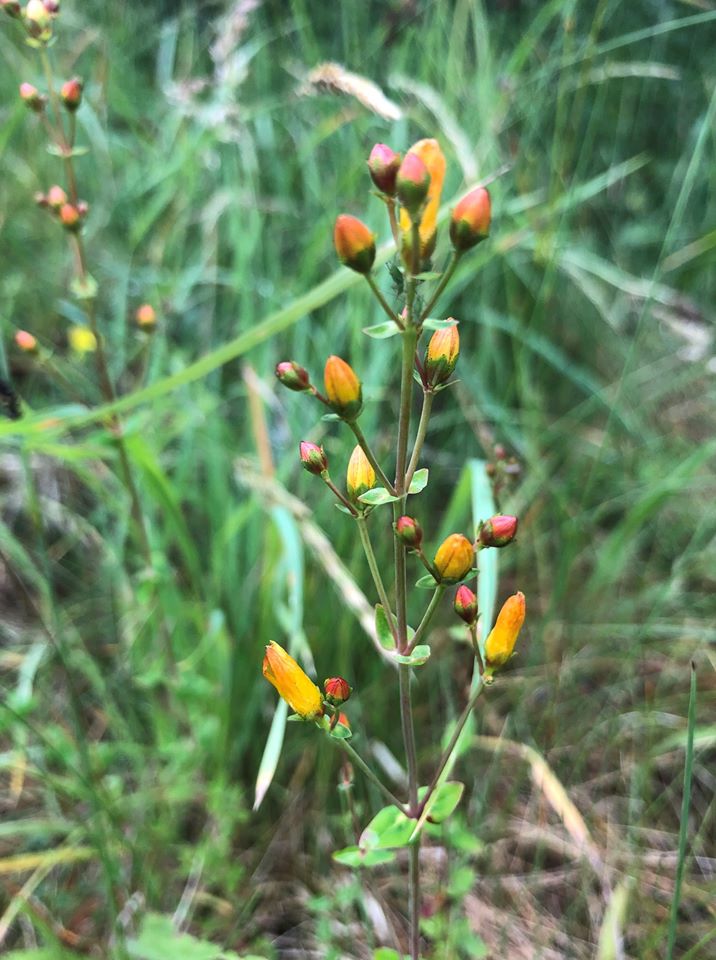
Day 72: Birds-foot trefoil
This delightful member of the pea or legume family, would in theory go well with peas and chips, with its bright free-range-egg-yolk-yellow flowers. Blooming in grasslands now, Birds-foot trefoil can survive all manners of abuse – drought, trampling and grazing, which is why it provides good food for sheep in upland and limestone areas. Its adaptability is partly due to it being able to send down tap roots and stems across the ground surface.
Its name derives from its black pea pods which resemble bird’s claws, but so too do its flowers if you think of birds with bright yellow talons of course. Another name for it “lady’s boots” or “lady’s slippers” refers to its silken flowers.
In Irish it is Crobh éin, meaning Claw of birds. In Ulster it is sometimes called Claver, which may be a local pronunciation of clover. Its scientific name is Lotus corniculatus. Lotus comes from the Greek, denoting a type of trefoil or clover. Although its leaves may appear trifoliate, they are in fact not, however the seed pods may hold the key here. Homer described lotus as a food for horses.
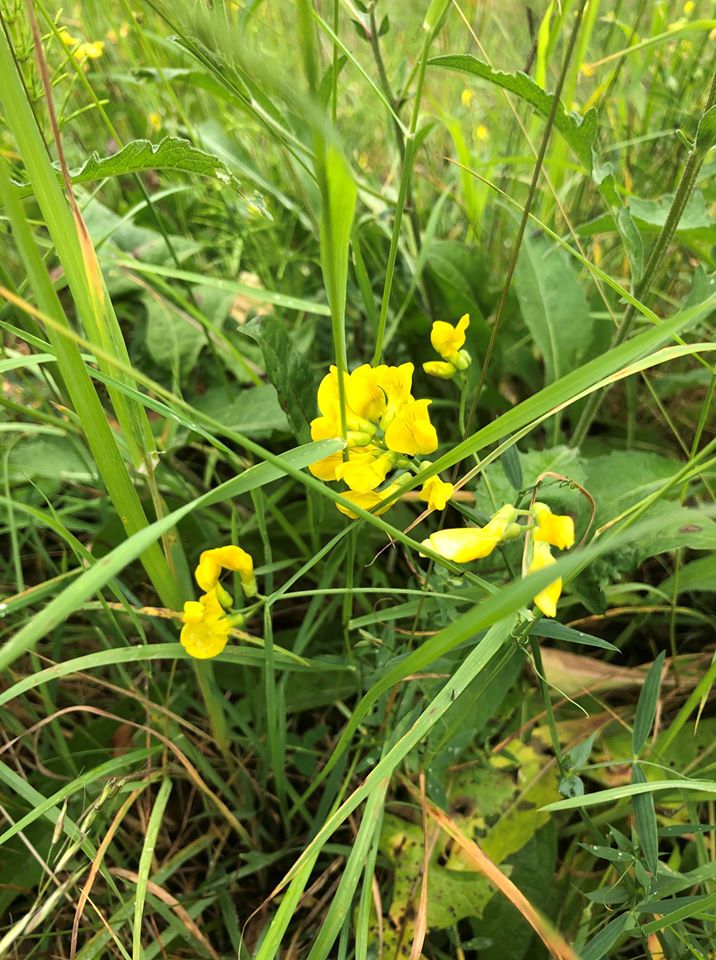
Day 73- The Worm Ditch palisade
The Worm Ditch or Claí na Peiste or Black Pigs Dyke – so many names; appropriately for a mysterious monument that guards its secrets well. The main elements were constructed in the middle Iron Age, about 2,200 years ago across our drumlin landscape. This linear earthwork which is 23m wide is comprised of two pairs of banks and ditches, as you would find around a well-constructed hill fort, and a palisade or fence.
The palisade is now a memory held in the charcoal remains that are found about 1m out from the northern bank, running in a parallel imprint showing evidence of intense burning. The palisade slots have been found in a small number of excavations and on geophysical surveys. In one section it has been traced continuously for 73metres, and it has been found in three locations at Aghereagh West, Lattacrossan and Aghnaskew. The charcoal from the burnt remains are dominated by oak and in lumps large enough to be considered the remains of heavily burnt posts. The trees themselves are dated to a few hundred years older than the fences construction.
Assuming the palisade is continuous along the Worm Ditch in the Scotshouse area, this would give the feature a length of 2.6km. That is a very long fence. Good fences make good neighbours, so they say, but this one was burned down right into the ground, using brushwood like willow as kindling later in the Iron Age.
The relative closeness of this monument to Clogher, now in County Tyrone and Emain Macha, now in County Armagh, both of which were high status royal sites in the Iron Age suggests that the Worm Ditch area was under their influence or sway.
The publication of an archaeological monograph about this wonderful site is in development by Monaghan County Council led by Cóilín O’Drisceoil and Aidan Walsh. It will be published later in the year by Wordwell, funded by the Heritage Council.
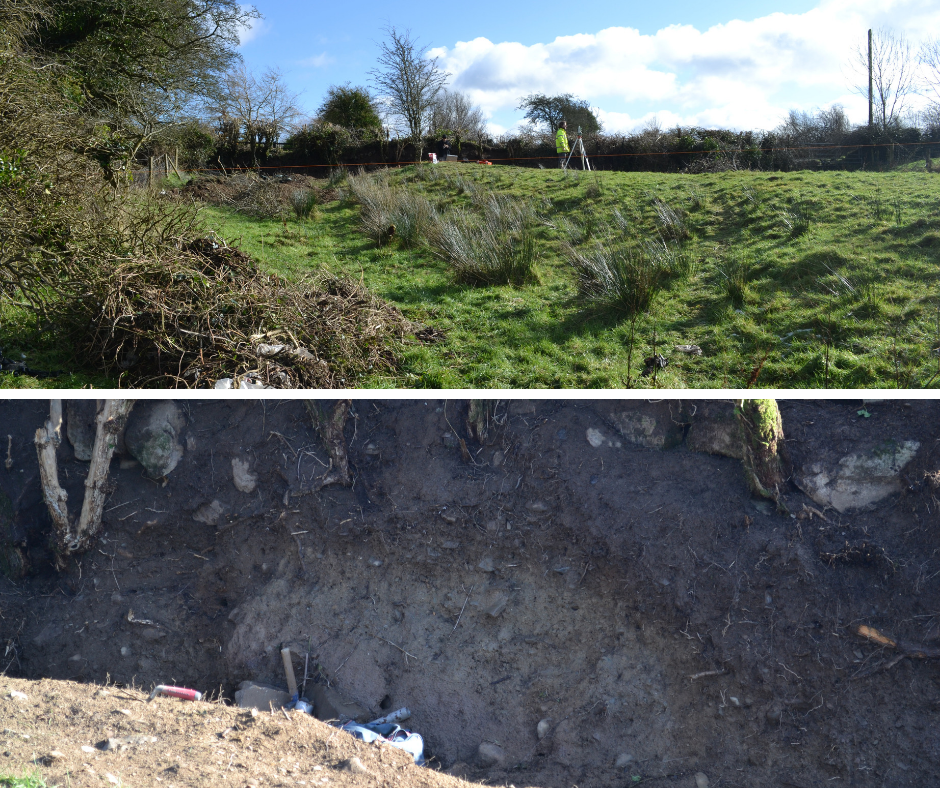
Day 74- Cattle grazing for nature
Dexter cattle are now employed on areas of Sliabh Beagh as conservation grazers to munch away at the unwanted scutch grass. These little black, red or dun animals, half the size of a Hereford, originate from the Kerry mountain cattle and are the smallest European breed.
They get their name from a “Mister Dexter” who came to the parish of Dundrum in Tipperary as a farm manager in the 1700s, and developed the breed from the Kerry cattle through careful selection. Their non-Irish name hides their Irish ancestry as they are a fully native breed, said to be descended from the ancient tribes of Ireland’s black cattle.
They are adapted to mountainous habitats, and not hard on the land so perfect for the job of minding the uplands through grazing on a variety of grasses and plants, where they do thrive and fatten. Once they were known as the cottier cow, as they were easily kept on the cottier acre and provided milk and an annual calf. The cows are renowned as good mothers, and will hide their calves, if they have cover, a way of protecting them from predators. The milk is similar to jersey milk, and beef is sweet and slightly nutty to taste.
There are only 2,000 Dexter cattle in Ireland. Hopefully, this new approach to managing the vegetation on Sliabh Beagh will be a win-win for the farmer and nature. Scutch grass becomes rank and a fuel load if not cut or grazed, thus adding risk to the mountain from fires. Grazing with light animals like Dexters is the gold standard for conservation on this habitat.
It is terrific to see this approach being taken, with the co-operation of many partners who all want to achieve good nature and livelihood outcomes on Sliabh Beagh.
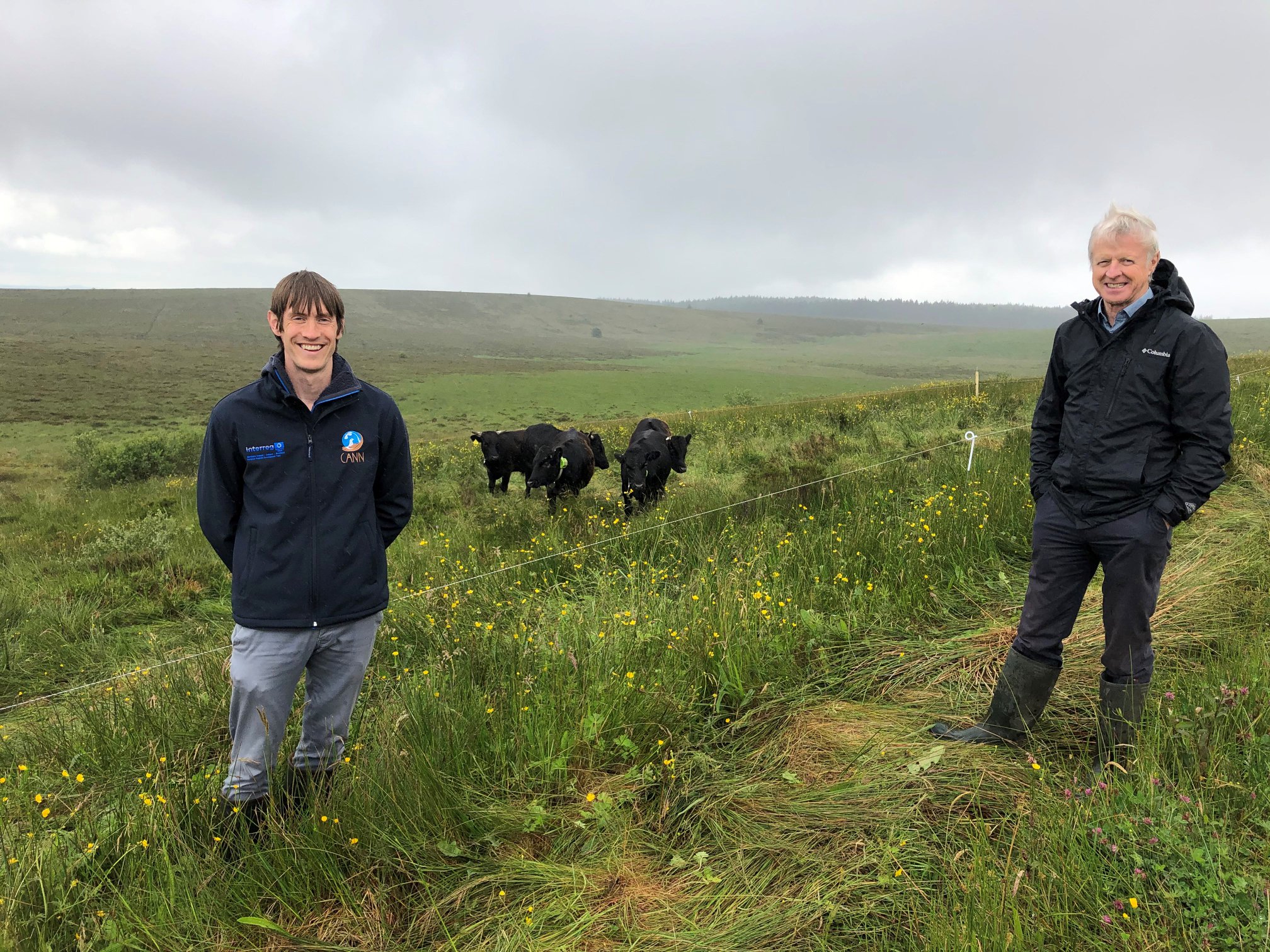
Day 75- National Heritage Week
Heritage Week this year is centred around learning from our heritage, how we can share our knowledge with others and even how scholorship has informed our understanding in the past.
We all have something of value, maybe its is a story about our locality or townland that intrigues us about the landscape; perhaps we collect information about local history or record plant species each year as they come into flower; maybe you are a dab hand at stone wall building, hedge laying or lace making. We participate in many heritage related practices all the time without even realising it.
So, maybe this year, might you have time to share with others a little of your knowledge?
There is helpful information on the heritage week website on how you can participate in this nationwide gathering for heritage. We can act together, even though we still are abiding by social distance guidelines, by following some of the suggestions offered by the Heritage Council.

Day 76- Impacts on the heritage sector from Covid-19
Heritage can sometimes be hidden. It is so much part of our lives, that it may not cost us a second thought so to speak. The historic buildings that frame our places are always there. The monuments in our landscape, in the fields, on top of drumlins have hung on for centuries and seem immovable parts of our places. The trees and hedges we drive past seem unchanged. The wetlands appear to be full of water and wildlife. But, appearances are deceptive and evidence shows that all these assets are being eroded away.
The heritage sector is a very broad church, and before the pandemic hit was not well resourced. During the shut-down many people found heritage again after perhaps a period of dis-engagement and became aware of how it frames and adds to our lives and livelihoods.
Those that work in the sector are beavering away – counting species, doing habitat surveys, recording archaeology, exploring new theories and discoveries about old monuments, assessing old buildings and the most sensitive way to repair them, delving into old maps, assessing the impacts of proposed developments on our environment and heritage, conserving manuscripts, cataloguing and archiving valuable historic documents. It all seems as before.
But is it?
The Heritage Council has undertaken a survey to find out what are the actual impacts, and they are presented on this useful infographic.
The Heritage Council and the Heritage Officers at a local level will continue to advocate for heritage resources, the heritage sector and the benefits of increased engagement and presence of heritage assets in our lives.

Day 77- National Heritage Week and how to get involved
The Heritage Officer with Monaghan County Council, Shirley Clerkin explains how you can get involved in #NationalHeritageWeek this year.
#MyHeritageWeek #monaghan
#NationalHeritageWeek is in August & the local authority heritage officers encourage you to take part in whatever way you can. @MonaghanCoCo @HeritageWeek @HeritageHubIRE @HousingPress @Dept_CCAE @DeptAHG pic.twitter.com/jteSF9NVrd
— Monaghan Heritage (@MonaghanHerita1) July 6, 2020
Day 78: My Nature Home for Heritage Week
“My Nature Home” is a new initiative that asks people of all ages to imagine a happy future with nature. It is a visioning project, to help us talk about our relationship with nature “within the habitat of the heart”. Inspired by writer Richard Louv and his writings on nature deficit disorder and vitamin N (nature), this project is about expressing a positive future for us with biodiversity at its core.
Monaghan County Council Heritage Office wants to help create a different vision for ourselves other than the dystopian present we so often seem to inhabit. There is no doubt that biodiversity or nature is in crisis. The OECD recognises that “biodiversity loss is one of the greatest risks of the 21st century. It undermines human health and well-being”. In order to feel empowered to do something about this crisis, we need to be able to express a different future than the one which only describes the downward nature spiral.
The Heritage Office are inviting children of all ages, from 0 to 100, to share your vision of how you imagine your home in a happy nature. A specific email address has been established for submissions at: mynaturehome@monaghancoco.ie . Visions can be drawings, paintings, collages, poems or photographs which describe how you would like to be with nature in the future.
These visions will be compiled together to make a YouTube video on the Monaghan County Council channel to share during National Heritage Week and beyond. Closing date for entries is the 10th August 2020.
Shirley Clerkin, Heritage Officer commented that “Imagination is one of our human characteristics that enables us to innovate and to create futures for ourselves. We are asking children and people of all ages to imagine what a positive future with nature could be like. Having empathy with animals and plants is a good place to start building a caring relationship with nature. During lock-down, the demand to get into the outdoors increased, demonstrating its benefits for our mental and physical well-being. People are shocked to learn how under threat Ireland’s nature is, we need to turn the downward trends around and build advocacy and care for our nature home”.
Heritage Week in 2020 is not event led as in previous years. Due to COVID-19-related restrictions on social gatherings, this year, rather than inviting communities to host Heritage Week events, the Heritage Council is inviting communities around the country to undertake projects that explore a topic associated with this year’s theme – ‘Heritage and Education: Learning from our Heritage’. Heritage Week is coordinated by the Heritage Council and supported by the Local Authority Heritage Officers.
